Panasonic of North America 9TGCF-P21 Handheld Computer CF-P2 User Manual CF P2
Panasonic Corporation of North America Handheld Computer CF-P2 CF P2
Contents
CF P2 User Manual
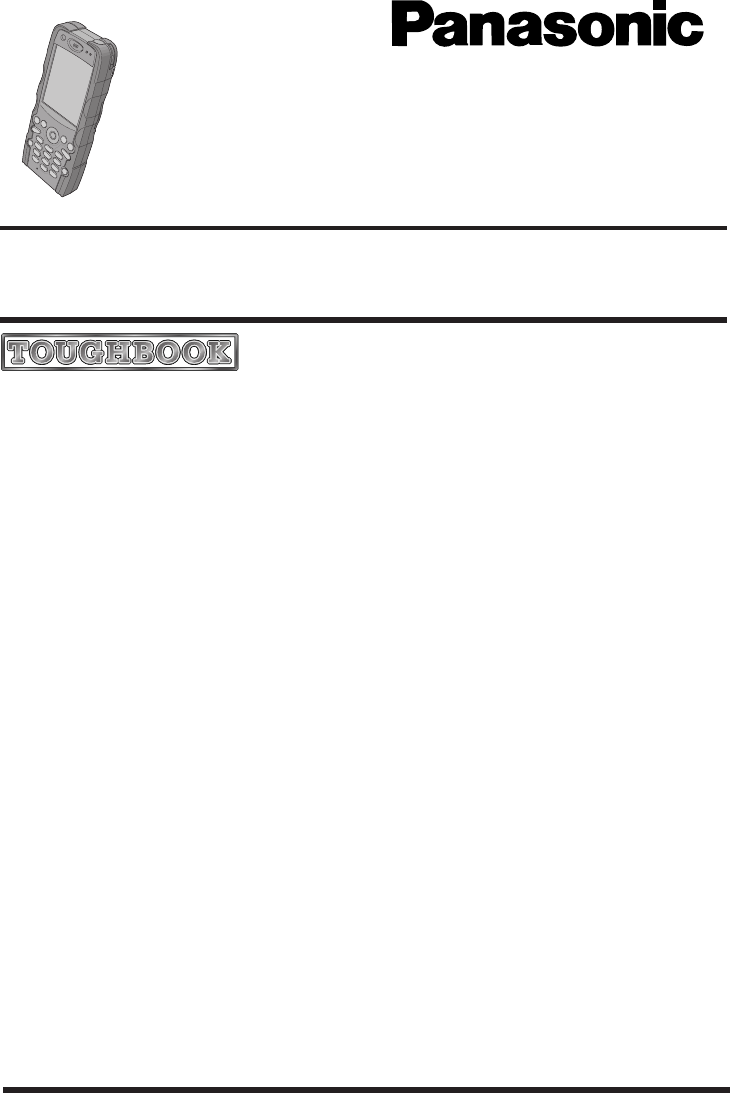
Please read this instructions manual carefully before using this product and save this manual
for future use. Refer to the provided Safety Precautions regarding precautions for this com-
puter.
OPERATING INSTRUCTIONS
Handheld Computer
®
Model No. CF-P2 Series
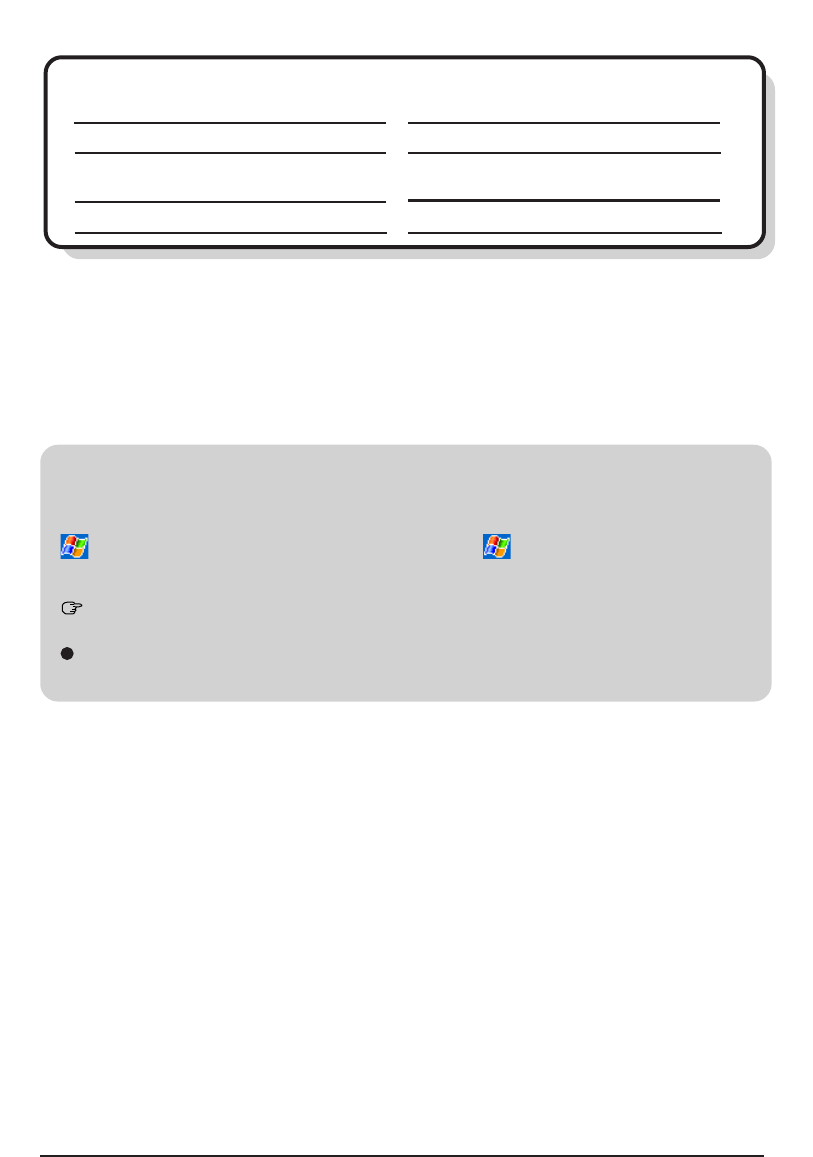
2
Customer's Record
Serial No.
or
Model No.*
Code No.
Dealer's Name
Dealer's Address
Date of Purchase
*For the Model No., insert the 12 digit number (for example, CF-P2T1FDF7E) located on the back of
the computer.
NOTE:NOTE provides a useful fact or helpful information.
CAUTION:CAUTION indicates a condition that may result in minor or mod-
erate injury.
- [Programs]: This illustration means to tap at the top of the screen, then to
tap [Programs].
: Where to go for referred information.
Some of the illustrations in this manual may differ slightly in shape from the actual
items in order to make the explanation easier to understand.
Introduction
Thank you for purchasing the Panasonic Handheld Computer. Read the operating instruc-
tions thoroughly for proper operation of your new computer.
Illustrations and Terminology in this Manual

3
Contents
Operation
Starting Up/Shutting Down ................................... 12
LCD (Touchscreen)............................................... 17
Backlight Settings ................................................. 19
Entering Information ............................................. 21
Using T9® Text Input .......................................................... 21
Using the Input Panel ........................................................ 24
Using the Keyboard ........................................................... 25
Changing the Assignment of Program Buttons .... 26
Setting to Resume ............................................................. 26
Quick Menu........................................................................ 27
Battery Power ....................................................... 29
Remaining Battery ............................................................. 29
Setting for Auto Powering Off ............................................ 29
Replacing the Battery Pack ............................................... 30
SD Memory Card/SDIO Card/MultiMedia Card.... 31
Panasonic Backup ................................................ 32
Pocket Internet Explorer ....................................... 35
Connecting to Your Computer ............................... 36
Wireless Functions ............................................... 39
Changing the Wireless Power Status ................................ 39
Setting Up the Remote Network for GPRS ........................ 40
Connecting to Wireless LAN ............................................. 43
Connecting to Bluetooth Devices ...................................... 49
Dialer and Telephony ............................................ 53
Customizing the Computer ................................... 58
Troubleshooting
Dealing with Problems .......................................... 61
Resetting Your Computer .................................................. 61
Troubleshooting ................................................................. 62
Diagnostic Tool .................................................................. 65
Getting Started
What’s in the Box? .................................................. 4
Names and Functions of Parts ............................... 5
First-time Operation ................................................ 9
Appendix
For Effective Use .................................................. 67
Specifications ....................................................... 68
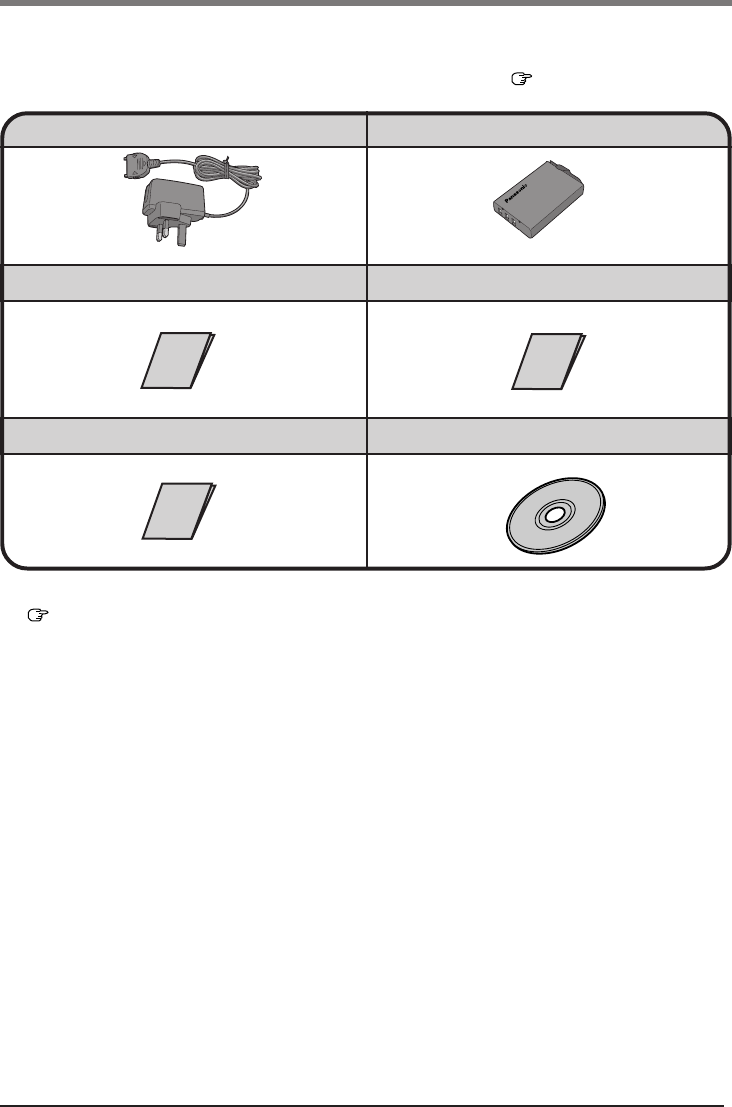
4
What’s in the Box?
Make sure the parts shown in the figure have been supplied. If any of these items is missing
or is not working properly, contact Panasonic Technical Support.
Make sure the provided stylus has been stored to the computer ( page 17).
*
1 You can use the Companion CD to install various software, including Microsoft® ActiveSync®
( page 36).
Fast Travel Charger ......................... 1 Battery Pack .................................... 1
Model No: CF-VZSU33
License Agreement
............................ 1Safety Precautions ......................... 1
Model No: EB-CAD95UK
Companion CD*
1
................................ 1End User License Agreement ........ 1
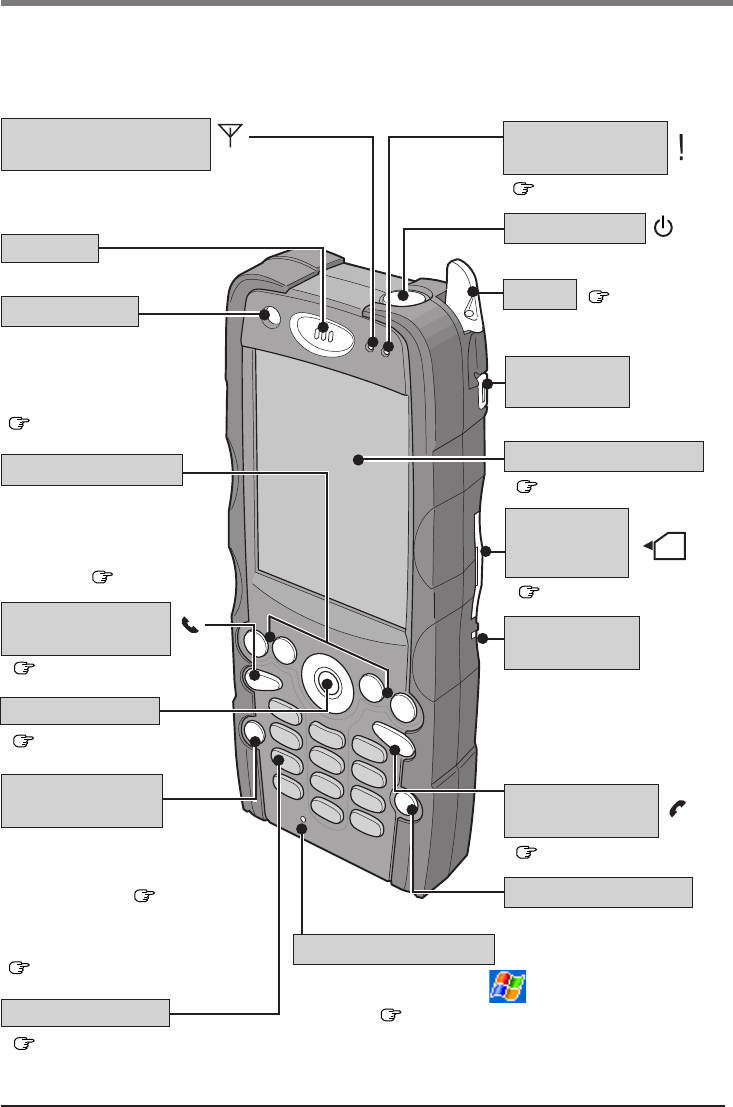
5
Names and Functions of Parts
The illustrations shown may differ from the actual physical appearances.
For detailed settings, tap - [Settings] - [System] tab
- [Audio] ( page 59).
Power Switch
( page 18)
LCD (Touchscreen)
By pressing the program
button, the program as-
signed to the button is
started up ( page 26).
( page 17)
Stylus
Wireless Power LED
Indicator
Notification LED
Indicator
( page 31)
When wireless power is on, LED
indicator is blinking green.
SD Card LED
Indicator
When the SD card or
MultiMedia card is ac-
cessed, LED indicator is
lighting green.
Backspace Button
Internal Microphone
Light Sensor
Brightness of backlight
changes according to
level of ambient light
( page 19).
Turns GSM/GPRS(Phone) or
Wireless LAN or Bluetooth
power ON/OFF ( page 39).
This button also functions as
one of the program buttons
( page 26).
Wireless Power
Button ON Hook (End)
Button
( pages 53)
( page 7)
SD Card/
MultiMedia
Card Slot
Receiver
Program Buttons
Cursor Control
( page 8)
OFF Hook (Talk)
Button
( pages 53)
SD
Accessory
Connector
( page 25)
Numeric Keypad
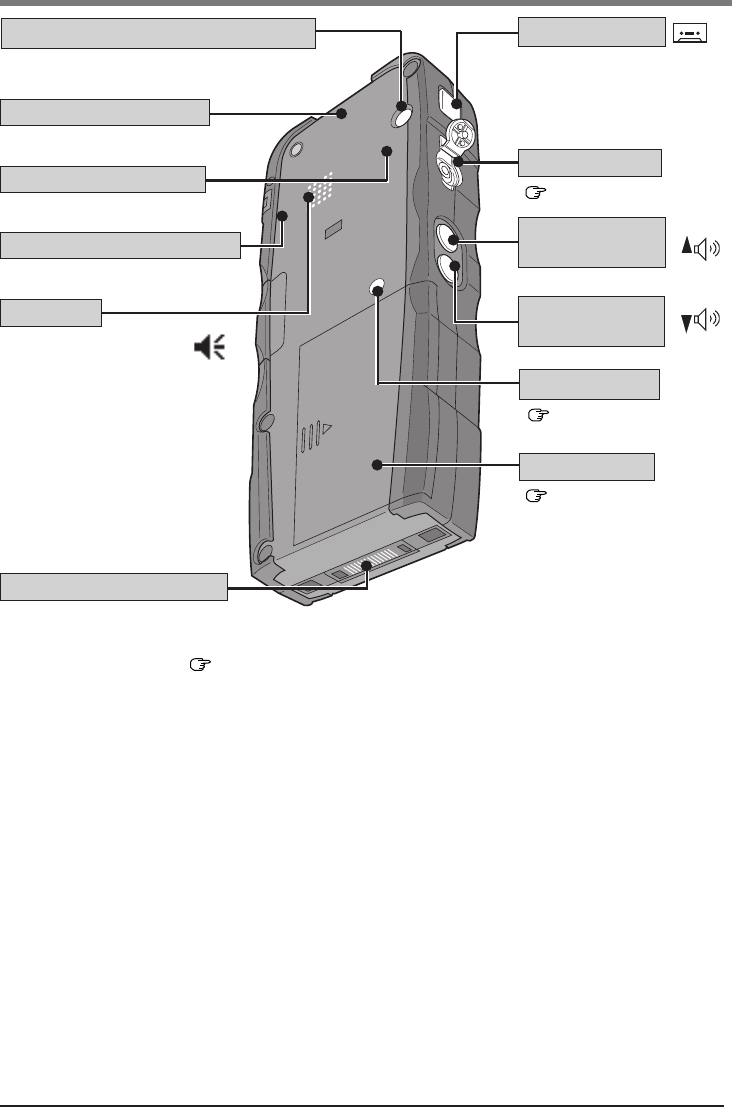
6
( pages 9, 30)
You can connect CF-P2 directly to the
Fast Travel Charger, or the computer
using the proper cable ( pages 10, 38).
Names and Functions of Parts
Battery Pack
Headset Jack
Record Button
GSM/GPRS Antenna Connector
Reset Switch
GSM/GPRS Antenna
( page 8)
( page 61)
Expansion Connector
Volume Up
Button
Used for a car mounter (optional)
connected to CF-P2.
Can be recorded
while pressing this
button.
Volume Down
Button
RESET
(built-in)
To adjust the volume, tap
on the navigation bar, or press
the Volume Up/Down But-
tons.
Bluetooth Antenna
(built-in)
Wireless LAN Antenna
(built-in)
Speaker
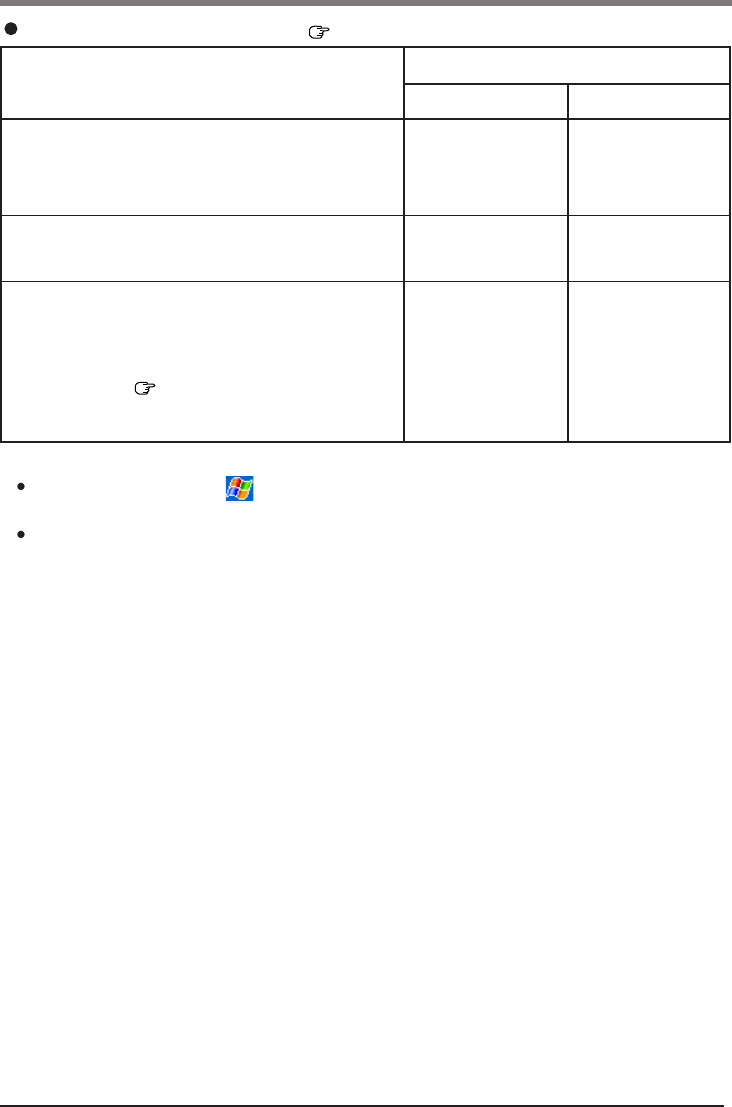
7
Names and Functions of Parts
Status
Not connected to the Fast Travel Charger
or unable to recharge outside the allowable
temperature range.
Connected to the Fast Travel Charger
(No charging)
• Connected to the Fast Travel Charger
• Connected to USB cable, and add a
check mark for [Supply power from PC by
using USB] ( page 29).
(Charging in progress)
Notification LED Indicator
None
Not lit
Green
Orange
Given*1
Blinking Green
Blinking Green
Blinking Orange
( page 5)
Notification
*1Examples of notification are shown below.
When the alarm is set in - [Settings] - [System] tab - [Clock & Alarms] - [Alarms]
tab and the alarm is ringing.
When you miss phone calls, etc.
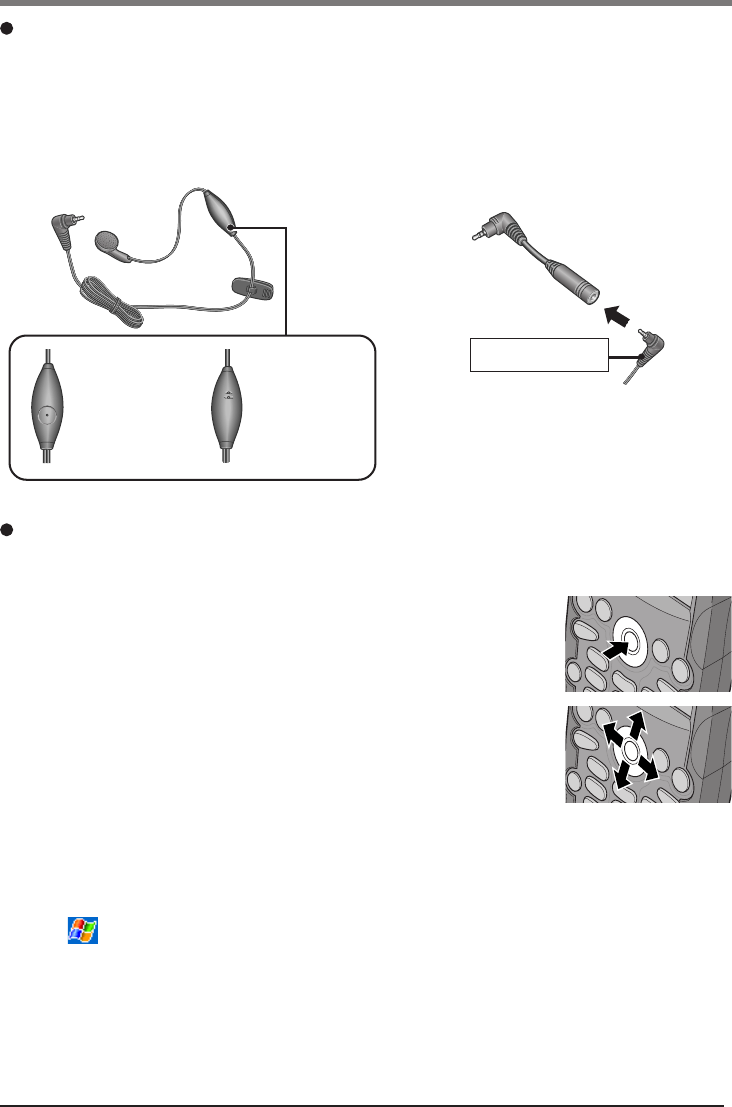
8
Names and Functions of Parts
Headset and 3.5 DIA plug adaptor
Only the CF-VHSP11W (sold separately) can connect to the headset jack.
CF-VHSP11W includes A and B. When using a 3.5 DIA plug, B is required. This adaptor
can be connected to stereo headphones.
Audio output from the internal speaker is disabled when the headset or the 3.5 DIA plug
adaptor is connected.
*1Answer switch Microphone
Front Back
3.5 DIA plug
A. Headset B. 3.5 DIA plug adaptor
*1 Press for about one second to answer/
hang up voice calls. Function will not
operate if the switch is not pressed
long enough.
Using the cursor control, the following operations can be performed.
“Press Center” Operation:
Executes a selected item from a menu, or a selected icon. For
example, after an item within a menu is selected, center of the
cursor control can be pressed to execute this selected item.
“Press Up/Down Right/Left” Operations:
Performs the same function as the up/down right/left cursor
control. For example, the “Press Up” operation can be performed
to select an item towards the top within a menu.
Changing the Cursor Control Settings
The cursor control settings allow you to adjust the interval between the waiting time until the
repetition of an input begins (from the first input to the second input) if the cursor control is
held down, and the repeat of the input (from the second input and on).
1
Tap - [Settings] - [Personal] tab - [Buttons] - [Up/Down Control] tab.
2
Customize the way your cursor control repeats.
3
Tap [ok].
Cursor Control
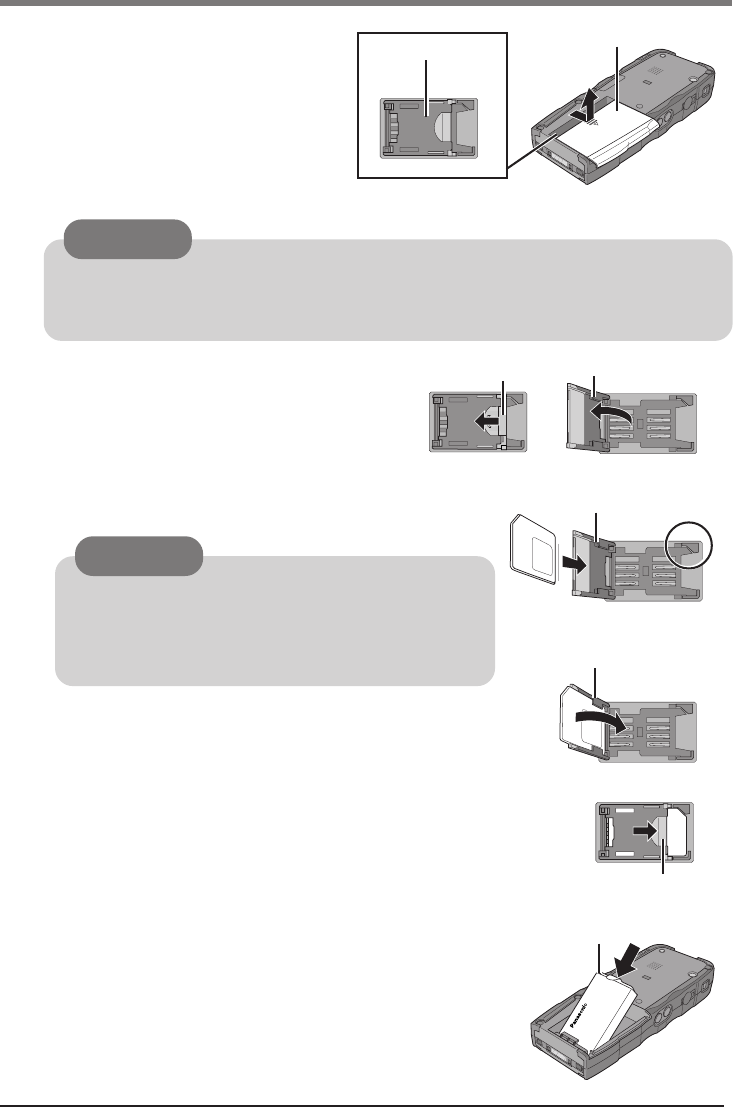
9
1
Turn your computer over and
slide the battery pack cover to
remove it.
(2) Insert the card all the way into (A). Make sure that the
beveled corner of the SIM card matches up with (B).
(3) Snap (A) into place by pushing down on it.
(4) Slide the Latch in the direction of the arrow to lock.
First-time Operation
Battery Pack Cover
2
Install the SIM card.
(1) Unlock the Latch and open (A).
CAUTION
Insert with care, because if the SIM card is not in-
serted correctly, the computer will not operate, and
the SIM card may be damaged by contact with the
battery.
SIM Card Slot
(A)
(B)
3
Install the battery pack.
(1) Hold the battery pack so that the name “Panasonic” is fac-
ing upwards and the tab (C) is placed as shown at right,
and put the battery pack into the computer so that the bat-
tery connector and the CF-P2 connector match up.
Latch
(A)
(A)
(C)
Latch
CAUTION
The contacts of the SIM card slot are extremely sensitive to static electricity. When
inserting or removing a SIM card, do not touch the contacts. Doing so has been
known to cause damage or electric shock.
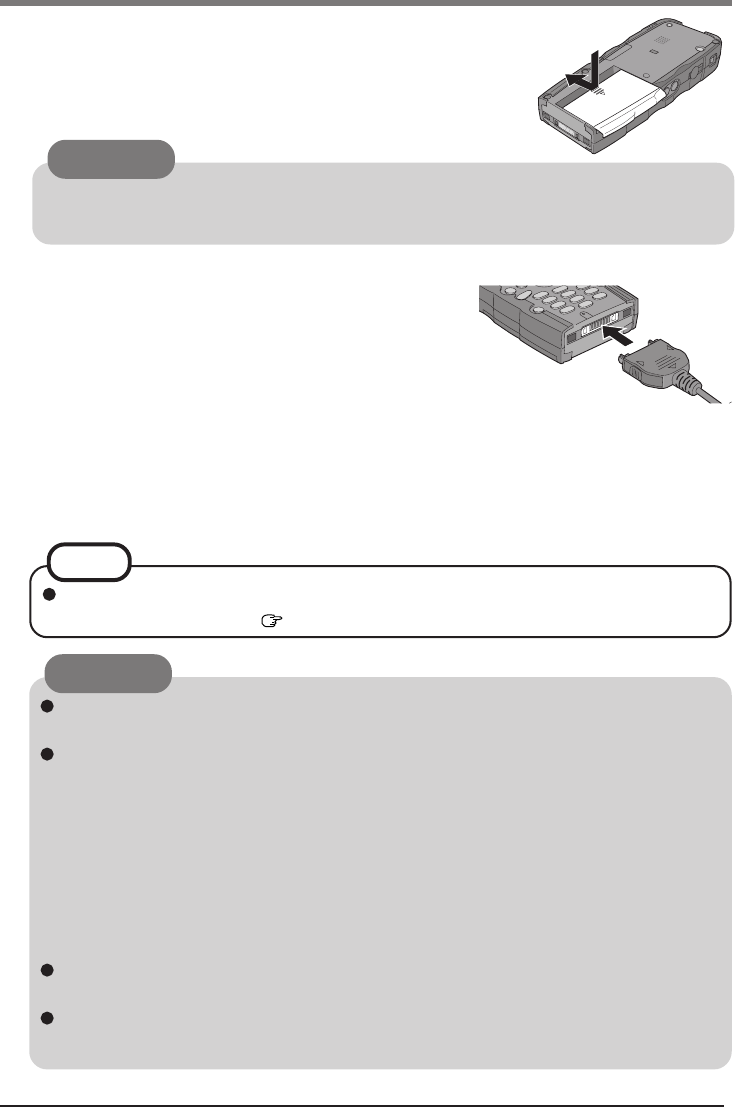
10
NOTE
When the backup battery or main battery becomes low, some alert messages and
icons will be displayed ( page 14).
Do not remove the main battery before the backup battery is fully charged. Other-
wise, data in RAM will be lost.
Take care to ensure that the remaining power in the main battery and the backup
battery never discharges completely.
When any remaining power discharges completely, the computer will no longer
function properly, and the computer powers off automatically. Connect the Fast
Travel Charger and recharge the battery. If the computer is left for 72 hours or more
without recharging, the computer may be fully reset. When the computer is fully
reset, all user-added data except for Flash Storage will be lost. The computer will be
returned to the condition at the time of purchase except for Flash Storage.
Handling the Fast Travel Charger
Do not twist or pull the Fast Travel Charger cord forcefully. Otherwise, the connec-
tions will be damaged.
Use only the provided The Fast Travel Charger with your computer. Using a charger
other than the one provided might damage the battery and the computer.
CAUTION
First-time Operation
4
Connect your computer to a power outlet.
Connect the Fast Travel Charger to CF-P2 with arrow
marks facing up. Charging begins automatically.
Charging Time:(Power Off) Approx. 4 hours
(Power On) Varies depending on
the usage conditions.
This computer is equipped with a memory backup battery which automatically charges
from the fully-charged lithium-ion battery (main battery). This backup battery retains
data in memory when the lithium-ion battery is removed, and takes 24 hours to charge
when you first use this computer.
(2) Set the cover in place and slide it in the direction indi-
cated by the arrow to close.
CAUTION
After changing the SIM card and inserting the battery pack (except for first-time op-
eration), reset the CF-P2.
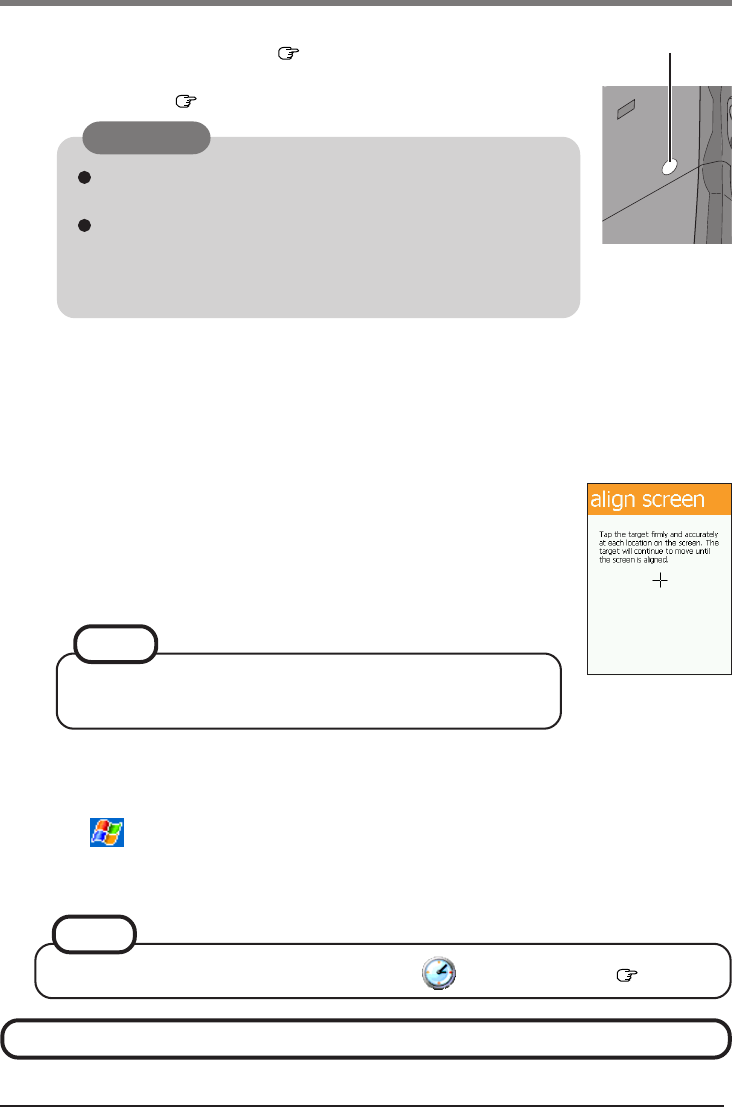
11
5
Turn your computer on
(1) Using the provided stylus ( page 17), push the center of the
reset switch straight in for 1 second while holding down on the
power switch ( page 12).
(2) Tap the screen to set up your Pocket PC.
The Windows*1 alignment screen is displayed.
*1 This computer uses Microsoft® Windows MobileTM 2003 Second Edition Software
for Pocket PC, Premium with Phone Edition.
(3) Align the touchscreen.
(For alignment, tapping operations are required. For informa-
tion on tapping, refer to page 17.)
"+" is displayed in the center, upper left, lower left, lower right,
and upper right portions of the touch screen, in that order. Each
time the "+" mark is displayed, tap the center of the "+" mark
with the stylus.
(4) At [complete], tap the screen to begin using CF-P2.
6
Set the time and date
(1) Tap - [Settings] - [System] tab - [Clock & Alarms].
(2) Set the time zone, time and date.
(3) Tap [ok].
Reset Switch
This concludes the first-time use operation guidelines.
NOTE
You can also set the date and time by tapping on [Today] screen ( page 15).
When the battery pack is not fully charged, if the Fast Travel
Charger is connected, CF-P2 may not turn on.
Use only the provided stylus to push the reset switch.
Do not push the reset switch with any other sharp-pointed
objects, i.e. pencils, and ball point pens. The reset switch
or other parts may become damaged.
CAUTION
First-time Operation
NOTE
In this operation, the "+" mark may not move smoothly. This
is not a malfunction. Continue the operation.
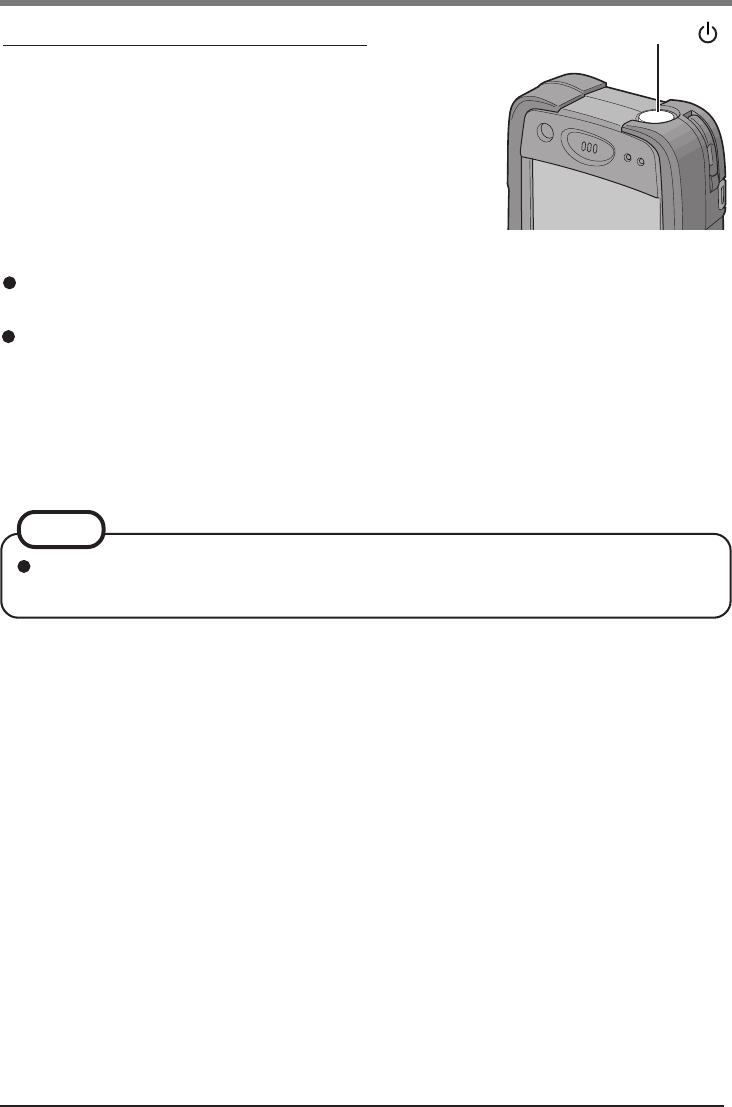
12
Starting Up (from the second time)
Lightly press the power switch once.
Programs and files that were previously displayed appear
on your screen.
Starting Up/Shutting Down
Power Switch
Power Switch
To turn the LCD backlight on/off:
Turn on CF-P2, and press the power switch until the LCD backlight goes on/off and release
the switch.
At the time of purchase, the brightness of the LCD backlight and the keyboard backlight
changes according to the level of ambient light. To change this setting, refer to page 19.
If the CF-P2 powers off while the backlight is off, the backlight will remain off when the
CF-P2 powers on again.
When the backlight is on, more power is consumed, and the battery operating time is
reduced.
NOTE
Lightly press the power switch (within 0.5 seconds) to turn on/off CF-P2.
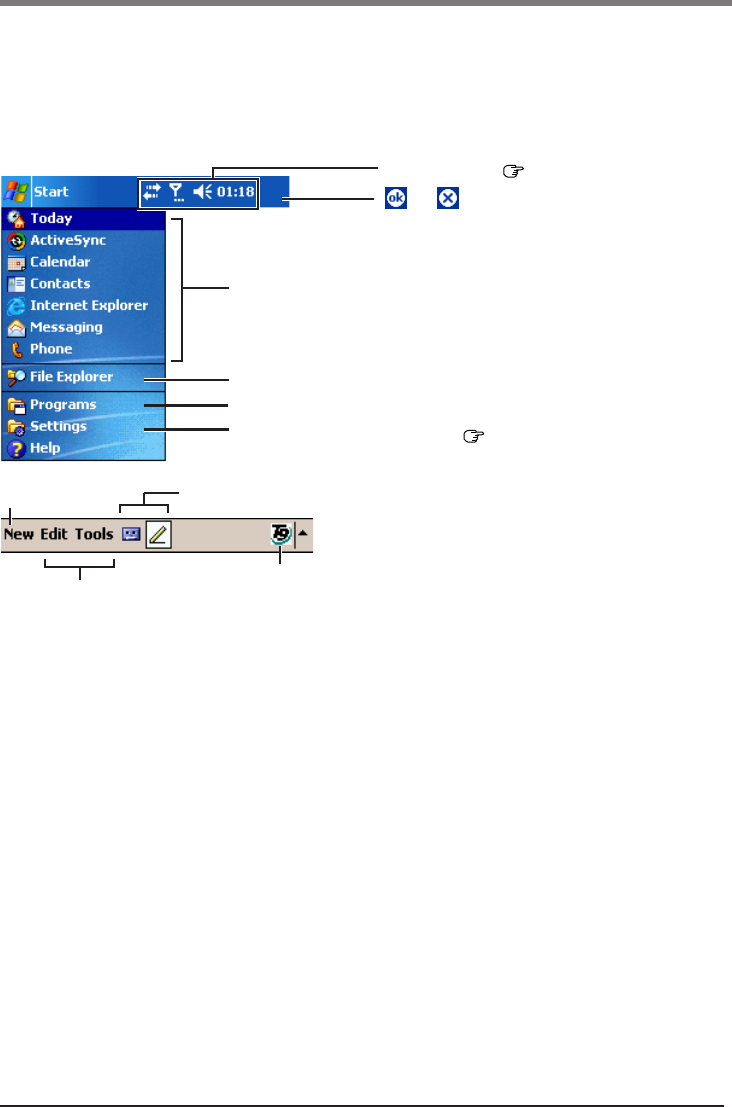
13
The Navigation Bar and Command Bar
The navigation bar is located at the top of the screen. It displays the active program and
current time, and allows you to switch to programs and close screens.
Use the command bar at the bottom of the screen to perform tasks in programs. The command
bar includes menu names, buttons, and the input panel button.
or may be displayed depending
on the program that is running.
Status Icon ( page 14)
New Button
Menu Names
Buttons (Example for [Notes])
Input Panel Button
Tap to quickly select a program you have recently used.
Tap to select a program.
Tap to see additional programs.
Tap to customize CF-P2 ( pages 58-60).
Starting Up/Shutting Down
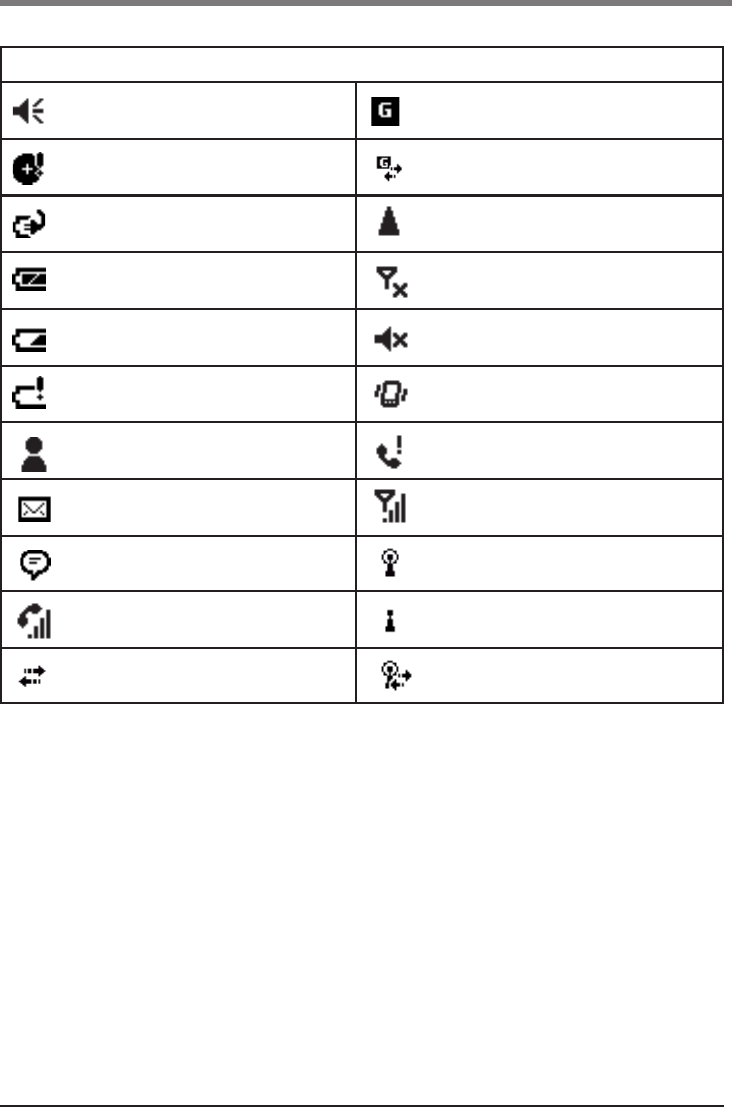
14
Following are some of the status icons you may see.
Turn all sounds on and off
Backup battery is very low
Main battery is charging
Main battery is very low
Main battery is low
Main battery is full
Status Icon & Meaning
Notification that one or more instant
messages were received
Notification that one or more e-mail
messages were received
More Notification icons need to be
displayed. Tap the icon to view all.
Starting Up/Shutting Down
Voice Call in progress
ActiveSync®/CSD Connection in
progress
Roaming
Radio off
Playing sound disable
GPRS available
GPRS Connection in progress
Vibrate ON
Missed Call
Full Signal Strength
Wireless LAN Connection in progress
Wireless LAN data call
Wireless LAN on
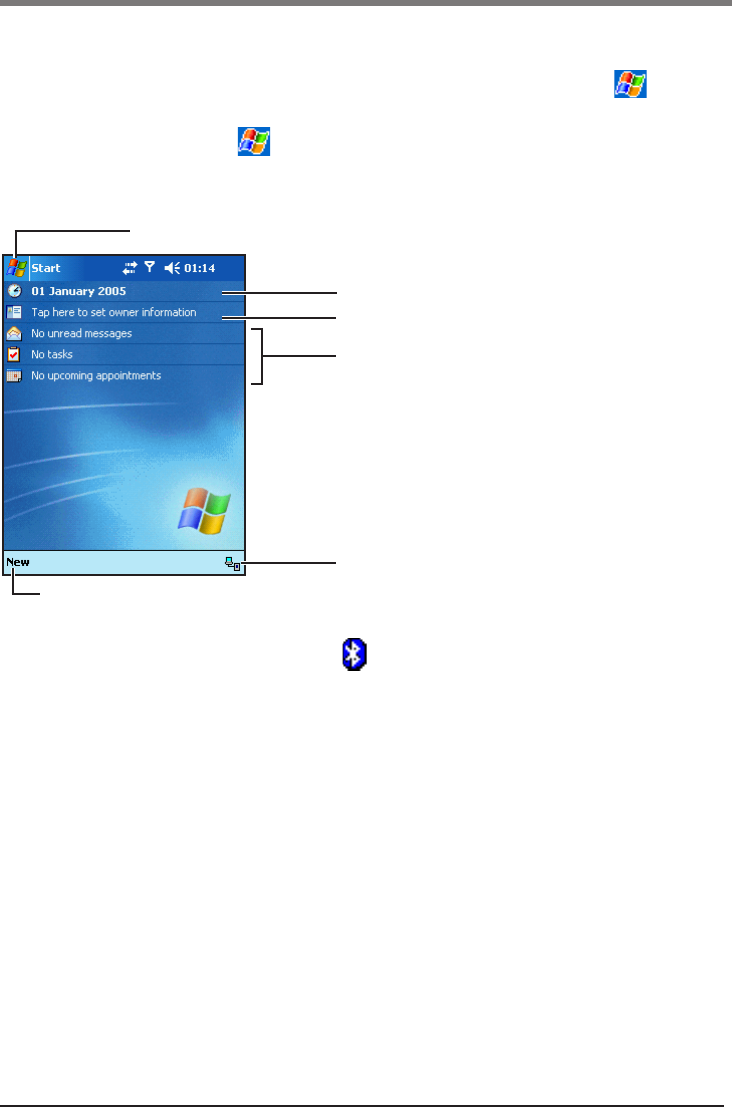
15
Starting Up/Shutting Down
Today Screen
You’ll see the Today screen when you turn on the computer for the first time each day (or
after 4 hours of inactivity*1). The Today screen can be displayed by tapping - [Today].
On the Today screen, you can see at a glance important information for the day.
*1To change the setting, tap - [Settings] - [Personal] tab - [Today] - [Items] tab.
Tap to switch to a program.
Tap to create a new item.
Tap to change date and time.
Tap to open an item.
Your day at a glance.
Displayed when synchronizing with a host
computer using Microsoft® ActiveSync®.
Tap to view connection status.
is displayed when Panasonic Bluetooth has
started.
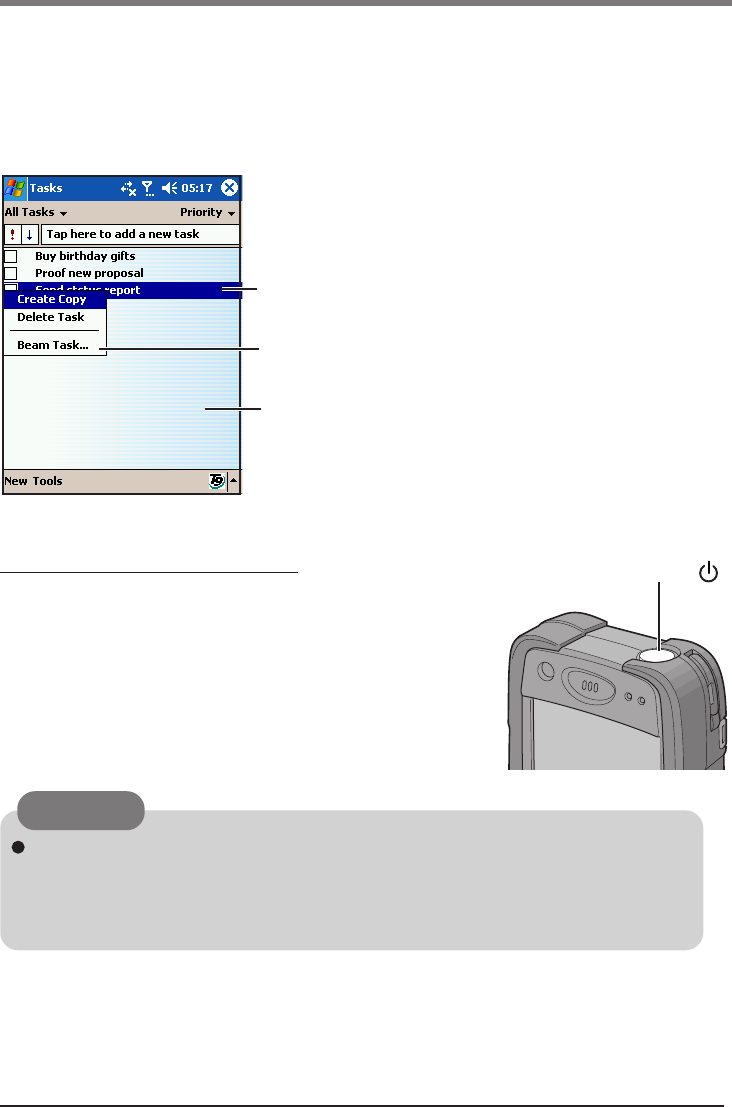
16
Shutting Down (power off)
Lightly press the power switch once (within 0.5 seconds).
CF-P2 shutdown is the same as the standby state of a com-
puter. (Standby state is a function allowing you to turn off
the power without closing applications. The settings before
the power was turned off are stored in the memory, so when
the power is turned back on, the screen is the same as it was
before the power was turned off (the same applications and
files are opened) and you can start working immediately.)
Check to see the SD card LED indicator if the SD card/MultiMedia Card is not
being accessed before turning off the power. If the power is turned off while the
card is being accessed, the data stored on the card may be damaged and the com-
puter may stop working properly.
Pop-up Menus
With pop-up menus, you can quickly choose an action for an item. For example, you can use
the pop-up menu in the contact list to quickly delete a contact, make a copy of a contact, or
send an e-mail message to a contact. The actions in the pop-up menus vary from program to
program.
(1) To access a pop-up menu:
Tap and hold to display the pop-up menu.
(2) Lift the stylus and tap the action you want to perform.
Tap outside the menu to close it without performing an action.
Starting Up/Shutting Down
Power Switch
CAUTION
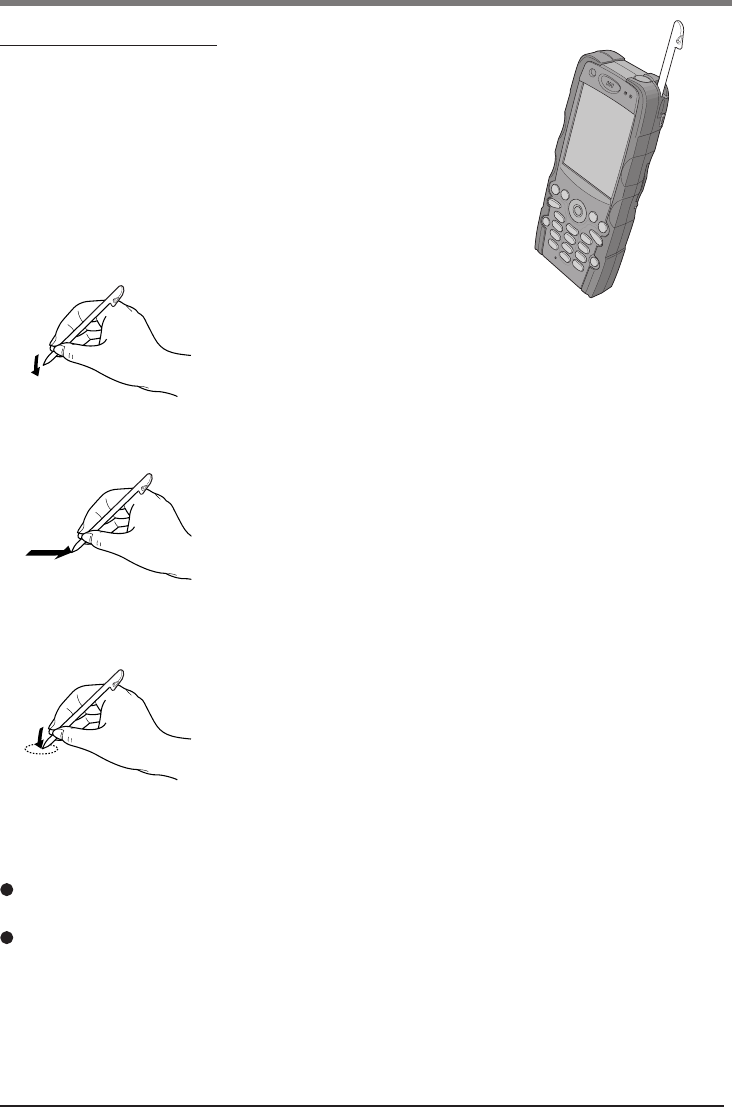
17
LCD (Touchscreen)
Using the Stylus
Use the provided stylus to perform operations on the
touchscreen. The stylus is located in the stylus holder at
the upper right of the computer, and can be held like a pen
or a pencil. The following operations are possible on the
touchscreen.
Tapping
You can select an item on the screen by tapping it with the stylus.
This operation is called a “tap”.
Dragging
You can drag on an item on the screen by holding the stylus down
over the item and then moving the stylus. This operation is called a
“drag”.
Clean the stylus tip and screen prior to operation. Foreign particles can scratch the screen
and impede the operation of the stylus.
Use the provided stylus only on the screen or when pushing the reset switch. Using it for
any other purpose may damage the stylus and scratch the screen.
Handling the Stylus
Tapping and Holding
You can tap and hold the stylus on an item to see a list of actions
available for the item. On the pop-up menu that appears, tap the
action you want to perform.
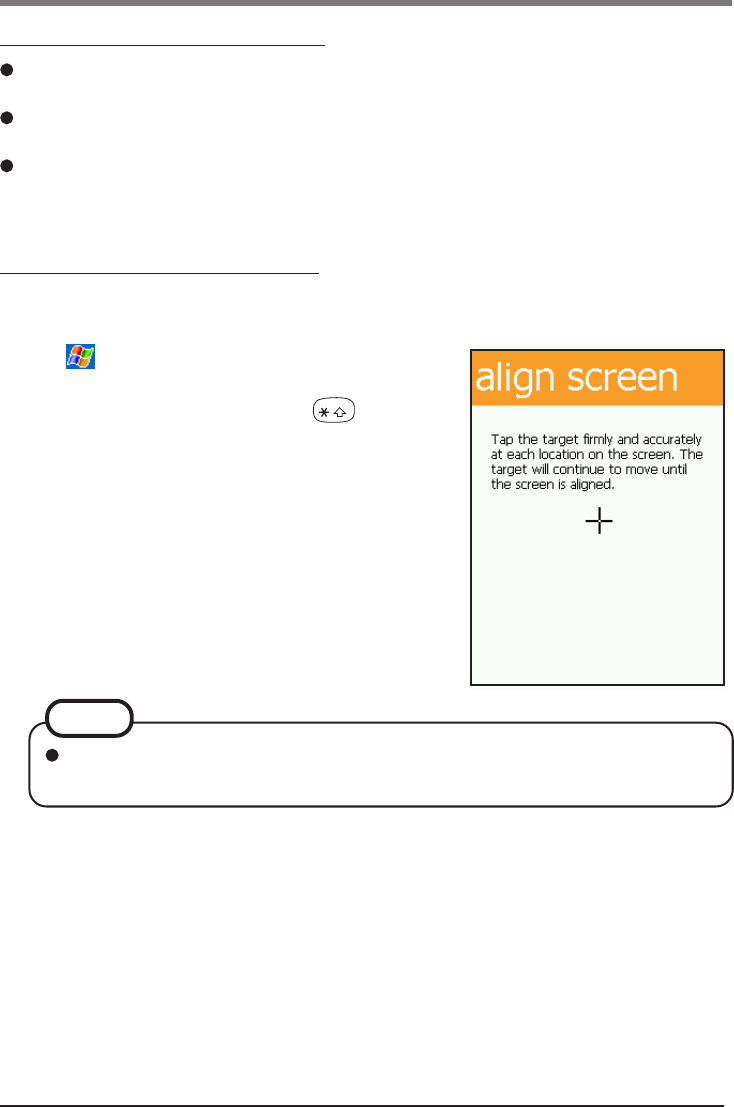
18
Align the touchscreen if the cursor does not correctly move to the position where the stylus
touches the touchscreen of the computer.
1
Tap - [Settings] - [System] tab - [Screen]
and tap [Align Screen].
You can also align the screen when + center
of the cursor control are pressed.
2
"+" is displayed in the center, upper left, lower
left, lower right, and upper right portions of
the touchscreen, in that order.
Each time the "+" mark is displayed, tap the center of
the "+" mark with the stylus.
The alignment procedure is executed after the five
"+" marks are touched.
Handling the Touchscreen
Use the provided stylus with CF-P2. Do not use an implement other than the stylus pro-
vided with the computer.
Do not place any object on the surface or press down forcefully with sharp-pointed objects
(e.g., nails), or hard objects that may become damaged (e.g., pencils and ball point pens).
Do not operate the computer when such things as dust are on the LCD. Do not allow
substances such as oil to contact the LCD. The cursor may not work properly in such
cases.
Aligning the Touchscreen
LCD (Touchscreen)
When performing a full reset, the "+" mark may not move smoothly in this opera-
tion. This is not a malfunction. Continue the operation.
NOTE
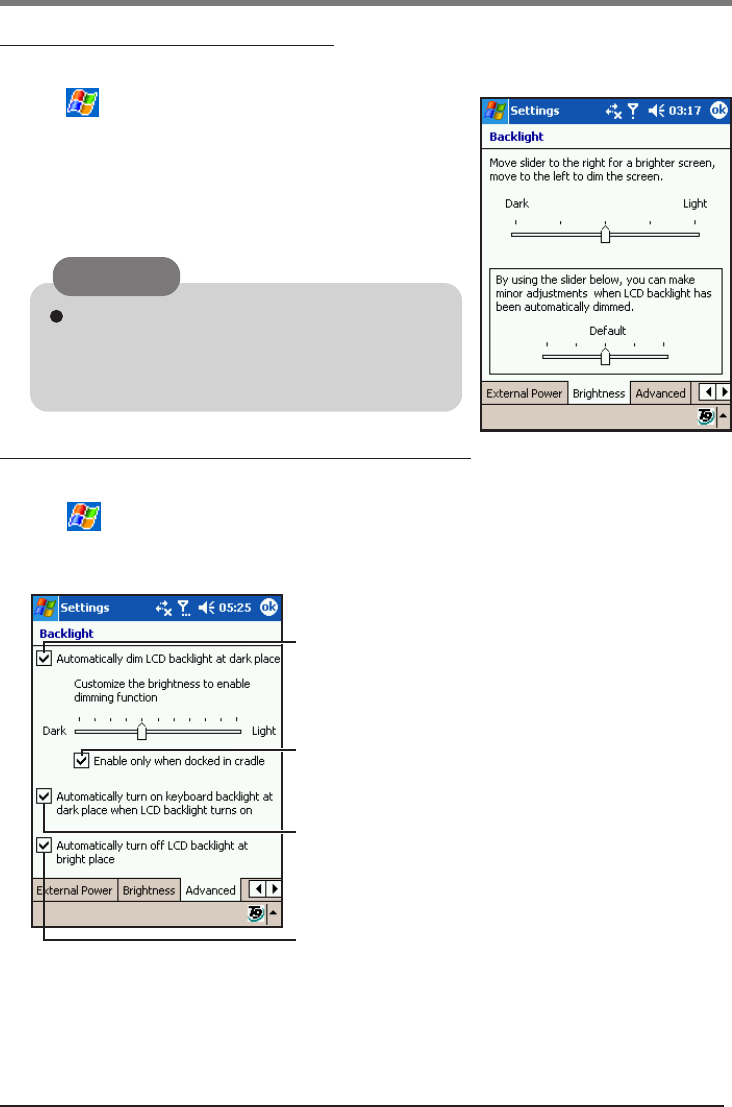
19
Adjust the LCD Brightness
Screen brightness can be adjusted in accordance with the usage conditions.
1
Tap - [Settings] - [System] tab - [Backlight].
2
Tap the [Brightness] tab and adjust the bright-
ness with the slider.
3
Tap [ok].
Backlight Settings
Settings of the Backlight Automatically
The backlight can be set automatically.
1
Tap - [Settings] - [System] tab - [Backlight].
2
Tap the [Advanced] tab.
3
Tap [ok].
Add the check mark so that when LCD backlight turns
on, keyboard backlight turns on automatically at dark
place.
Add the check mark so that the sensor detects the
amount of light, and the backlight automatically be-
come dimmer so that the LCD screen is not too bright
when using CF-P2 in a car or other dark places.
Add the check mark so that the sensor detects the
amount of light, and the backlight automatically turn
off at bright places.
CAUTION
If there are check marks at [Advanced] tab (see
below), this function may not work. In such a
case, remove those check marks and adjust the
brightness with the slider.
Add the check mark so that the dimming function is
enabled only when CF-P2 is docked in its car mounter’s
cradle.
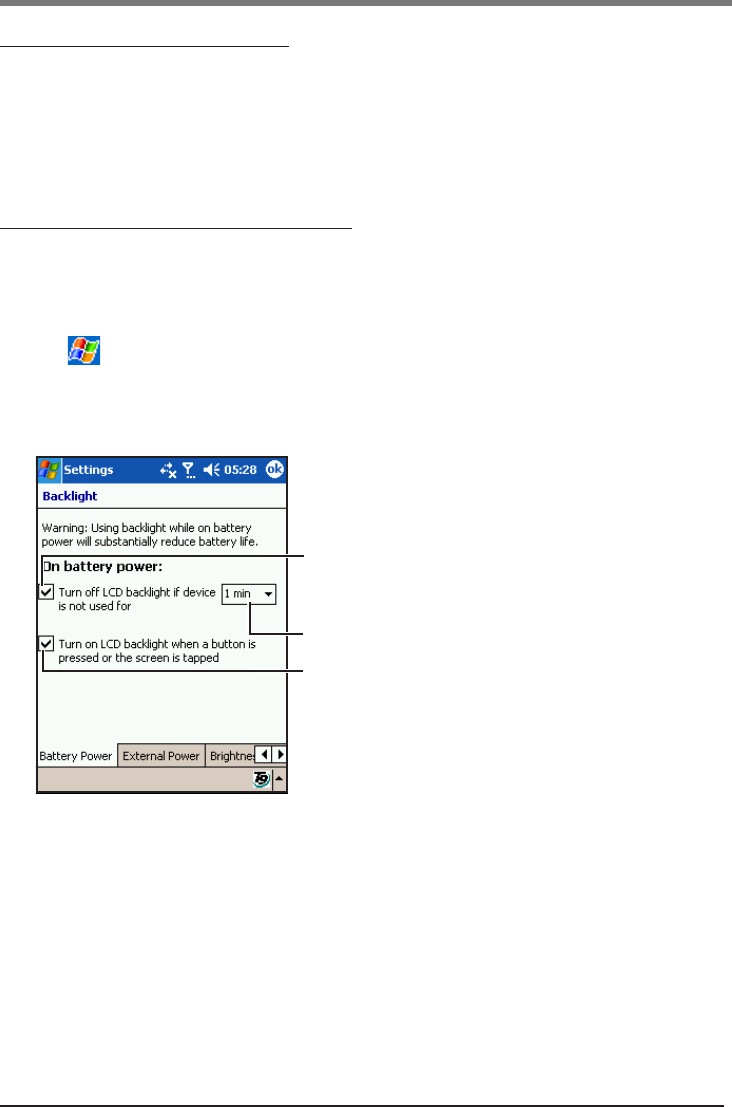
20
Setting of the LCD Backlight
The LCD backlight can be set to turn off automatically (e.g., for conserve power) by setting
the timeout function. Individual settings can be made for battery use and The Fast Travel
Charger use.
1
Tap - [Settings] - [System] tab - [Backlight].
2
Battery use setting: Tap the [Battery Power] tab.
The Fast Travel Charger use setting: Tap the [External Power] tab.
3
Tap [ok].
Add a check mark so that when the device is not oper-
ated, the LCD backlight switches off automatically
when the timeout expires.
Add a check mark so that tapping the screen turns the
LCD backlight on.
(Example for [Battery Power])
Timeout
Backlight Settings
LCD Backlight ON/OFF
Turn on CF-P2, and press the power switch until the LCD backlight goes on/off and release
the switch. (Depending on the setting under the [Advanced] tab, the LCD backlight may not
be turned on.)
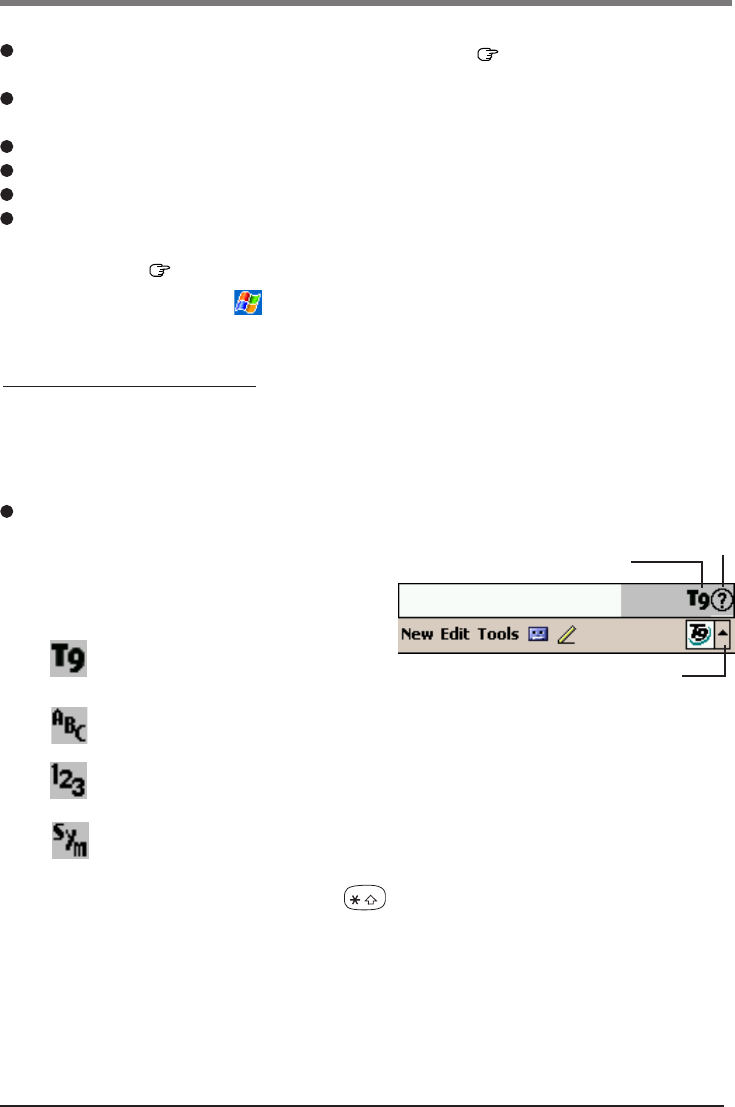
21
Entering Information
You can use the following options to enter information:
Use the numeric keypad to input typed text by using T9 ( below) or the number shown
on the key top.
Use the input panel to input typed text, either by using the soft keyboard or other input
method.
Write directly on the screen.*1
Draw pictures on the screen.*1
Speak into the internal microphone to record a message.*1
Use Microsoft® ActiveSync® to synchronize or copy information from a host computer to
CF-P2. For more information on Microsoft® ActiveSync®, see ActiveSync® Help on the
host computer ( page 36).
*1 For more information, tap - [Help] - [Settings] - [Input].
With T9® Text Input software, you can enter text easier and faster than with the “Multitap”
method of text entry. Instead of pressing a key repeatedly to enter a letter, you press a key
only once for each letter.
The current mode is indicated at (B).
CF-P2 has four text entry modes:
(T9): Used to enter letters,
numbers, and symbols.
You press a key only once for each letter.
(ABC): Used to enter letters and numbers. You press keys repeatedly to
cycle to the desired character.
(123): Used to enter numbers.
(Symbols): Used to enter symbols and punctuation marks.
To change the text entry mode, press for more than one second or tap (B)
repeatedly until the icon of the mode you want is displayed.
Using T9® Text Input
Changing the text entry mode
(1) Tap the arrow (A) and tap [Alphabetic T9].
(2) Tap (B) and select a text entry mode. (B)
(A)
Help
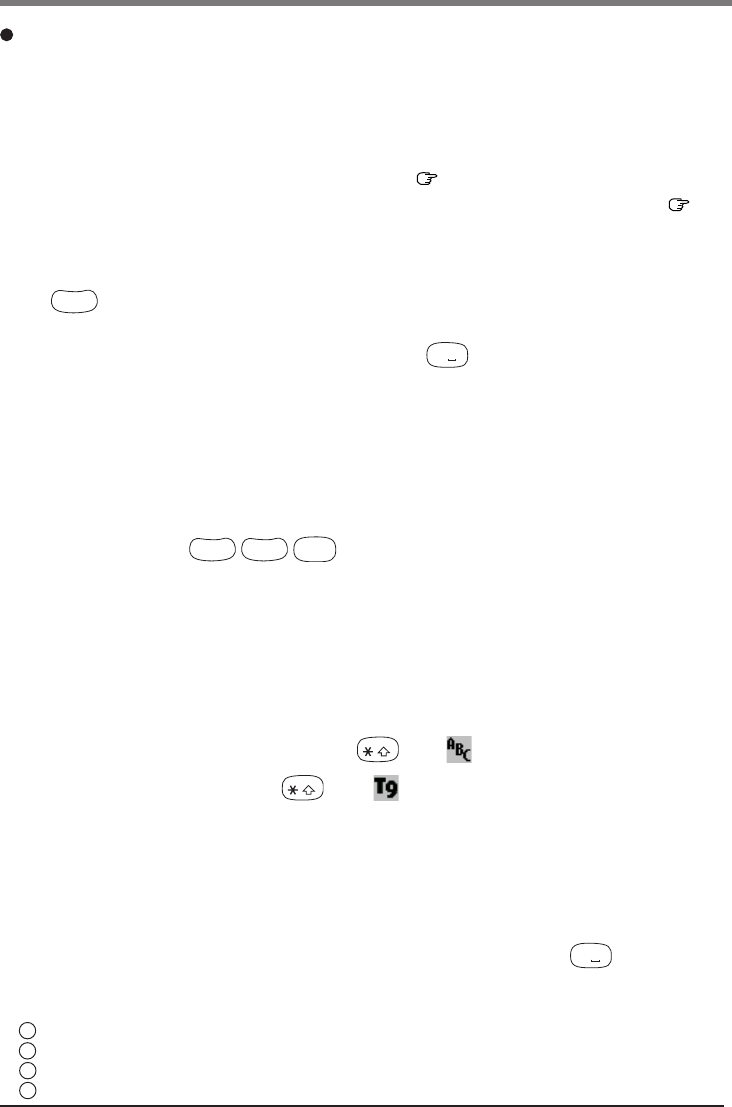
22
Entering Letters in T9 Mode
Important T9 concepts:
• Type to the end of the word if it does not appear after you enter the first few letters.
• Don’t be concerned about what appears on screen while entering a word.
• Press the up/down cursor control to scroll through word choices.
• You can enter words that contain capital letters ( page 23 “Changing the Shift State”).
• You can use the Smart Punctuation feature to quickly add punctuation to words ( page
23 “Entering Symbols”).
(1) Press the corresponding number key one time. For example, to enter the letter c, press
2
abc once. Although each key represents several letters, T9 determines from the keys
you press which letter you want.
(2) If the word displayed is the one you want, press
#
to add a space and begin the next
word.
(3) Press center of the cursor control to enter the word.
The following section describes what to do if T9 doesn’t display the word you want.
When the Word You Want Isn’t on Screen
Sometimes the word T9 displays isn’t the one you want. For example, to enter “cat” you
would press the keys
2
abc
2
abc
8
tuv
. For this key sequence, however, “act” is the most
likely matching word. Although T9 displays “act”, it has prepared a list of all the words
that match the key sequence.
To view the next matching words, press the up/down cursor control. Pressing this cursor
control replaces the current word with the next matching word.
When the Word Isn’t in T9’s List
Sometimes the word you want to enter isn’t in T9’s list of matching words. In this situation,
you can switch to ABC mode by pressing until is displayed and enter the word.
Return to T9 mode by pressing until is displayed. T9 automatically also adds
words input in ABC mode to its dictionary.*1
Entering Completed Words*1
Sometimes T9 places in the selection list completed words. Completed words match the
keys you’ve entered but contain additional characters. If the completed word isn’t the one
you want, just keep entering letters. T9 will remove the completed portion of the word for
you automatically. If the completed word is the one you want, press
#
to add a space
and begin the next word.
*1 This setting can be changed as follows.
1 Tap the arrow on the command bar.
2 Tap [Options] - [Input Method] tab - tap [Options].
3 Add/remove a check mark from each setting.
4 Tap [ok].
Entering Information
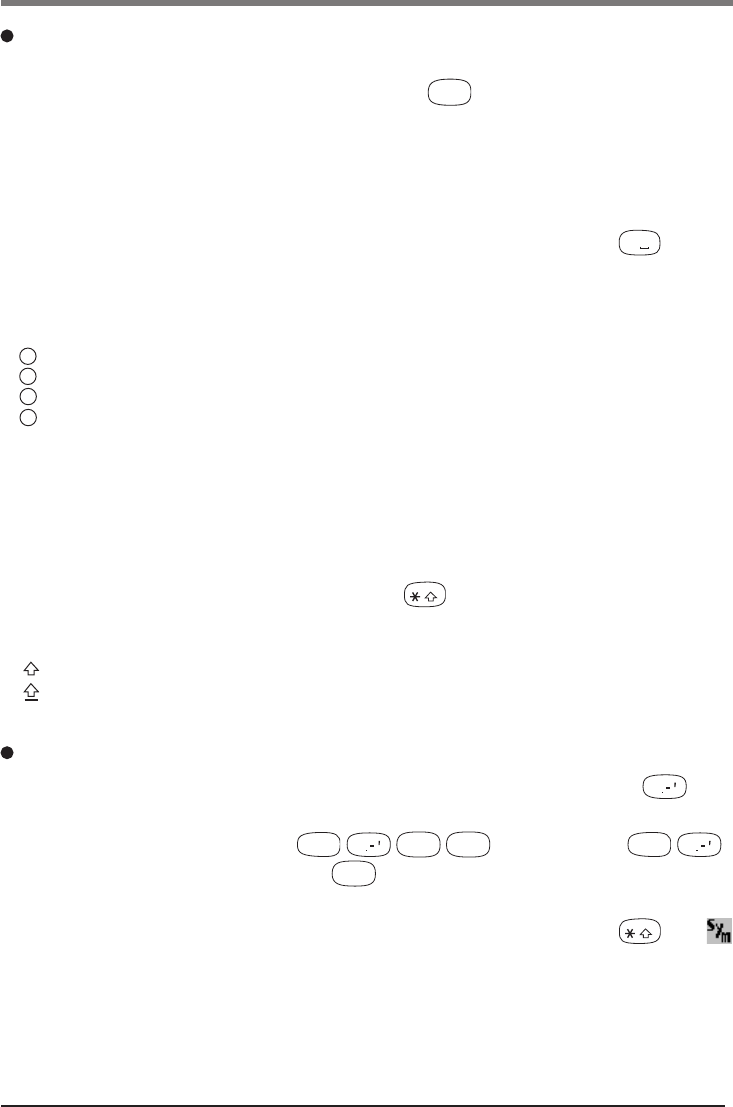
23
Entering Letters in ABC Mode
To enter a letter, press the corresponding number key repeatedly until you cycle around to
the desired letter. For example, to enter an s, press
7
pqrs
four times.
Entering Predicted Words*1
Sometimes T9 places in the selection list predicted words. Predicted words are words T9
thinks you may want to enter, based on text you’ve recently entered. Available in both T9
and ABC mode, predicted words are underlined.
If the predicted word you see isn’t the one you want, press the up/down cursor control to
view additional predicted words. When you find the one you want, press
#
to add a
space and begin the next word.
If none of the predicted words in the selection list is the word you want, just keep entering
letters. T9 will remove the predicted word for you automatically.
*1 This setting can be changed as follows.
1 Tap the arrow on the command bar.
2 Tap [Options] - [Input Method] tab - tap [Options].
3 Add/remove a check mark from each setting.
4 Tap [ok].
Changing the Shift State
T9 has three shift states:
• Lowercase—letters are in lowercase.
• Single-character uppercase—the next letter you enter is in uppercase. T9 then automati-
cally returns to lowercase.
• Uppercase—letters are in uppercase.
To switch from one shift state to the next, press key:
You can see which mode is active by looking at the next to T9 mode indication. You may
see one of these icons:
: Indicates single-character uppercase.
: Indicates uppercase.
If you do not see either icon, CF-P2 is in lowercase.
Entering Symbols
There are two ways to enter symbols. If CF-P2 is in T9 mode, you can press
1
(also
known as the Smart Punctuation key) to enter a symbol and then continue adding letters.
For example, to enter “I’ll”, press
4
ghi
1
5
jkl
5
jkl
. After you press
4
ghi
1
,
the display reads I., but once you press
5
jkl
, the display changes to “I’l”. If the displayed
symbol isn’t the one you want, press the up/down cursor control to see other choices.
You can also enter symbols by setting CF-P2 to Symbols mode (by pressing until
is displayed). When CF-P2 is in Symbols mode, symbols appear in the selection list. If you
see the symbol you want, select it using the cursor control, and the symbol will be added.
If you don’t see the symbol you want, press the up/down cursor control to see the next page
of symbols. After you enter a symbol, CF-P2 returns to the mode it was in before you set it
to Symbols mode.
Entering Information
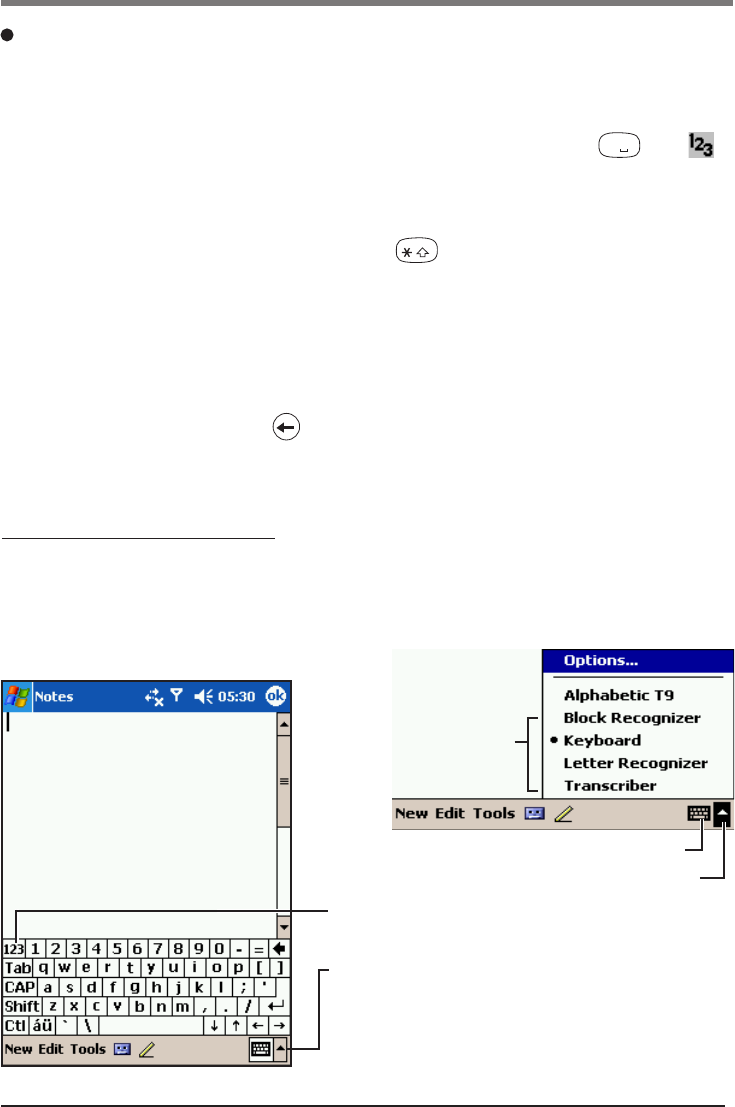
24
Select an input method
Input Panel Button
Tap to see your choice
Use the input panel to enter information in any program on CF-P2. You can either type using
the soft keyboard or write using Letter Recognizer, Block Recognizer, or Transcriber. In
either case, the characters appear as typed text on the screen.
To show or hide the input panel, tap the input panel button. Tap the arrow next to the input
panel button to see your choices.
Using the Input Panel
To type with the soft keyboard:
(1) Tap here and then [Keyboard].
(2) On the soft keyboard that is displayed,
tap the keys with your stylus.
Tap [123] to allow the keyboard to input $,
{}, %, etc.
Entering Information
Entering Numbers
There are two ways to enter numbers. If CF-P2 is in ABC or T9 mode, you can enter a
number by pressing the corresponding number key until a number is displayed. The num-
ber is entered, but CF-P2’s text entry mode doesn’t change.
You can also enter numbers by setting CF-P2 to 123 mode (by pressing
#
until is
displayed). Setting CF-P2 to 123 mode is useful if you want to enter more than one or two
numbers—for example, street addresses or phone numbers. After setting CF-P2 to 123
mode, enter numbers by pressing the corresponding number keys. When you’re finished,
set CF-P2 back to previous mode (by pressing until previous mode is displayed).
Moving the Cursor
You can move the cursor by pressing the right/left cursor control. However, the number of
characters that the cursor moves can vary—within T9 mode it generally moves word by
word and within ABC mode it moves letter by letter.
Deleting Text
You can delete text by pressing . Each key press deletes the character left of the cursor.
(Example for [Keyboard])
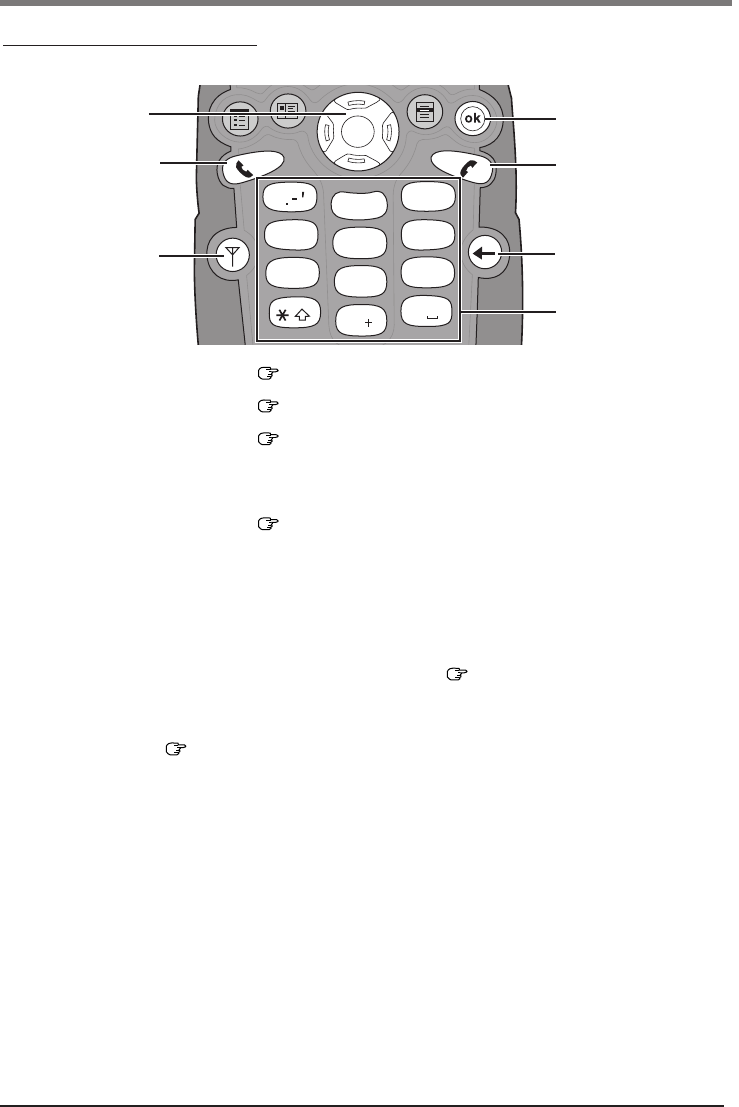
25
23
6
9
5
8
0#
4
1
abc def
mno
wxyz
jkl
ghi
tuv
7
pqrs
Entering Information
Press a key to input the number shown on the key top.
OFF Hook (Talk) Button: page 53.
ON Hook (End) Button: page 53.
Wireless Power Button*1: page 39.
ok Button*1:This key works the same as the tapping [ok] on the screen.
Cursor Control: page 8.
Backspace Key: This key works the same as the Backspace key of a com-
puter.
Numeric Keypad: Use when making phone calls. Characters and numbers can
also be input using T9 ( page 22).
*1These are the settings at the time of purchase. You can change the assignment of these
program buttons ( page 26).
ok Button
Numeric
Keypad
Backspace Key
ON Hook (End)
Button
OFF Hook (Talk)
Button
Wireless Power
Button
Using the Keyboard
Cursor Control
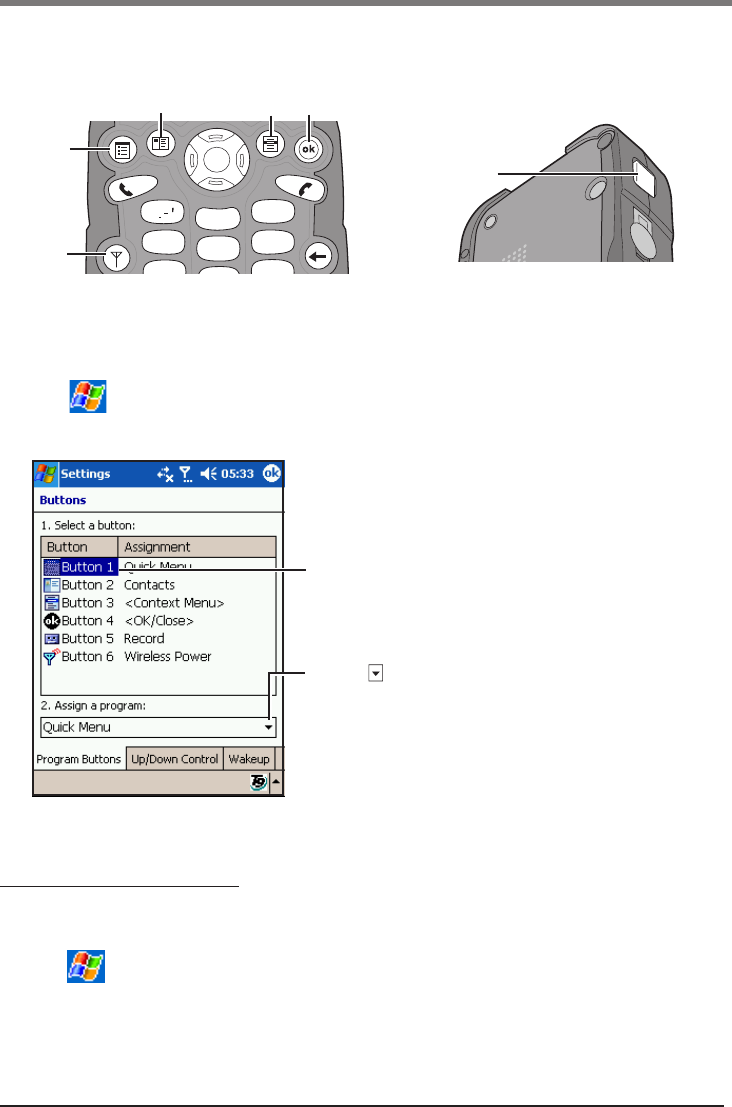
26
Changing the Assignment of Program Buttons
Programs are assigned to the buttons shown below at the time of purchase. If either of the
buttons is pressed after the computer has started up, the program assigned for that button is
started up. These buttons are called program buttons.
You can change the assignment of the program buttons following the procedure.
1
Tap - [Settings] - [Personal] tab - [Buttons].
2
Choose each setting.
Setting to Resume
You can resume the computer with the program buttons and OFF Hook (Talk)/ON Hook
(End) Buttons.
1
Tap - [Settings] - [Personal] tab - [Buttons] - [Wakeup] tab.
2
Add a check mark to resume when the program buttons and OFF Hook (Talk)/
ON Hook (End) Buttons are pressed.
3
Tap [ok].
3
Tap [ok].
(1)Tap one button.
(2)Tap under [Assign a program] and select a pro-
gram from the list.
(E)
23
6
9
5
8
4
1
abc def
mno
wxyz
jkl
ghi
7
pqrs
(C)
(B) (D)
(A)
(F)
(A) - Quick Menu (B) - Contacts (C) - Context Menu (D) - OK/Close
(E) - Record (F) - Wireless Power
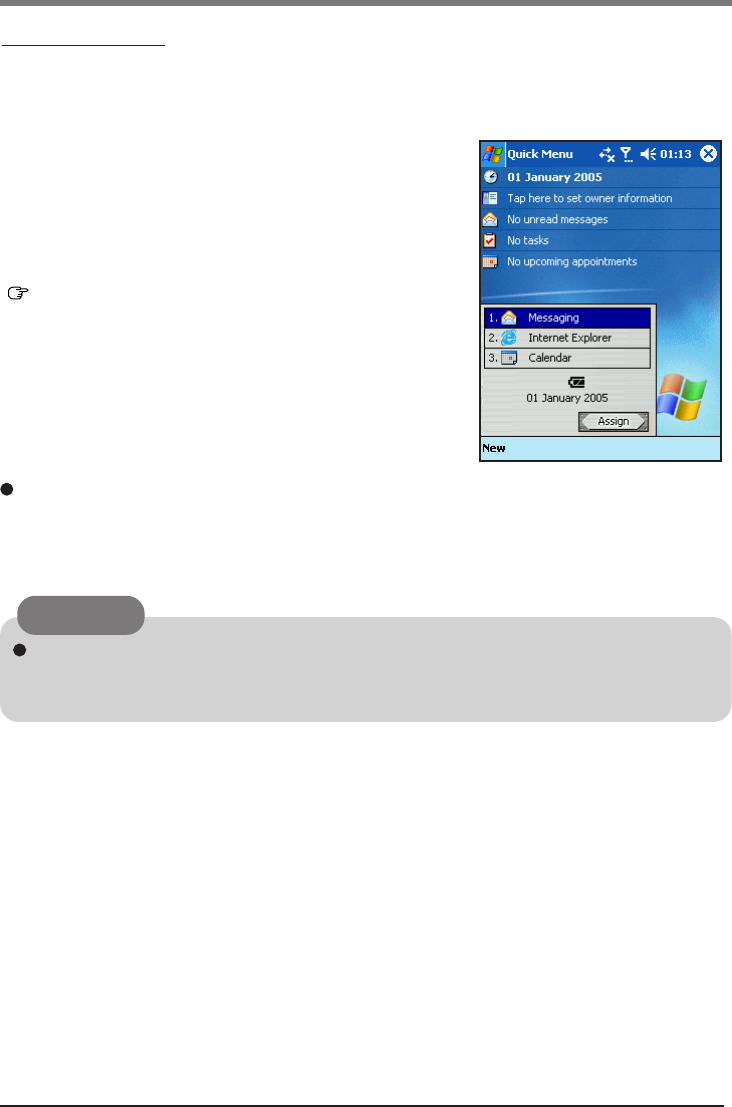
27
Changing the Assignment of Program Buttons
Quick Menu
Quick Menu tool allows you to launch the enrolled application quickly by pressing the pro-
gram button, and check the battery status and date. When you press the program button that is
assigned to the Quick Menu, the window indicated below is displayed.
You can select an item from the Quick Menu in the following ways.
• Press the number key corresponding to the item number.
• Select the menu by using the cursor control to launch application.
• Tap the item.
The following programs are assigned to the menu item at
the time of purchase.
Item 1 - Messaging
Item 2 - Internet Explorer
Item 3 - Calendar
You can change the assignment of Quick Menu
( page 28).
CAUTION
When starting the Quick Menu after the Fast Travel Charger is connected or discon-
nected, the battery condition may not be displayed correctly. The correct value will be
displayed after a few moments.
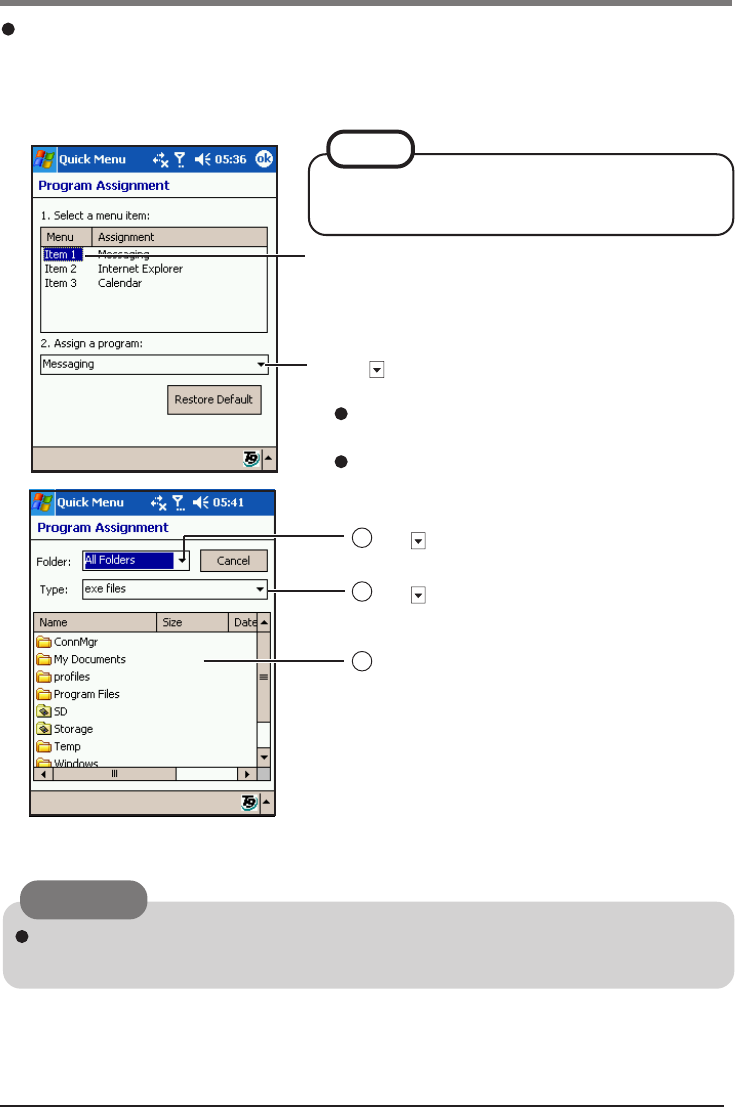
28
Changing the Assignment of Quick Menu
1
Press the program button that is assigned to the Quick Menu and tap [As-
sign].
[Program Assignment] will be displayed.
Changing the Assignment of Program Buttons
(2)Tap under [Assign a program:] and select a pro-
gram from the list.
When selecting <None>, the menu assignment
will be none.
When selecting [(...Free command)], the follow-
ing screen will be displayed.
1 Tap and select a folder.
(1)Tap one item.
3 Tap folders and select a program from the list.
If the [Restore Default] is tapped, the assignments
will return to the default settings.
2
Tap [ok].
CAUTION
Do not delete or move assigned programs using the File Explorer or other function.
An assigned program cannot be started up if it has been deleted or moved.
NOTE
2 Tap and select type of files.
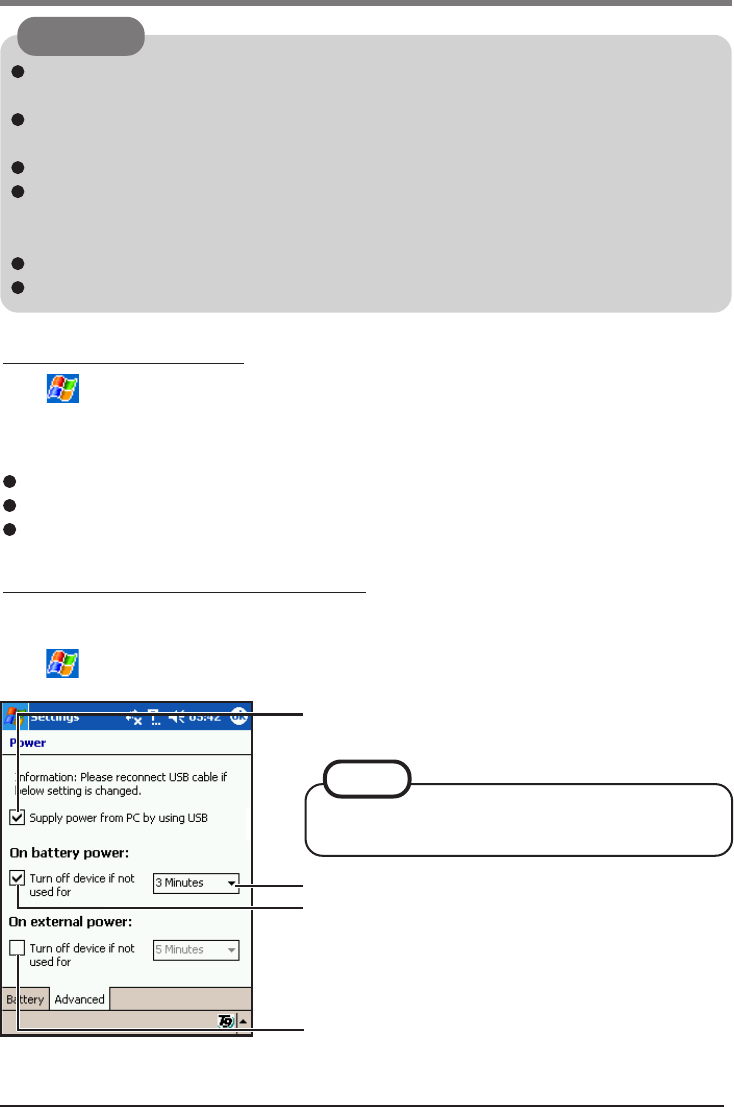
29
Battery Power
CAUTION
Ensure that the backup battery is fully charged before replacing the battery pack and
replace the battery pack within 30 minutes; otherwise the data in RAM will be lost.
Do not touch the terminals of the battery pack. The battery pack may no longer function
properly if the terminals are dirty or damaged.
Do not expose the battery pack to water, or allow it to become wet.
The battery pack is not charged when CF-P2 is first purchased. Be sure to charge it
before using it for the first time. When the Fast Travel Charger is connected to CF-P2,
charging begins automatically.
Use only the specified battery pack (CF-VZSU33U) with CF-P2.
Do not install or remove the battery pack while CF-P2 is on.
Remaining Battery
Tap - [Settings] - [System] tab - [Power] - [Battery] tab.
The recharging state is displayed.
When the Remaining Battery Charge Becomes Low
Plug in the Fast Travel Charger, and fully charge your battery.
Use a spare battery if you have one.
If you have neither the Fast Travel Charger nor a spare battery, power off your computer.
Setting for Auto Powering Off
You can set CF-P2 power to turn off automatically after a specified period of time.
Tap - [Settings] - [System] tab - [Power] - [Advanced] tab.
Add a check mark so that when CF-P2 is not operated,
CF-P2 turns off automatically when the timeout ex-
pires.
Add a check mark so that when the Fast Travel Charger
is connected, CF-P2 turns off automatically when the
timeout expires.
Timeout
Add a check mark to supply power from another computer
via USB.
NOTE
Power may not be supplied, depending on the
condition of CF-P2 or the other computer.
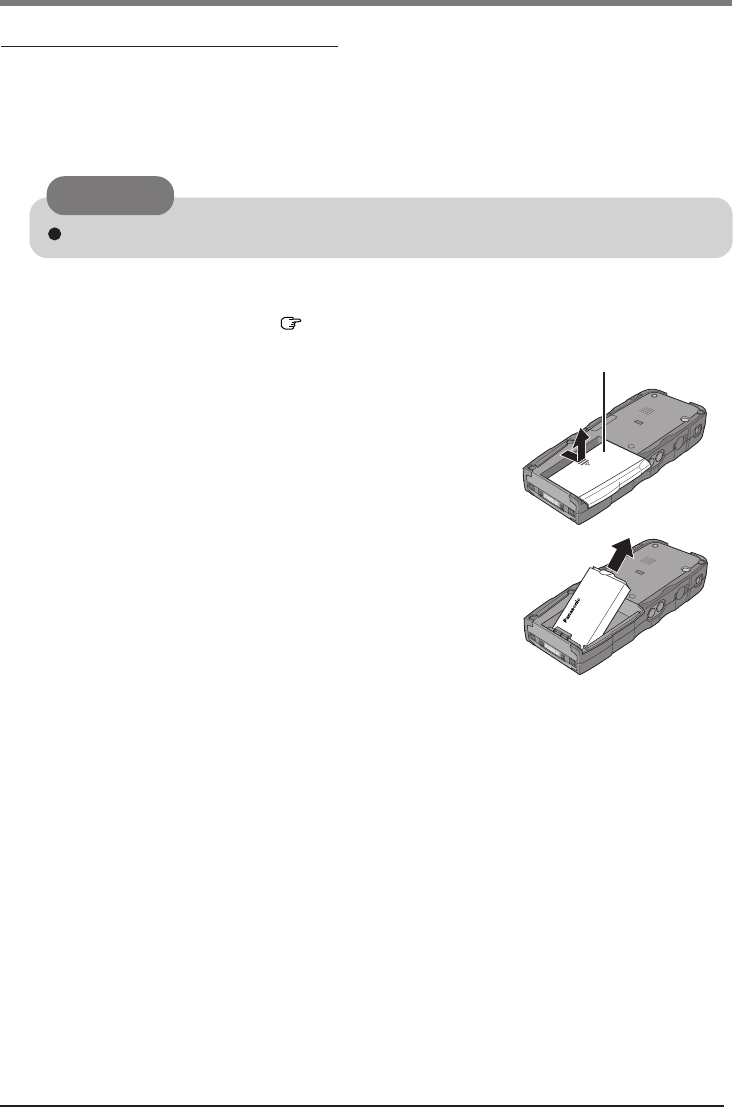
30
Removing the battery pack
(1) To turn off [Phone], lightly press the Wireless Power
Button (within 0.5 seconds) to display [Wireless Power
Status] screen. (For details, page 39.)
(2) Turn off your computer.
(3) Turn your computer over and slide the battery pack cover
to remove it.
(4) Remove the battery pack in the direction shown in the
figure.
Installing the battery pack
(1) Refer to page 9 about installing the battery pack.
(2) Turn your computer on.*1
(3) Save the unsaved data and push the reset switch.
*1 When [Phone] is still on and the battery pack is replaced, the message [Phone function is
disabled. Please reset] may appear.
Replacing the Battery Pack
When the charge provided by your battery pack is supplied for only a short period of time,
even after full charging according to the instructions, it may be time to replace your battery
pack. The battery pack is a consumable item and therefore requires replacement (CF-VZSU33U).
Battery Power
Battery Pack Cover
CAUTION
Ensure that the Fast Travel Charger is removed when replacing the battery pack.
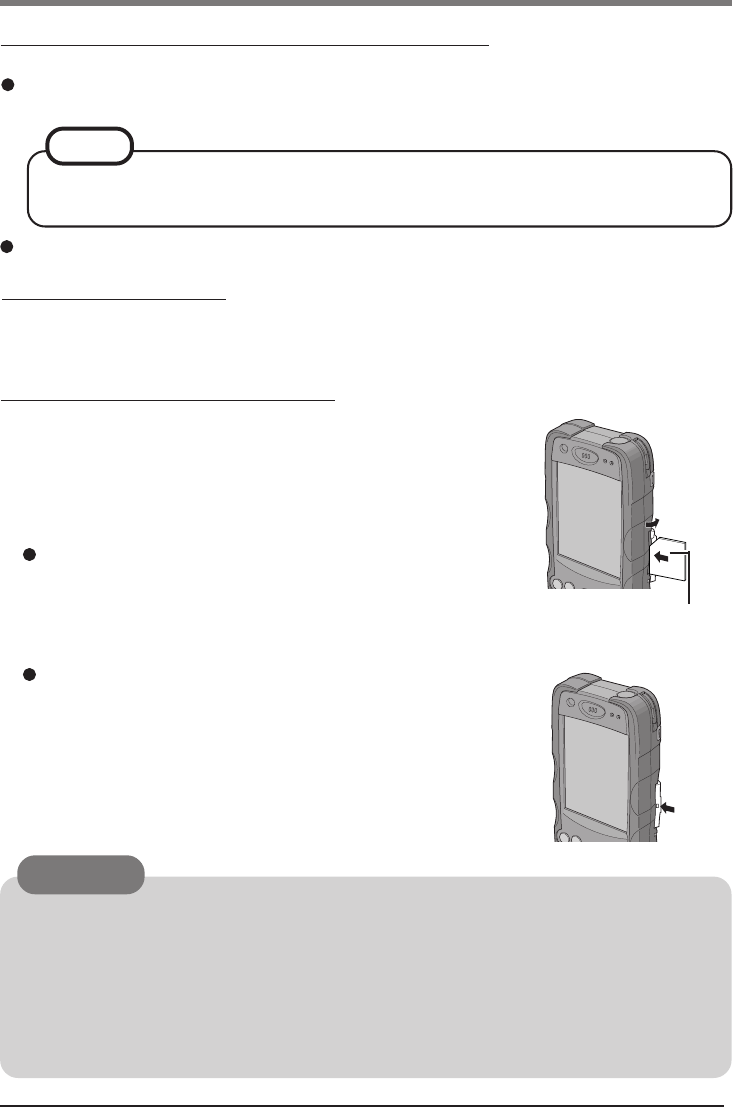
31
SD Memory Card/SDIO Card/MultiMedia Card
Inserting/Removing a Card
An SD Memory Card/MultiMedia Card can be used for the following purposes.
The exchange of data with various devices equipped with an SD card/MultiMedia Card
slot, audio storage, and so on.
1
Open the SD card*1/MultiMedia Card slot cover.
*1 SD card includes an SD Memory Card and an SDIO card.
2
Inserting
Slide the card in until it snaps into place as shown in the
illustration.
Make sure the labeled face of the SD card/MultiMedia
Card is towards the front of the computer and then firmly
insert the card. If you mistake the back side of the card
with the top surface side, the card cannot be inserted all
the way into the slot.
Do not insert the card at an angle.
Removing
(1) Press the card. It will come out slightly.
(2) Remove the card.
3
Close the SD card/MultiMedia Card slot cover.
NOTE
Software (e.g., drivers) required to exchange data with these devices. (Refer to the
instructions manual provided with each SD compatible peripheral device.)
Use as a memory card (e.g., use as a storage unit on which files can be written).
CAUTION
Before removing an SD card/MultiMedia Card or powering off CF-P2, check to see the
SD card LED indicator whether CF-P2 is accessing the card. Such accesses are done
intermittently for a short period of time. Be sure to remove the card or power off CF-P2
only after confirming that CF-P2 is not accessing the card. If the card is removed or CF-P2
is powered off during an access attempt, valuable data may be lost or CF-P2 may fail to
work properly. With the SDIO card, in some cases access is not interrupted, so refer to the
instructions manual provided with the SDIO card.
SD card/MultiMedia
Card Slot
About SD Memory Card/MultiMedia Card
About SDIO Card
Before using the SDIO card, the software attached to SDIO card has to be installed. For
details, refer to the instructions manual provided with the SDIO card.
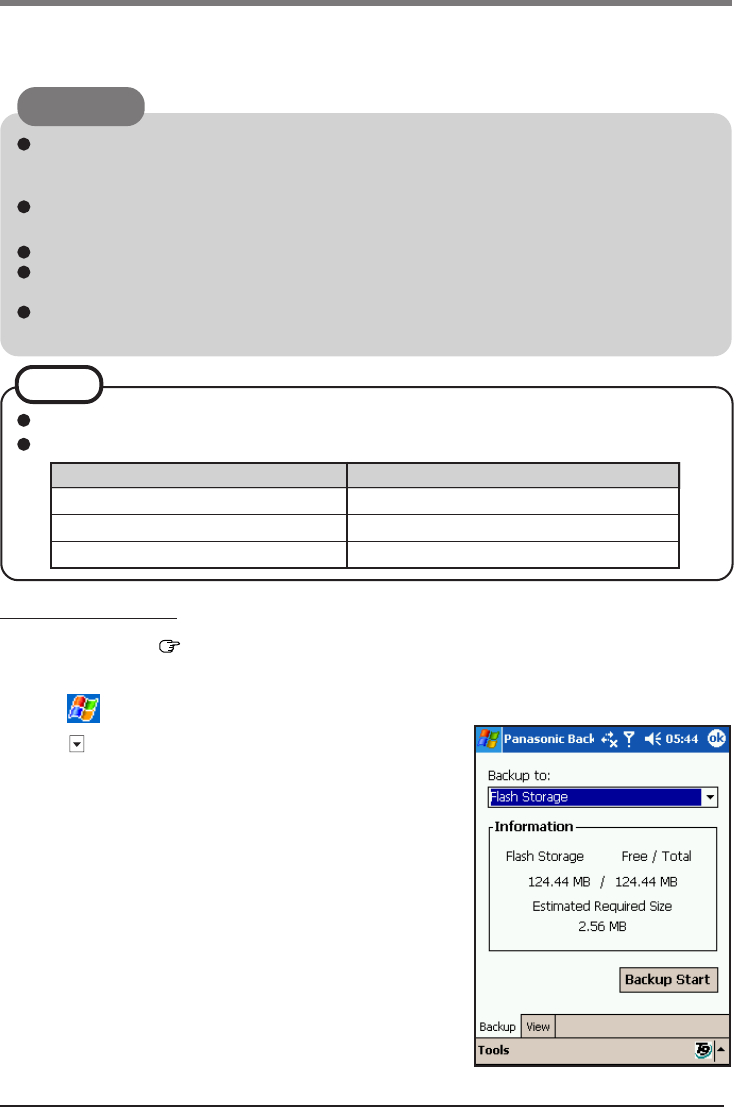
32
Using the backup function, you can back up data from the CF-P2 RAM to an SD Memory
Card, MultiMedia Card, or Flash Storage, or restore data backed up on those storage area to
the CF-P2 RAM.
Panasonic Backup
CAUTION
The data in [Messaging] may not be backed up correctly. When you back up and re-
store data, some mail contents may be lost. If you need to save the mail data, leave it
on the server.
Do not do the following during the procedure:
• Touching the power switch, any keyboard and touchscreen.
Disable the connection with the host computer, for example by disconnecting the cable.
Confirm that battery remaining is at least 50%, disable all power management, and
stop any other programs that may be running.
When backing up to an SD Memory Card, be sure to insert the SD Memory Card
first, and wait for a moment, then start [Panasonic Backup]. (See below)
NOTE
Backup processing cannot be executed manually during Auto Backup or Auto Restore.
We recommend that each media be formatted as shown below when backing up.
Media Recommended Format
SD Memory Card SD Format (use SD Formatter)
MultiMedia Card FAT16
Flash storage Not required.
1
Reset CF-P2 ( page 61).
2
When backing up to an SD Memory Card, insert the SD Memory Card.
3
Tap - [Programs] - [Panasonic Backup] - [Backup] tab.
4
Tap to select the storage area to back up
the data.
5
Tap [Backup Start].
If the warning message is displayed, select [YES] to
confirm after carefully reading the message.
6
Input the Backup file name.
Add a check mark for [Set Password] and set a pass-
word if required.
7
Tap [ok].
Follow the on-screen instructions.
The progress screen will be displayed. To stop the op-
eration, tap [Abort].
“Backup successful” will be displayed when the backup
is complete. Tap [ok].
Manual Backup
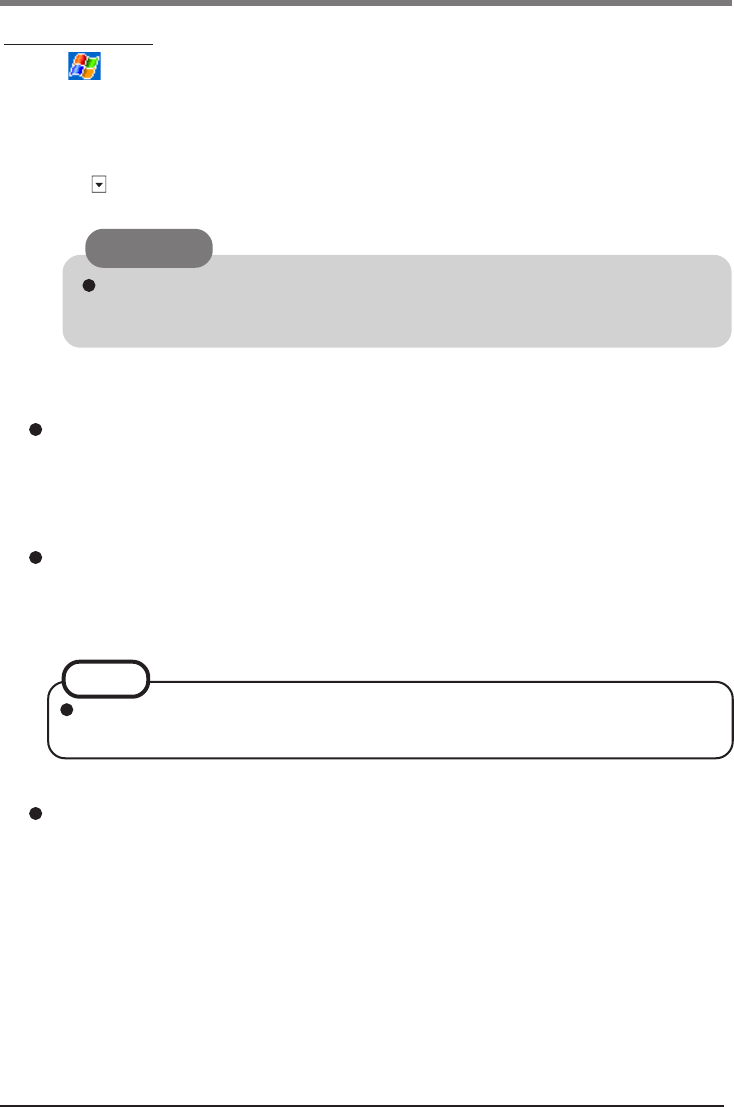
33
1
Tap - [Programs] - [Panasonic Backup].
2
Tap [Tools] on the command bar and select [Auto Backup Settings].
A warning message will be displayed. Tap [ok].
3
Tap [File] tab.
(1) Tap to choose the storage area for Auto Backup.
(2) Change the settings in [Settings].
4
Make a setting for Auto Backup.
When making a setting at the time and day*1:
(1) Tap [Schedule] tab.
(2) Add a check mark for [Scheduling backup].
(3) Set the time and day to back up at [Backup Schedule].
When making a setting to start Auto Backup when the remaining battery power is low*1:
(1) Tap [Battery] tab.
(2) Add a check mark for [Backup when battery is low].
(3) Set the threshold.
*1 [Scheduling backup] and [Battery] can be set simultaneously.
When setting a password for backup files:
(1) Tap [Password] tab.
(2) Add a check mark for [Set Password].
(3) Set password for backup files.
5
Tap [ok].
Auto Backup
Panasonic Backup
CAUTION
If there is a check mark in [Stop other application before backup], some appli-
cations currently being executed may or may not save their active files, and
may not shut down properly.
NOTE
If power is off, the amount of battery power remaining cannot be checked so that
this function cannot work.
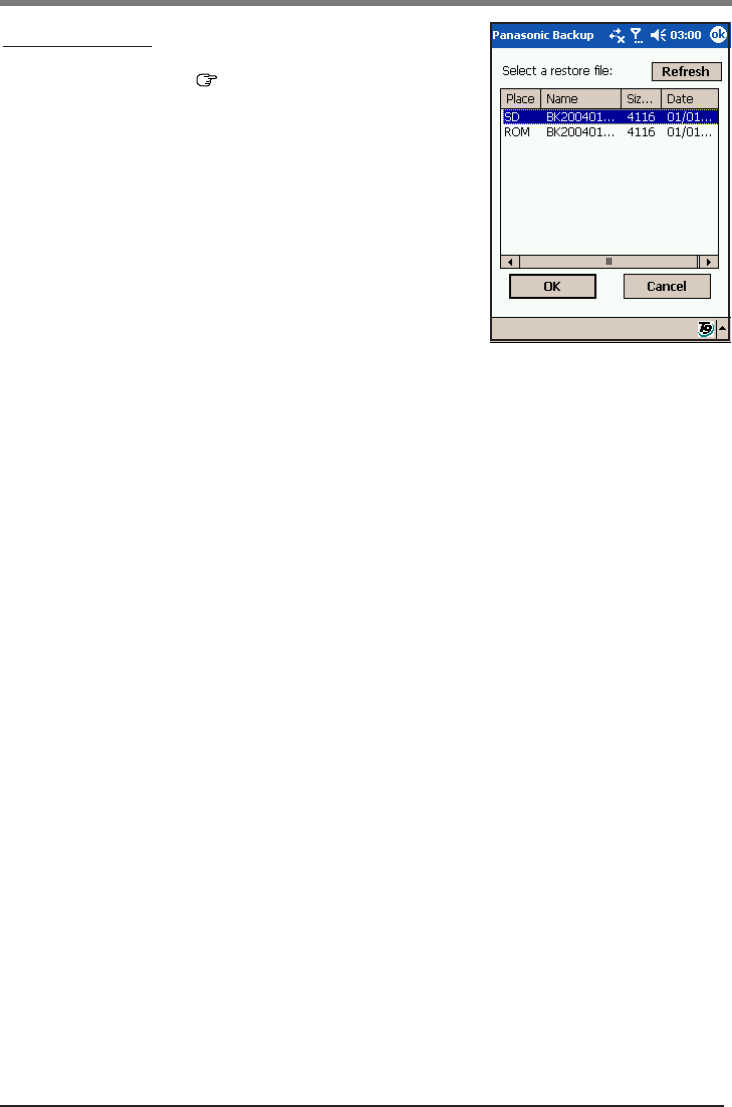
34
Auto Restore
1
Full reset CF-P2 ( page 61 step (1) - (4)).
[Panasonic Backup] screen will be displayed.
2
Select a file for restore, and tap [OK].
If a password has been set, a message will be displayed.
Enter the password and press [OK]. Restore will start.
The progress screen will be displayed. When the re-
store is complete, CF-P2 resets automatically.
Panasonic Backup
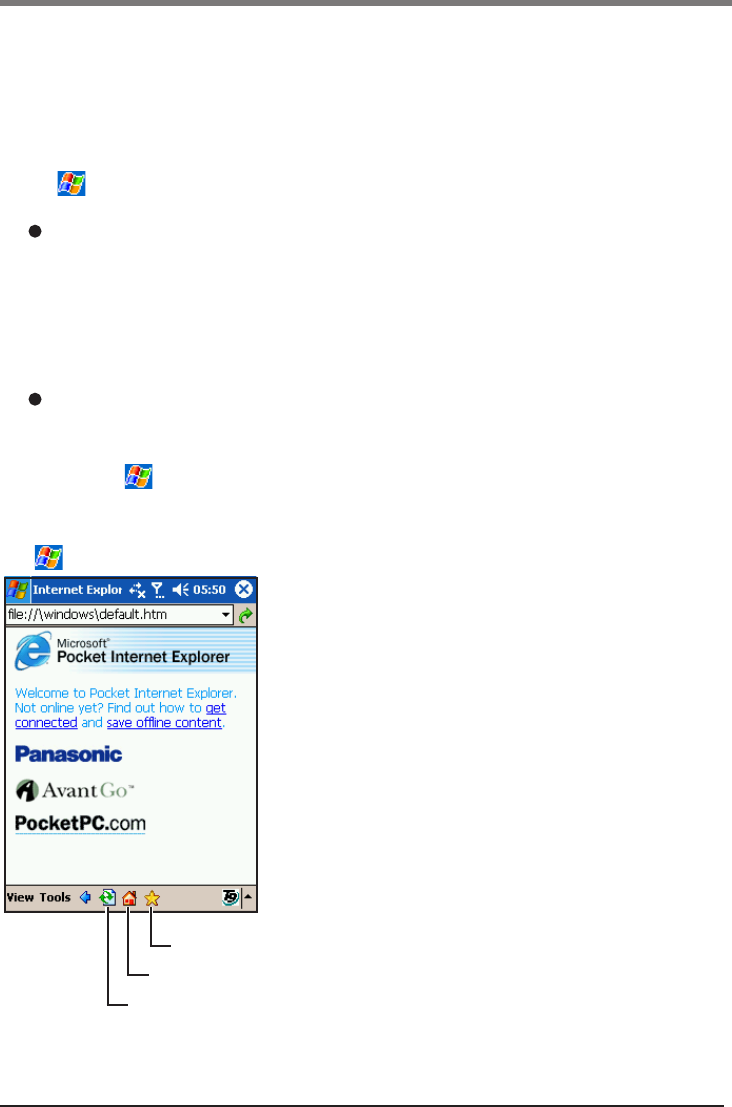
35
You can connect to Internet service provider (ISP), and use the connection to send and re-
ceive e-mail messages and view Web or WAP pages.
Getting Connected
The settings will vary for different network environments. Ask your system administrator or
the person in charge of the network and make settings using the followings.
1
Tap - [Settings] - [Connections] tab - [Connections] in order.
2
Set up or change connection information
On the [Tasks] tab:
(1) Tap one of the followings:
Add a new modem connection (My ISP)
Add a new modem connection (My Work Network)
Add a new VPN server connection (My Work Network)
Set up my proxy server (My Work Network)
(2) Enter the necessary information.
On the [Advanced] tab:
Tap [Select Networks], [Dialing Rules] or [Exceptions] and set up if required.
For details, tap - [Help].
To run Pocket Internet Explorer
Tap - [Internet Explorer].
Pocket Internet Explorer
Favorites Button
Home Button
Refresh Button
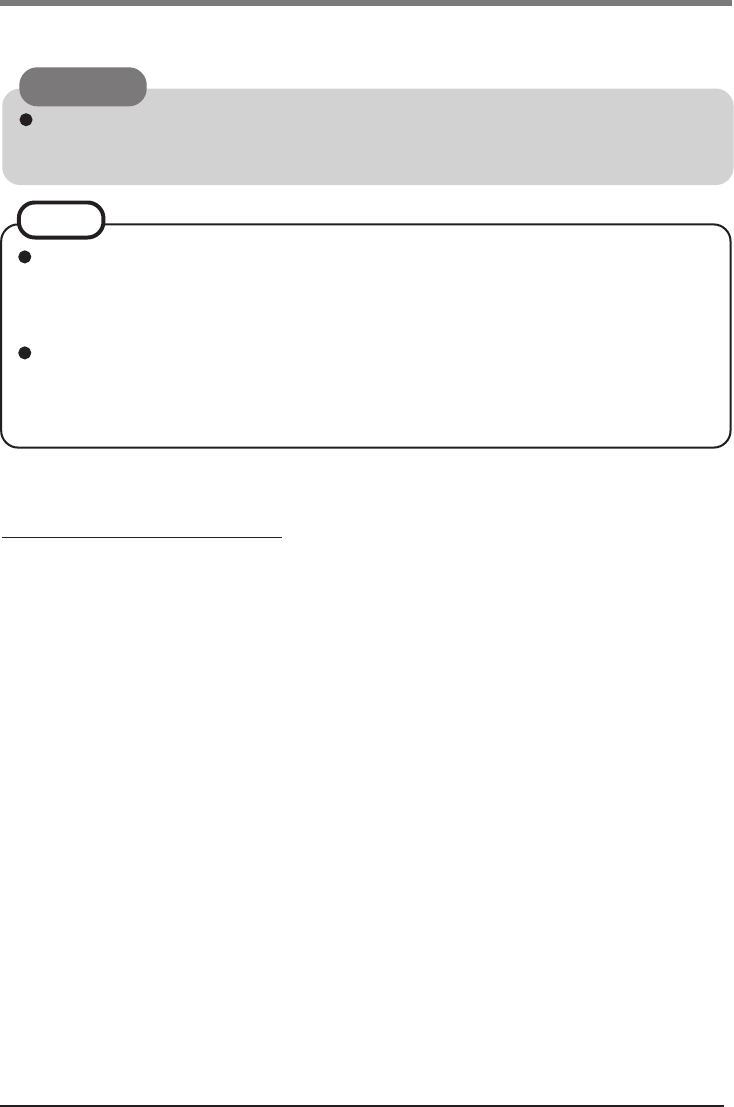
36
Use Microsoft® ActiveSync® to synchronize a host computer and CF-P2 information, to transfer
files between a host computer and CF-P2, or to backup and restore data.
Connecting to Your Computer
CAUTION
To ensure that synchronization functions properly, install Microsoft® ActiveSync® 3.7
from companion CD into the host computer before connecting CF-P2 and the host
computer for the first time.
The USB cable can be used to connect the CF-P2 with a host computer.
Installing ActiveSync®
1
Set the Companion CD into the host computer.
The opening screen is displayed automatically.
• When the opening screen is not automatically displayed.
In [Start] - [Run], input [x:\setup] and select [OK].
(“x” is the drive letter. You can change the letter to suit your preference.)
2
Select [Start Here].
3
Select [Install ActiveSync] and read the on-screen instructions and
select [Install].
4
At [Installation Message], select [OK].
[File Download] will be displayed. This screen varies depending on the host
computer’s software (e.g. Internet Explorer version).
•When [Run] is displayed on [File Download], select [Run]. If the confirmation mes-
sage is displayed, select [Run] again.
• When [Open] is displayed on [File Download], select [Open].
• When [Run this program from its current location] is displayed on [File Download],
select it and then select [OK].
5
At [Microsoft ActiveSync], select [Next].
6
At [Select Installation Folder], select [Next].
When Windows XP SP2 is installed in the host computer, when ActiveSync® is per-
formed by USB connection or Bluetooth connection for the first time, a security
warning message may be displayed. In this case, refer to Security Center Help. Some
functions may be limited depending on the Firewall setting in the Security Center.
If the opening screen of the companion CD is not displayed correctly, connect to the
Internet and restart the companion CD.
If the message to install the Macromedia Flash Player is displayed, follow the on-
screen instructions to install it.
NOTE
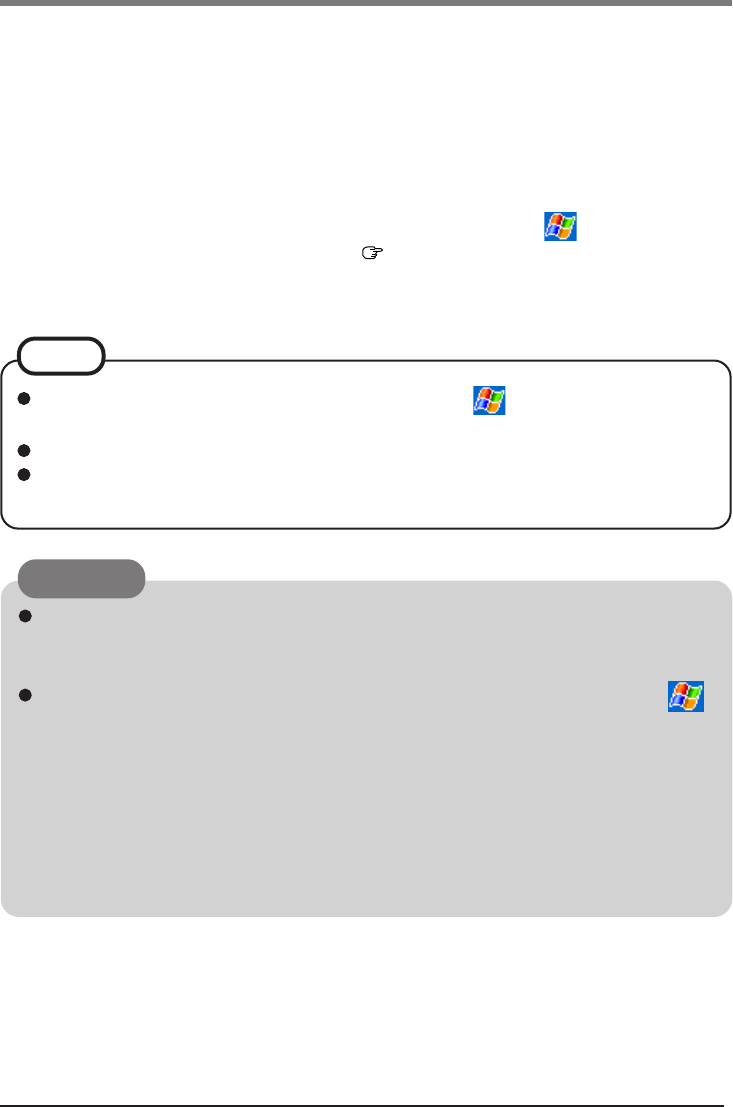
37
To change the synchronization settings, tap, in order, - [ActiveSync] - [Tools] -
[Options]. Be sure to disconnect the cable when changing the synchronization settings.
Disconnect and connect the cable again if communications do not start.
For information about the Microsoft® ActiveSync®, refer to the Microsoft® ActiveSync®
Help.
NOTE
CAUTION
While performing communications, avoid the following:
• Connect/disconnect the cable.
• Turn on/off the CF-P2 and the host computer.
When adding a check mark for [Use mobile schedule to sync with this PC] in -
[ActiveSync] - [Tools] - [Options] - [PC] tab of CF-P2, be sure to check that Microsoft®
ActiveSync® can be connected (for example, when the host computer’s power is on). If
Microsoft® ActiveSync® can not be connected, a situation may arise whereby even
when the CF-P2’s power is switched off, only the power to the LCD turns off, but the
power to the main unit remains on (input from the keyboard is still possible). In this
case, enable the Microsoft® ActiveSync® connection, and synchronize with the host
computer again. If this situation occurs frequently, remove the check mark from [Use
mobile schedule to sync with this PC].
Connecting to Your Computer
7
At [Get Connected], read the on-screen instructions and connect the CF-
P2 with a host computer.
(Refer to page 38 to connect the CF-P2 with a host computer.)
•Change the setting for the host computer or CF-P2, depending on the connection to
the host computer. For details, refer to the ActiveSync® Help of CF-P2, and also refer
to Help displayed on the host computer during the installation.
•At the time of purchase, when the USB cable is connected, power is supplied to CF-
P2 from the host computer. If you do not want power to be supplied, remove the
check mark from [Supply power from PC by using USB] in - [Settings] - [Sys-
tem] tab - [Power] - [Advanced] tab ( page 29).
8
At [Set up a Partnership], select the partnership and follow the on-screen
instructions.
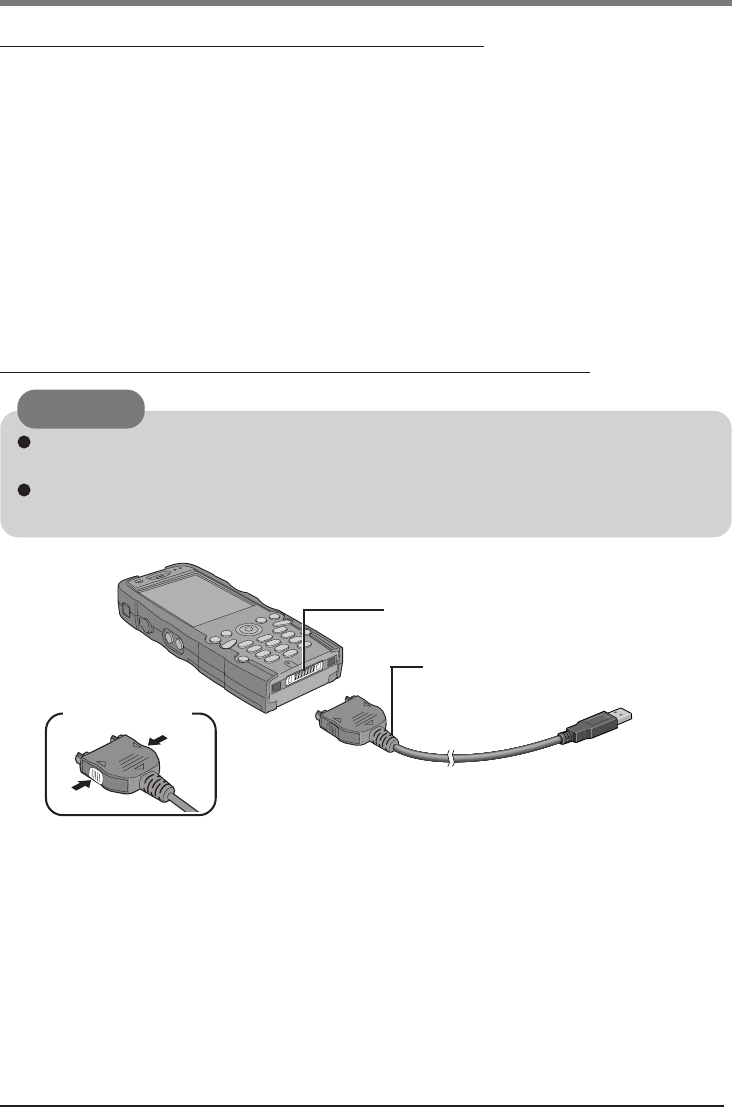
38
Connecting to Your Computer
When Connecting the CF-P2 Directly with a Computer
USB Autosync Cable
Expansion Connector of the CF-P2
Removing
CAUTION
To ensure that synchronization functions properly, install Microsoft® ActiveSync® 3.7
before connecting CF-P2 and the host computer for the first time.
Turn off the CF-P2, the connected computer, and all connected peripherals before
connecting or disconnecting the cable.
Backup/Restore data using ActiveSync®
Backup
(1) At [Microsoft ActiveSync] on the host computer, select [Tools] - [Backup/Restore] -
[Backup] tab.
(2) Select [Full backup] or [Incremental backup] and then select [Back Up Now].
(3) At [Backup Complete], select [OK].
Restore
(1) After Backup procedure, at [Microsoft ActiveSync] on the host computer, select
[Tools] - [Backup/Restore] - [Restore] tab, and select [Restore Now].
(2) Follow the on-screen instructions and restore data.
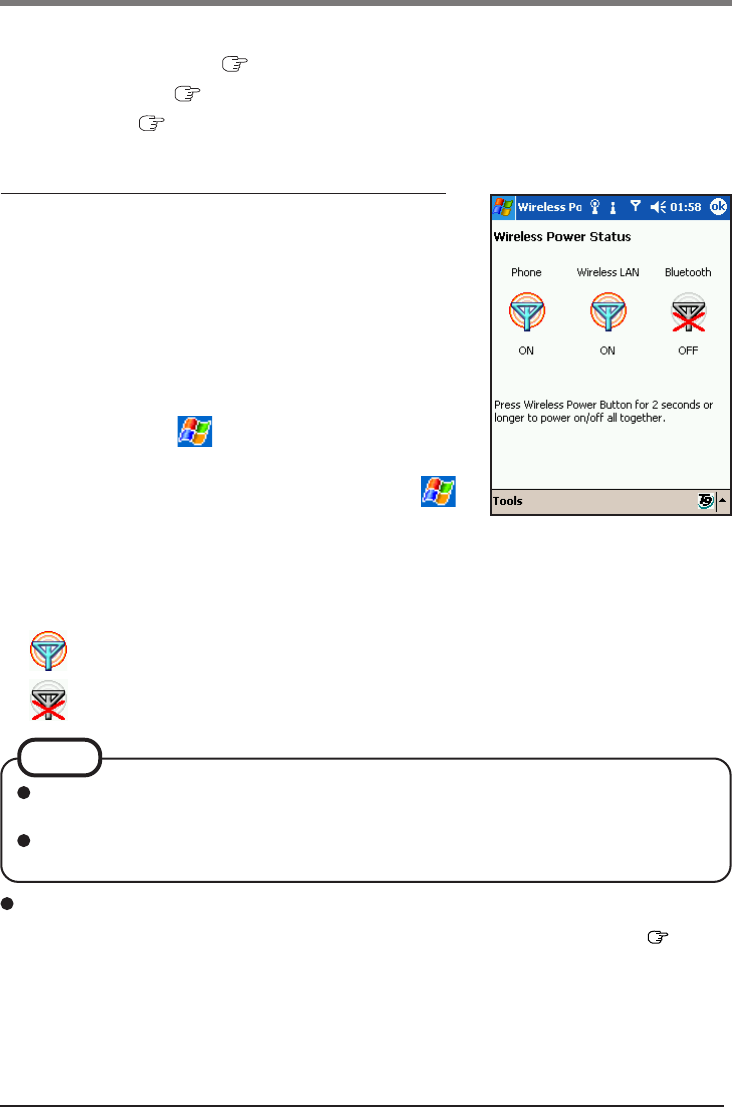
39
Wireless Functions
The following wireless functions are in CF-P2.
• GSM/GPRS(Phone) ( page 40)
• Wireless LAN ( page 43)
• Bluetooth ( page 49)
Changing the Wireless Power Status
Display the screen on the right, and confirm the switching
and status of the GSM/GPRS(Phone), Wireless LAN and
Bluetooth power supply.
1
Turn on CF-P2.
2
Lightly press the Wireless Power Button (within
0.5 seconds) to display [Wireless Power Status]
screen.
When also tapping - [Programs] - [Wireless Power],
[Wireless Power Status] is displayed.
If you change the program button assignment in -
[Settings] - [Personal] tab - [Buttons], [Wireless Power
Status] screen cannot be displayed.
3
Tap the icon for the function that you want to turn ON/OFF.
The icon will change as follows.
Power is on.
Power is off.
How to turn the Wireless power on/off using the Wireless Power Button
Display [Wireless Power Status] screen, and press the Wireless Power Button ( page 5)
more than 2 seconds.
•When there are wireless functions turned on, if you press the Wireless Power Button for
two seconds or more, all the wireless functions turned on will switch off. After that,
pressing the Wireless Power Button again for two seconds or more will turn on any
wireless function that were previously turned off. In this operation, only wireless func-
tions that were originally turned on will be returned to the “on” status.
The wireless power status may not be able to change immediately after the computer
resumes operations.
When turning a wireless function on/off, the wireless power status cannot be changed
even if you press the Wireless Power Button for two seconds or more.
NOTE
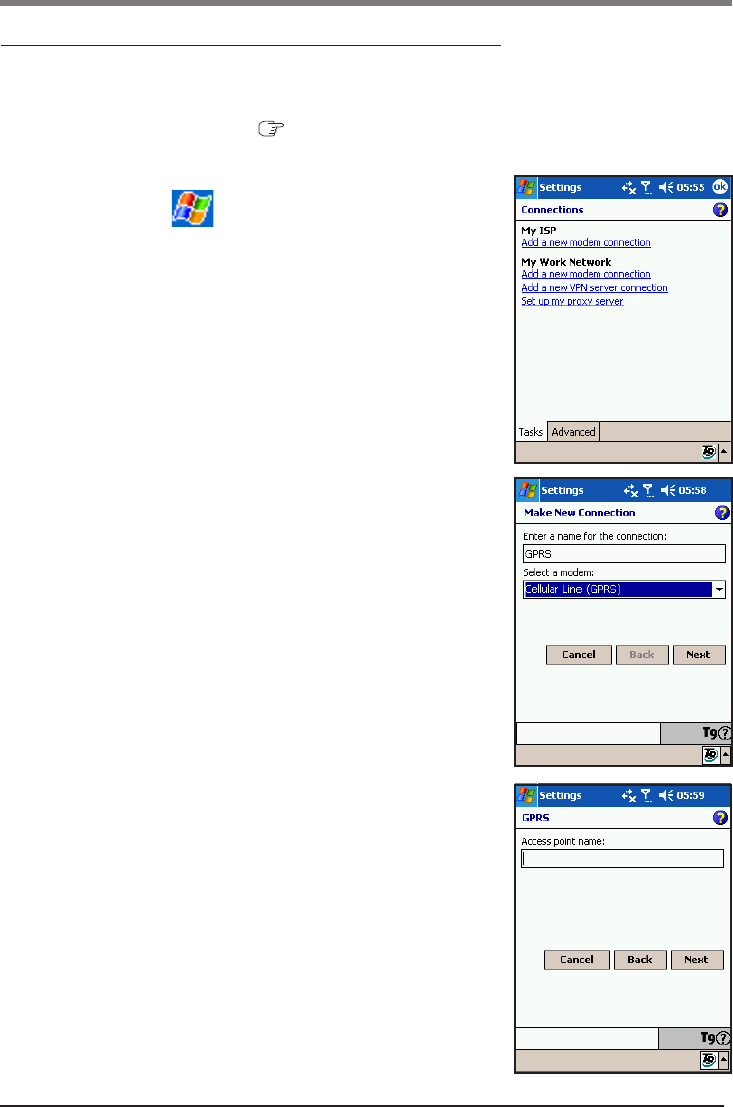
40
(3) Enter the suitable connection name and then select [Cel-
lular Line (GPRS)] at [Select a modem:], then tap
[Next].
The settings may vary with the local service provider. This information has to be requested
from the local provider. (The following sample screenshots illustrate the setup procedure.)
1
Turn your computer on ( page 11).
2
Set up the Remote Network.
(1) Tap, in order, - [Settings] - [Connections] tab -
[Connections].
(2) Tap [Add a new modem connection] at [My ISP].
Setting Up the Remote Network for GPRS
Wireless Functions
(4) Enter Access point name.
(5) Tap [Next].
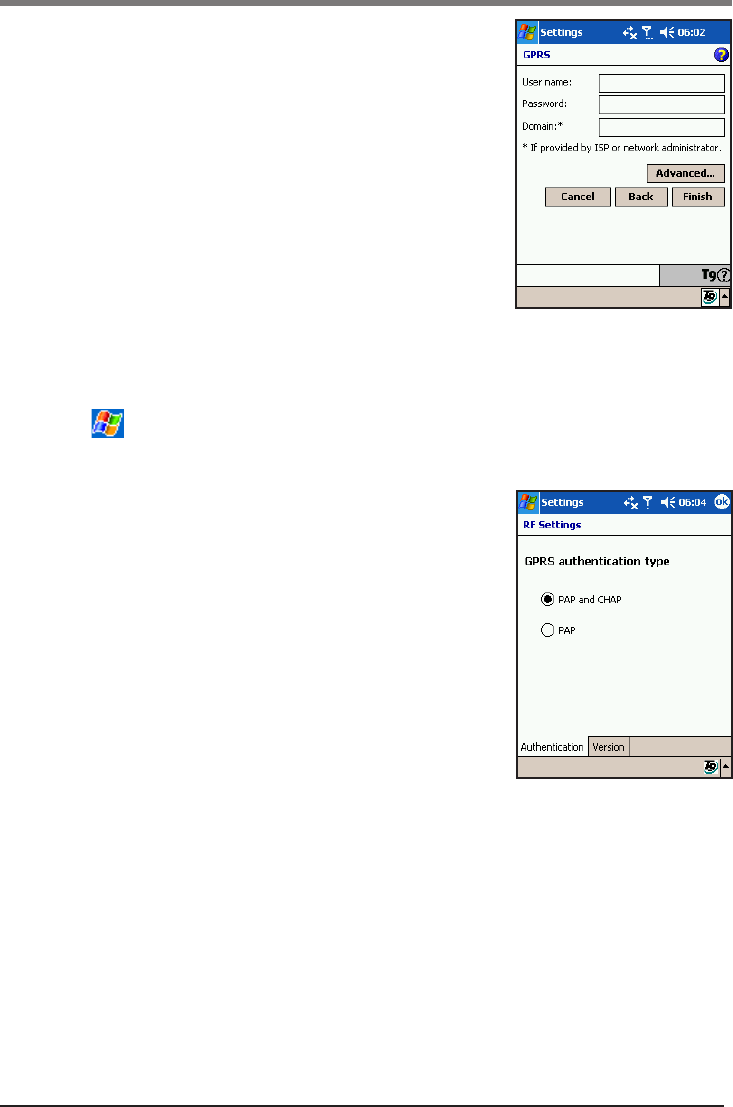
41
(6) Enter the user name and password, and enter domain if
provided by ISP or network administrator.
(Check with your network manager or the operator for
the SIM you are using to confirm the information to be
requested).
(7) Tap [Finish].
Wireless Functions
3
Set up the authentication type.
(1) Tap - [Settings] - [Connections] tab - [RF Set-
tings].
(2) Tap [Authentication] tab.
Select [PAP and CHAP] or [PAP].
The settings for the CSD are the same as the GPRS, except for
the following:
• Select [Cellular Line] instead of [Cellular Line (GPRS)].
• Set the number.
• Set the user name, password and the domain for the requested ISP.
(3) Tap [ok].
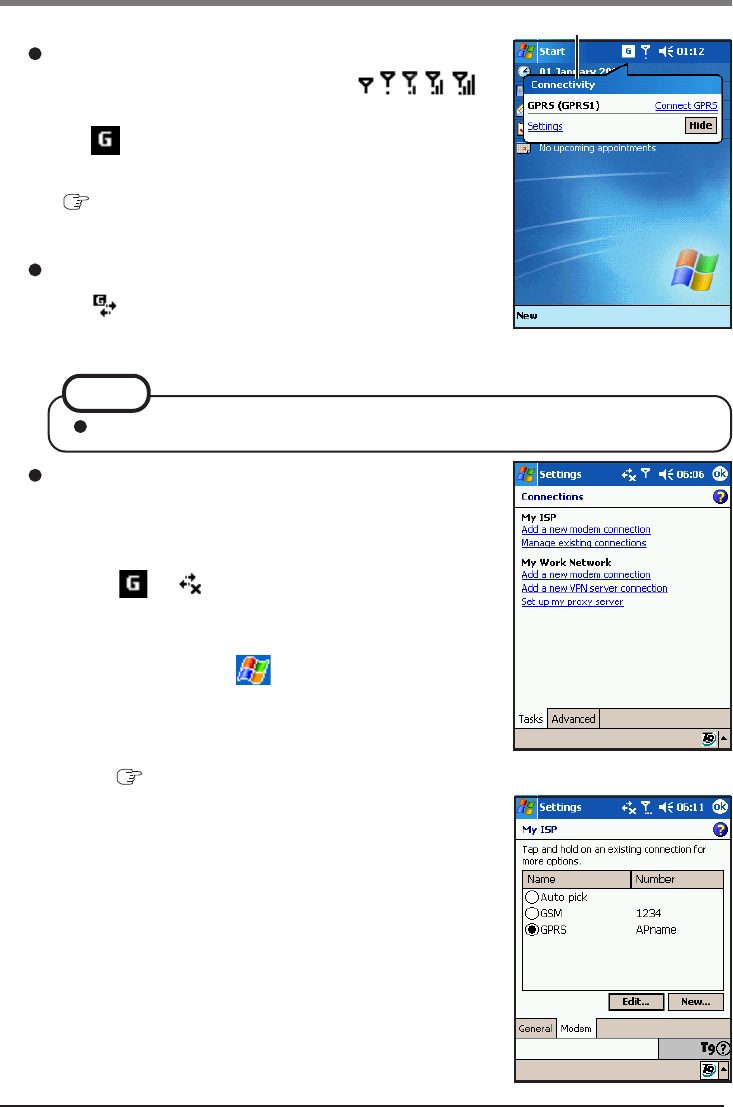
42
4
Connect /Disconnect to GPRS network
Connecting
Make sure that one of the five icons ( , , , , )
is displayed on the navigation bar.
Tap to display the Connectivity bubble (A).
Make sure that the name of the setting in step
2
(3)
( page 40) is displayed and tap [Connect GPRS].
The connection will start.
Disconnecting
Tap to display the Connectivity bubble and tap [Dis-
connect].
When multiple connection settings have been created,
the desired setting may not be selected using only the
operations described above. In this case, use the fol-
lowing settings.
(1) Tap or on the navigation bar then tap [Set-
tings] - [Connections] tab - [Connections] to display
[Connections] screen*1.
*1 You can also tap - [Settings] - [Connections]
tab - [Connections].
(2) Tap [Manage existing connections]*2 at [My ISP].
*2 This appears after setting the remote network
( page 40-41).
(3) Change the setting from [Auto pick] to a desired
setting (in this case, select GPRS).
Wireless Functions
(A)
NOTE
When pressing the ON Hook (End) Button, the GPRS network is also disconnected.
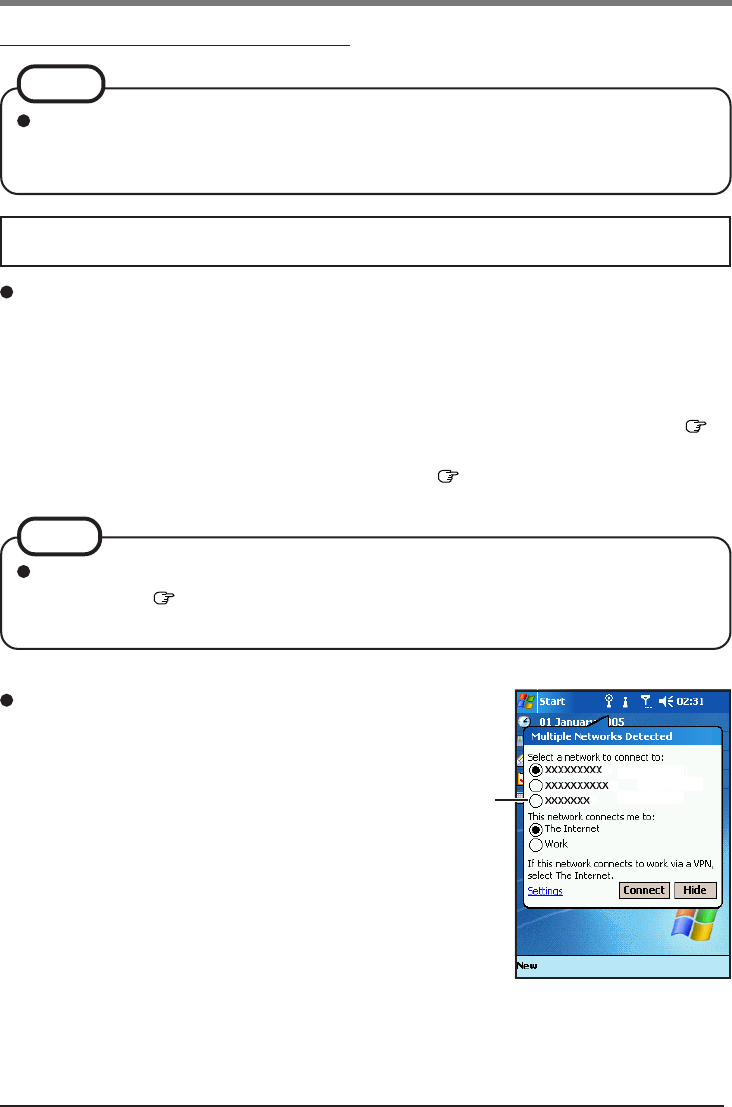
43
Wireless Functions
Connecting to Wireless LAN
After finishing the first-time operation, make a connection setting for Wireless LAN us-
ing the following procedure.
Automatic network detection
A connection manager periodically scans wireless networks for available connections. If
any networks are detected and no networks are connected yet, the connection manager
will try to connect with a more favorable network first. If such a network cannot be used
or the connection manager cannot connect with any suitable network due to an invalid
WEP key, the connectivity bubble (A) is displayed for manual network connection.(
below)
If you don’t see the suitable network, tap [Settings] ( page 44, step (3)) to display the
detailed configuration window.
Wireless LAN communications are done via an antenna. Do not shield this antenna
with the hand, etc. This will negatively effect the performance of your wireless LAN
communications.
NOTE
If the connection manager is able to connect to a network automatically, the connec-
tivity bubble ( below) will not appear, and you can follow the steps described in
page 44 step (3) to access the connection manager.
NOTE
Connect to a Wireless LAN
(1) Select a network to connect to and what the network
will connect to, then tap [Connect] from the connectiv-
ity bubble. (A)
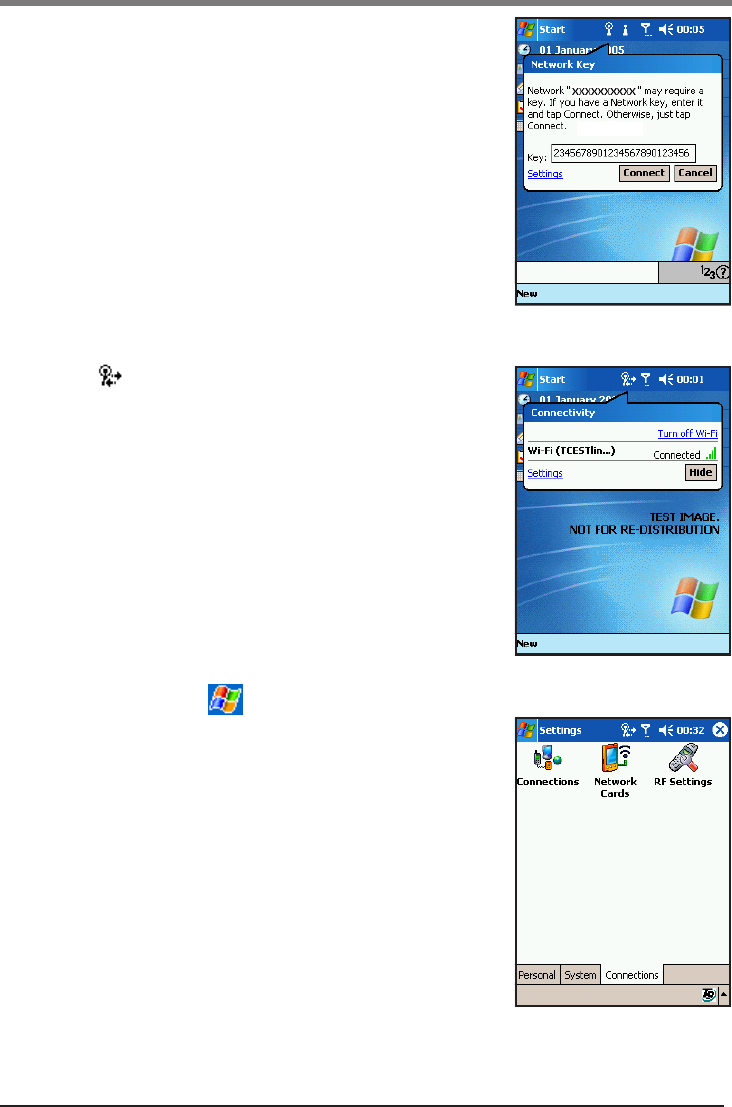
44
Wireless Functions
(2) If the connectivity bubble pops up as shown at right,
enter the WEP key, then tap [Connect].
(3) Tap to display the connectivity bubble.
(4) Tap [Settings] - [Network Cards]*1.
*1You can also tap - [Settings] - [Connections] tab
- [Network Cards].
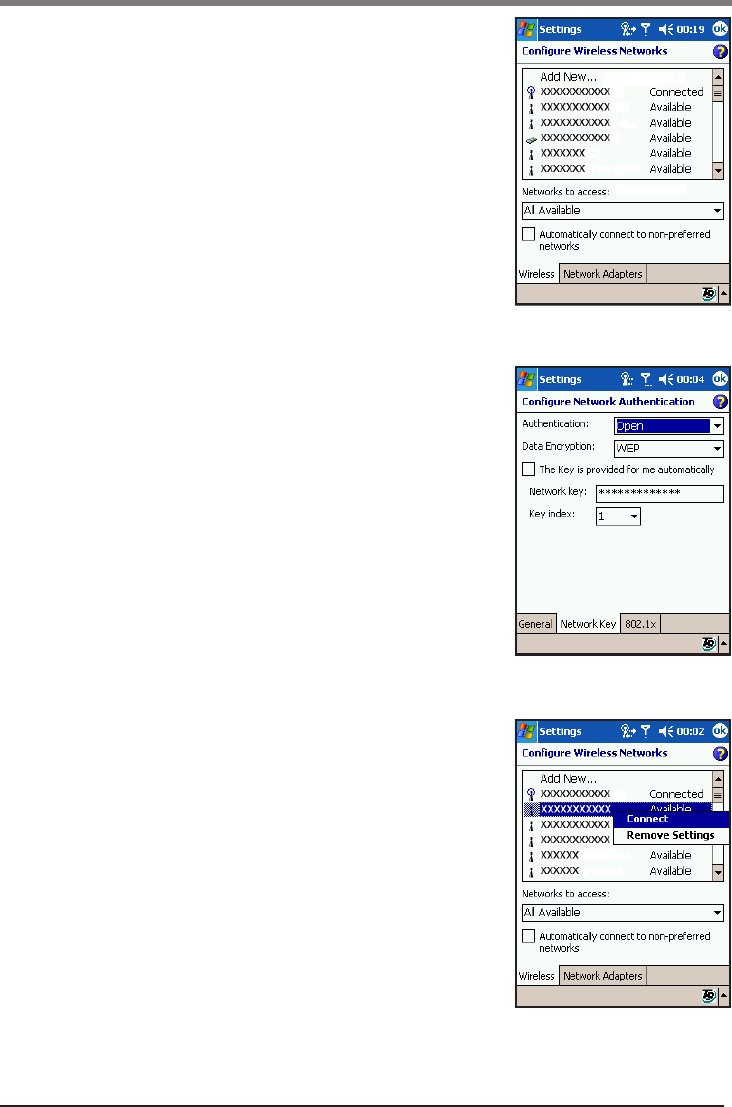
45
Wireless Functions
(5) At [Networks to access], select [All Available] or [Only
access points].
(6) Tap on the access point you want to connect to from the
list.
[Configure Wireless Network] screen will appear.
(7) Tap [Network Key] tab and select [Authentication].
If WEP is enabled:
Select [WEP] at [Data Encryption].
Enter the key string in [Network key] and select [Key
index], then tap [ok].
If WEP is not enabled:
Tap [ok] to return to the previous screen.
(8) Tap and hold on the access point you want to connect
to, and tap [Connect] on the popup menu.
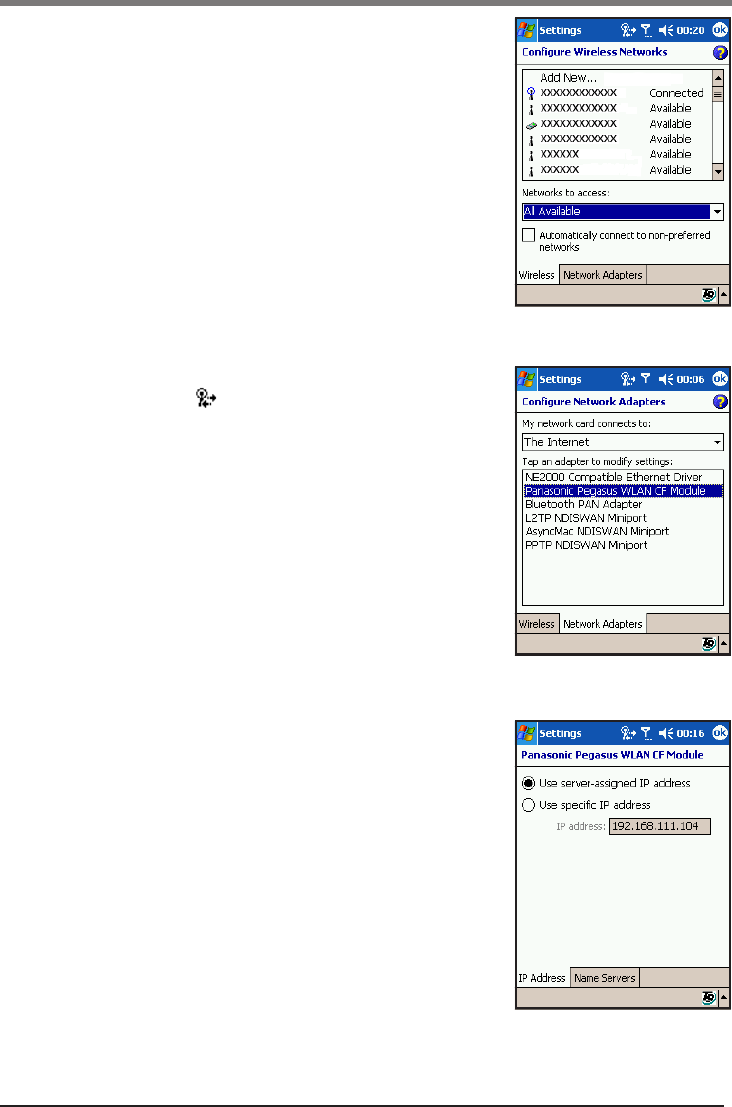
46
Wireless Functions
(9) The screen will be updated to show the new connection.
(10) If the CF-P2 is not connected with a host computer via a
sync cable, then on the navigation bar normally in-
dicates the Wireless LAN connection is properly estab-
lished.
You can also check on [Network Adapters] tab to check
if the IP address obtained from DHCP is correct.
(11) Tap [Panasonic Pegasus WLAN CF Module] to see the
IP address information.
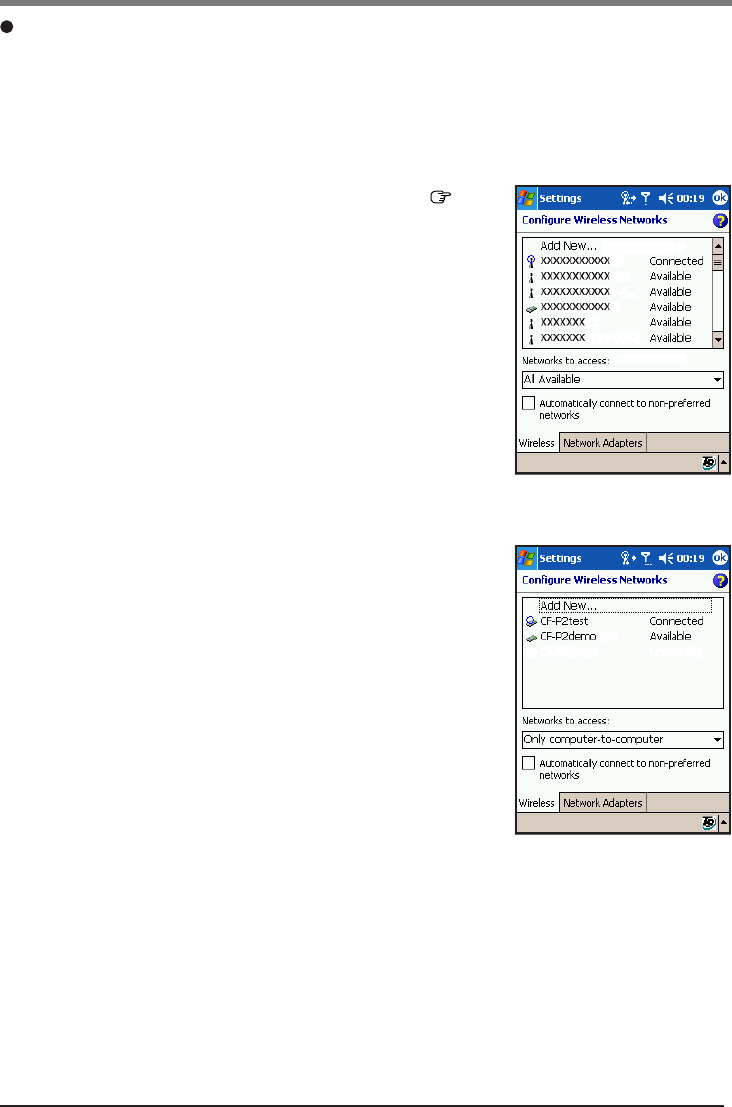
47
Wireless Functions
Peer to peer mode
The Peer-to-peer mode is also known as the “Ad-Hoc” mode. There are two ways to con-
nect CF-P2 with other devices in the peer-to-peer mode. The first way is to create an Ad-
Hoc network on CF-P2, then allow other devices to connect to CF-P2 by joining the net-
work. The second way is simply by connecting CF-P2 to an existing ad-hoc network if the
peer device has already created such a network.
(1) Display [Configure Wireless Networks] screen ( page
44 step (4)). At [Networks to access], select [Only com-
puter-to-computer].
(2) Select [Add New… ] from the list.
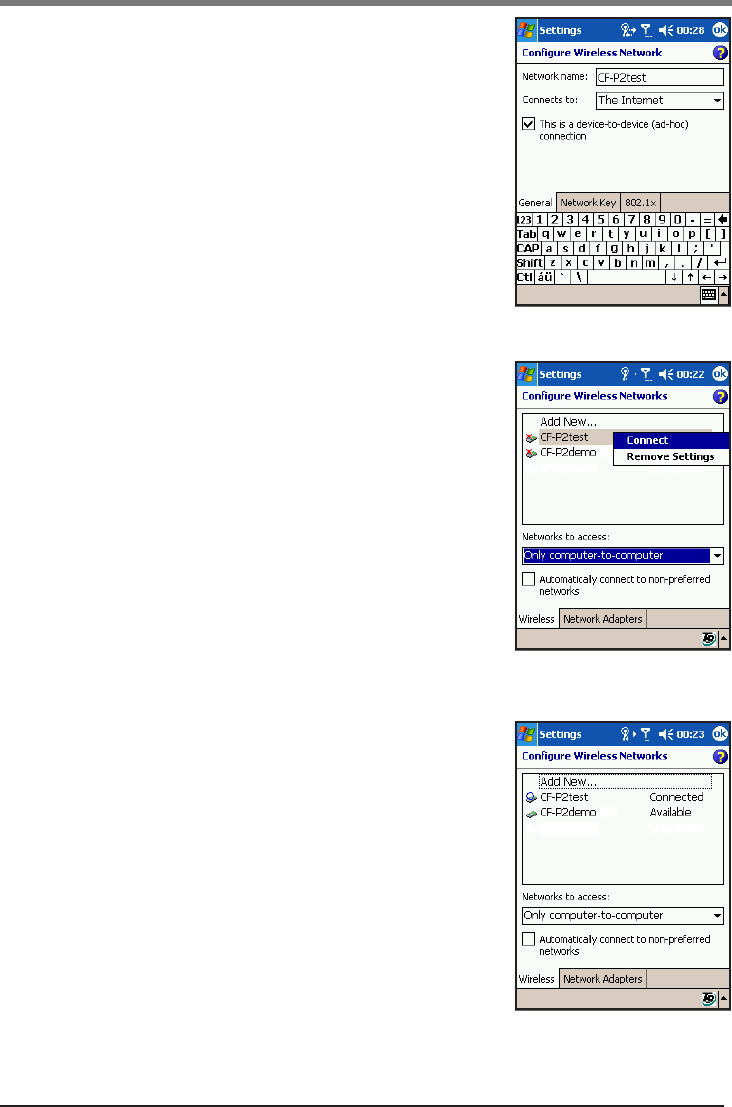
48
Wireless Functions
(3) Type in the network name in [Network name] (CF-P2test,
for example). Then add a checkmark for [This is a de-
vice-to-device (ad-hoc) connection].
Ad-hoc channel is assigned automatically.
(4) Tap [ok] to return to the previous screen.
(5) Tap and hold the network name and tap [connect].
(6) Now the new ad-hoc network has been created, and
it is visible to other Wireless LAN devices.
CF-P2 is connected to the ad-hoc network.
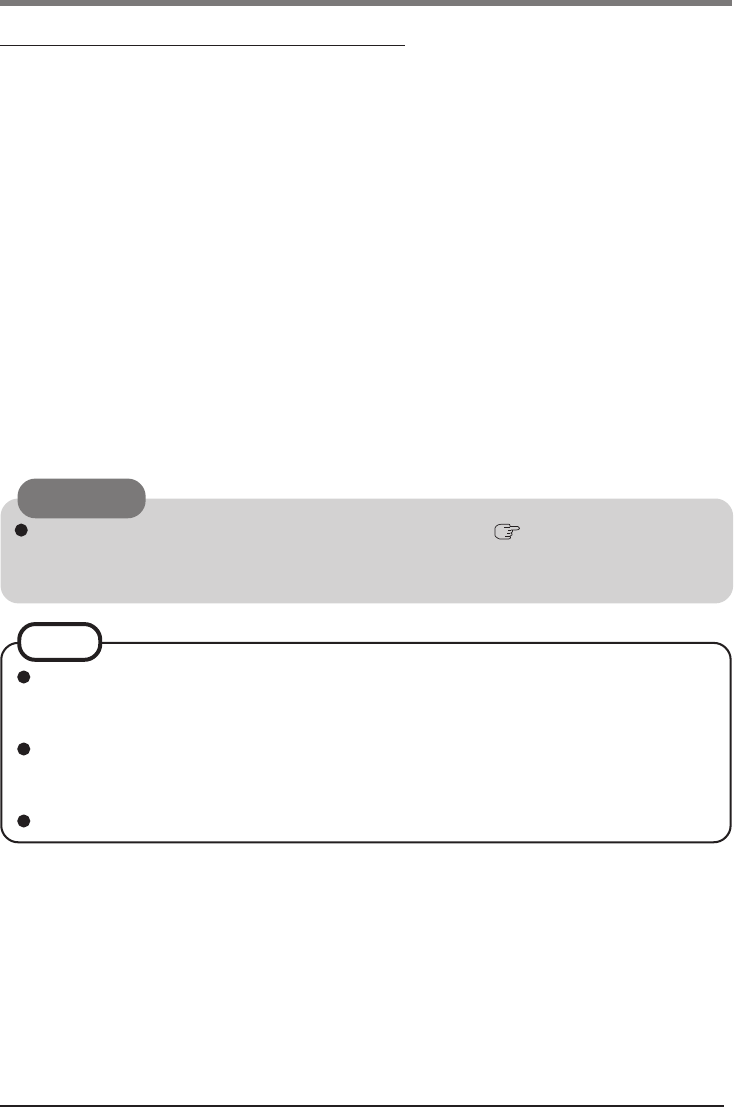
49
Bluetooth is a technology which enables wireless communication. With Bluetooth, you can
access internet or exchange data with other Bluetooth devices (e.g., computer, mobile phone,
access point) without connecting cables.
Bluetooth Specification
• Bluetooth Specification V1.2 Compliant
• Power class: Class 1
• Point to point connection
Bluetooth Services
• Serial Port Profile (Client and Server)
• Object Push Profile (Client and Server)
• File Transfer Profile (Client and Server)
• Headset Profile (AG and HS)
• Dial-up Networking Profile (Client)
• LAN Access Profile (Client)
• Personal Area Network Profile (User)
• Hands free Profile (AG)
CAUTION
Communications are conducted via a Bluetooth antenna ( page 6).
Do not do anything to block the radio waves, for example by obstructing the antenna
segment with your hand.
Communication speeds and distances may vary depending on surrounding conditions,
such as the other device sending or receiving communications and the installation envi-
ronment.
It is a characteristic of radio waves that communication speeds will tend to decrease as
the communication distance increases. We recommend that communications between
Bluetooth devices be conducted in as close proximity as possible.
Communication speeds may decrease if a microwave oven is being used nearby.
NOTE
Wireless Functions
Connecting to Bluetooth Devices
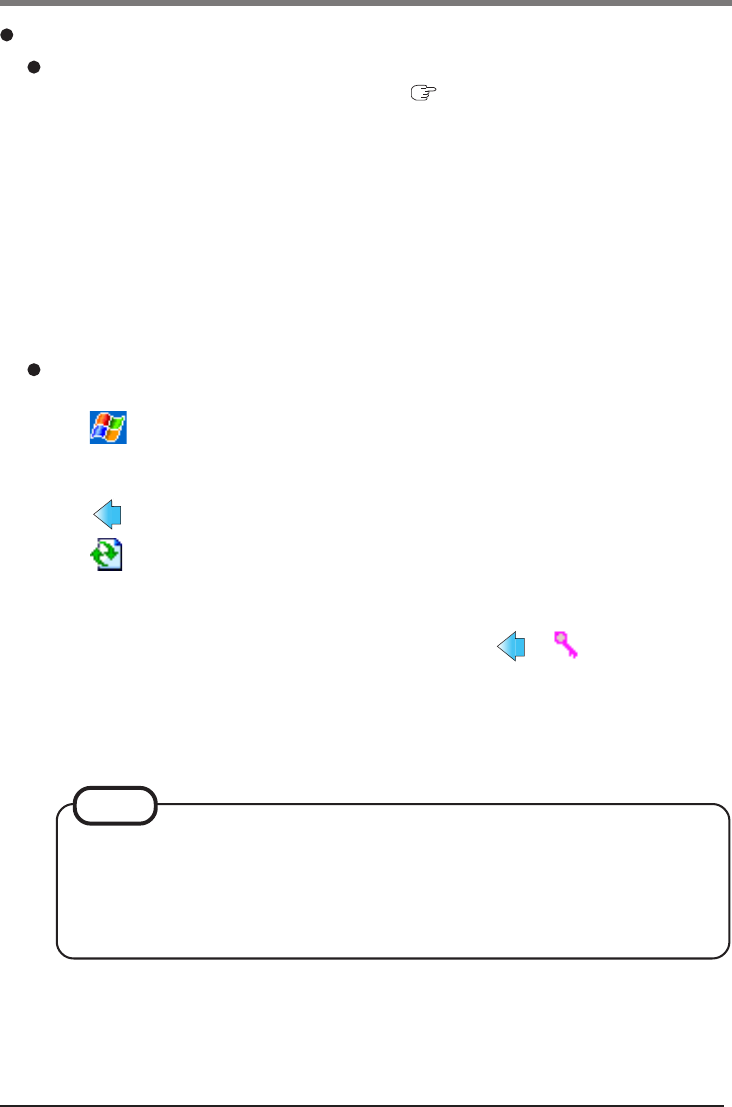
50
Setting with the host computer
(1) Conduct steps
1
to
7
to install ActiveSync® ( page 36).
After step
7
, at [Set up a Partnership], select [Guest partnership] and follow the on-
screen instructions.
(2) After completing installation of ActiveSync®, disconnect the cable.
(3) On the ActiveSync® screen, select [File] - [Connection Settings].
(4) Add a check mark for [Allow serial cable or infrared connection to this COM port:].
(5) Select the same number for the COM port displayed as the following procedure.
Select [start] - [All Programs] - [My Bluetooth Places], then select [Bluetooth] (dis-
played under the title bar) - [Advanced Configuration] - [Local Services] - [Bluetooth
Serial Port].
(6) Restart the computer.
Setting with the CF-P2
(1) Make sure that Bluetooth is powered on.
(2) Tap - [Programs] - [Panasonic Bluetooth] - [My Device] - [My Services].
Be sure to remove the check mark from [Network Type ActiveSync], and add a check
mark for [Serial Port Type ActiveSync], then tap [OK].
(3) Tap on the command bar to return to the previous screen.
(4) Tap (Refresh Button) on the command bar to search for devices within range.
(5) Tap on the host computer that is going to be connected.
(6) Tap and hold [Bluetooth Serial Port] and tap [Use to connect for ActiveSync].
If you use ActiveSync® via a USB Autosync cable, tap or - [Disconnect] on
the command bar to disconnect the Bluetooth connection.
(7) Enter the PIN code.
After entering the passkey in CF-P2, a message will appear in the host computer,
indicating that Bluetooth PIN code is required. Follow the on-screen instructions in
the message and enter the same code in the host computer.
PIN Code (= passkey)
A PIN Code is a password for which you can set up to 16 alphanumeric characters.
When establishing security settings, the PIN Code for the device to be connected
(slave) must be the same as the PIN Code for the device where the connection
originates (master).
NOTE
(8) Synchronization will start in ActiveSync®.
Wireless Functions
Serial Port Type ActiveSync®
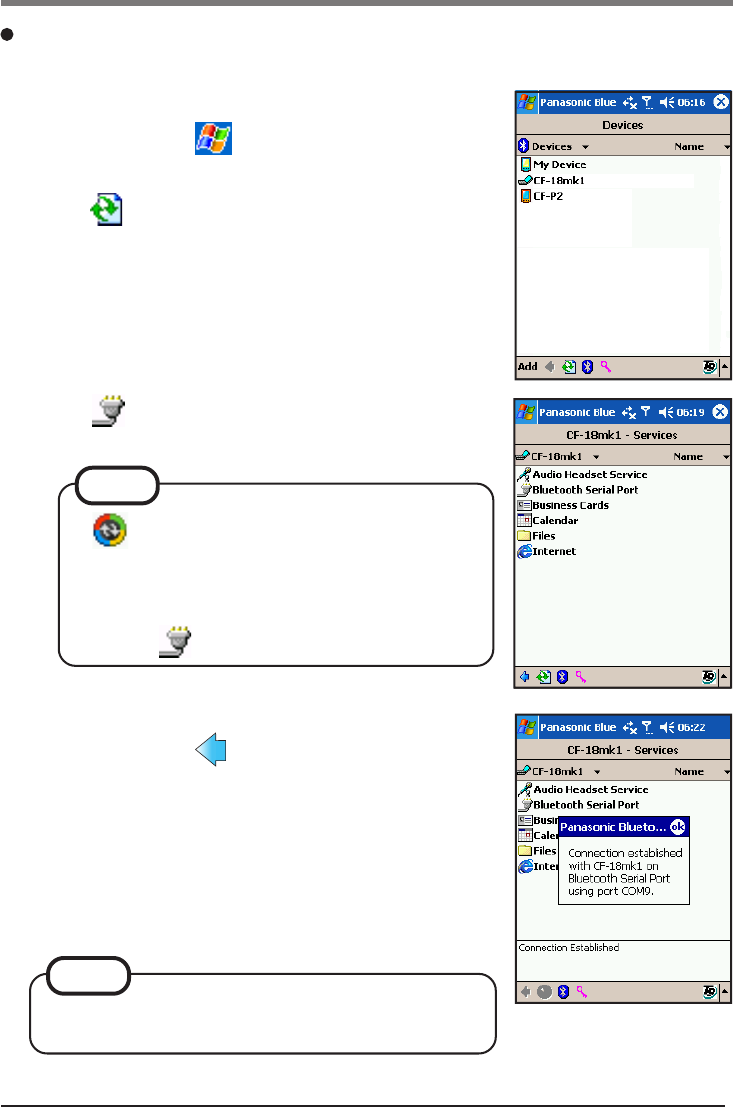
51
(1) Make sure that Bluetooth is powered on.
(2) Tap, in order, - [Programs] - [Panasonic
Bluetooth].
(3) Tap (Refresh Button) on the command bar to search
for devices within range.
(4) Tap the target device from a device list.
(5) Tap (This icon indicates a serial port) from a ser-
vice list to connect the target device via the serial port.
(6) This message at right will be displayed.
Tap [ok] and tap on the command bar to discon-
nect the Bluetooth connection.
(7) Start an appropriate software. (i.e. printer application)
(8) Set the COM port to COM9 (default).
(9) Open the COM port using the software.
The Bluetooth connection with the target device will
be automatically established.
NOTE
CF-P2 can be connected to the device from next time with-
out the need to set steps (1) to (6) again.
Use this setting when using Bluetooth intermittently (i.e. Printer application).
Wireless Functions
Establishing the Bluetooth Connection by Opening the COM Port
If (ActiveSync® icon) is displayed at [Bluetooth
Serial Port], tap and hold [Bluetooth Serial Port]
and then tap [Do not use to Connect to ActiveSync]
to display .
NOTE
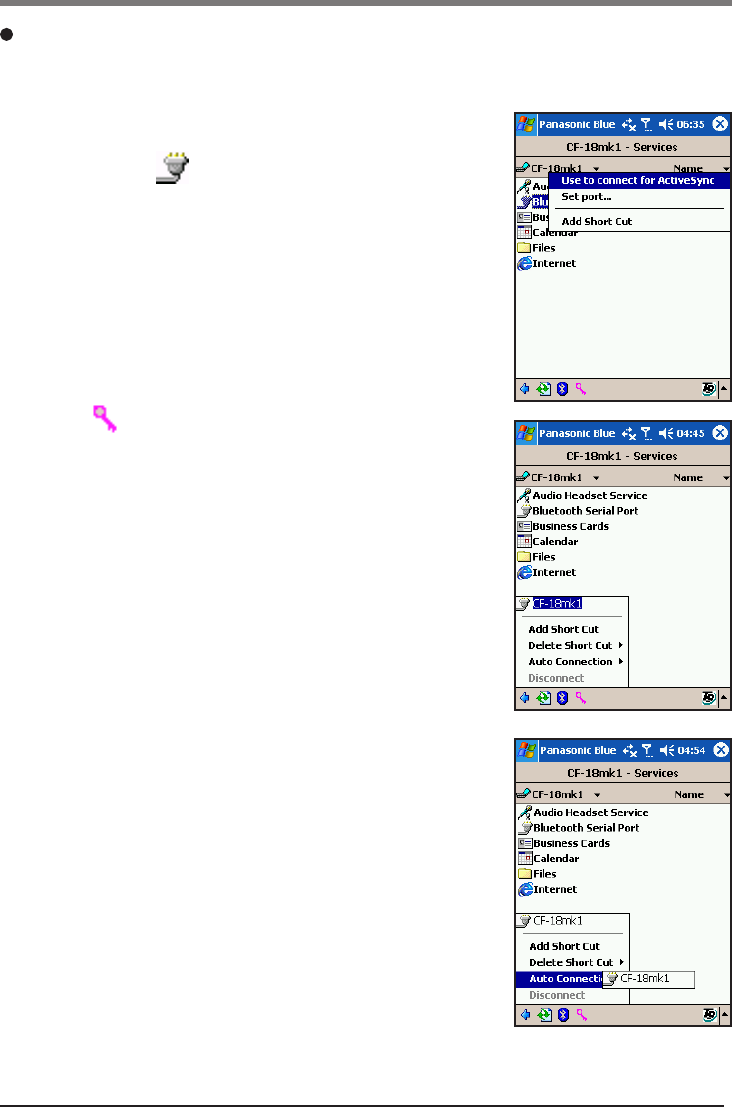
52
(1) Refer to page 51 and conduct steps (1) to (4).
(2) Tap and hold (This icon indicates a serial port) from
a service list.
(3) Tap [Add Short Cut] to set a short cut.
(4) Tap on the command bar and then, tap [Auto Con-
nection].
(5) Tap the target device.
After starting up Panasonic Bluetooth next time, the
Bluetooth connection with the target device will be au-
tomatically established.
Use this setting when using Bluetooth continuously after starting up CF-P2 (i.e.
GPS application).
Wireless Functions
Establishing the Bluetooth Connection by setting ‘Auto Connection’
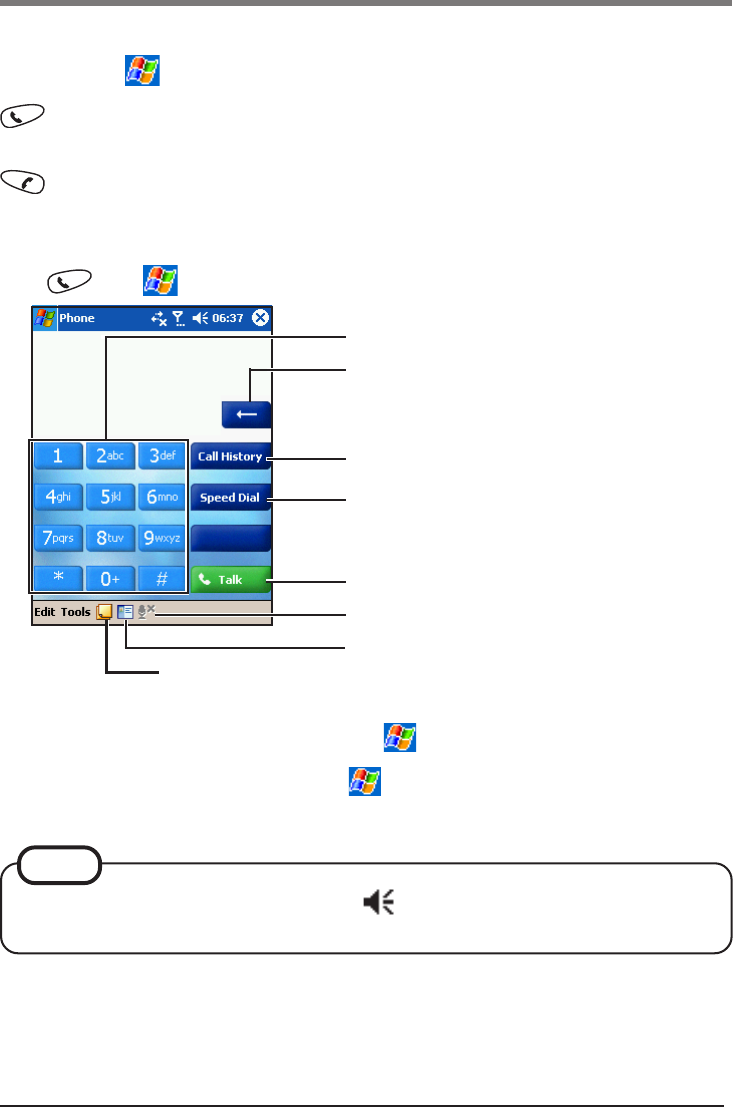
53
Dialer and Telephony
You can send and receive phone calls or messages using CF-P2. This section explains
Messaging, phone settings, and how to make and receive phone calls.
For details, tap - [Help] - [Phone].
: If pressed when the [Phone] screen is not displayed, the [Phone] screen
will be displayed. If pressed when the [Phone] screen is displayed,
you can send a call.
: When pressed during the call, the call is hung up. When using this in
other cases, [Today] screen is displayed.
Numeric Keypad
Press or tap - [Phone] to display the [Phone] screen shown below.
Back one character
Call History
Speed Dial
Make call button
Create New
Note
View Contacts
Mute/Unmute
Contacts maintains a list of friends, colleagues
and customers so that you can easily find the in-
formation you are looking for.
Tap - [Contacts] to create or change a con-
tact, or add a note to a contact. For details, tap
- [Help] - [Contacts].
( )
Off Hook (Talk)
Button
( )
On Hook (End)
Button
When pressing this key for a longer period, the
input words will be erased.
NOTE
If you cannot adjust the volume by tapping on the navigation bar when making and
receiving calls, press the Volume Up/Down Buttons.
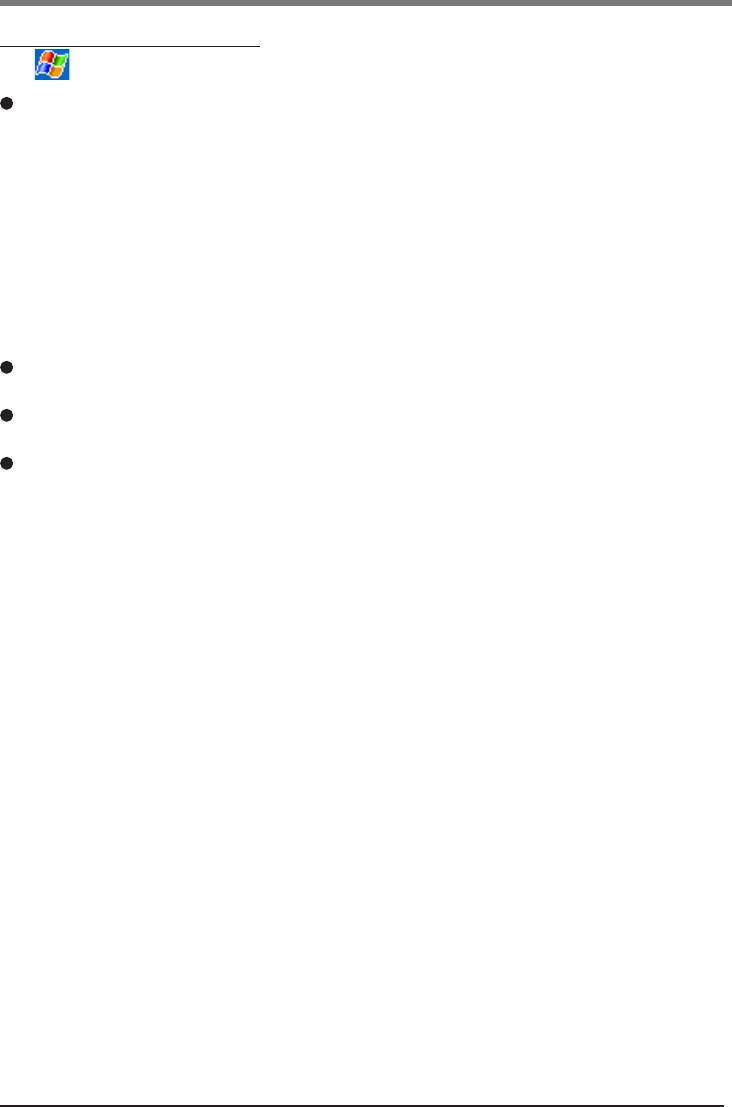
54
Dialer and Telephony
Setting of the phone
Tap - [Settings] - [Personal] tab - [Phone].
[Phone] tab: Select the type and tone of ring or vibration you want to receive for an
incoming call. Choose to hear touch tones or beeps when you press the
keyboard.
You can also protect your phone from unauthorized use. For security, add
a check mark for [Require PIN when phone is used].
• When inputting the PIN code, if the [Cancel] button is tapped, the Phone
function cannot be used. To use the Phone function, perform the follow-
ing.
• Press the Wireless Power Button to display [Wireless Power Status]
and tap [Phone] to turn the power off. Tap [Phone] again to turn the
power on.
[Service] tab: Set for Call Barring, Caller ID, Call Forwarding, Call Waiting, Voice Mail
and SMS.
[Network] tab: Select [Automatic] to seek out available networks or select [Manual] to
select them yourself.
[More] tab: Select time before answering incoming calls automatically. (Only use when
connected to a headset or car kit.) Also, set whether system sounds will be
muted during phone calls.
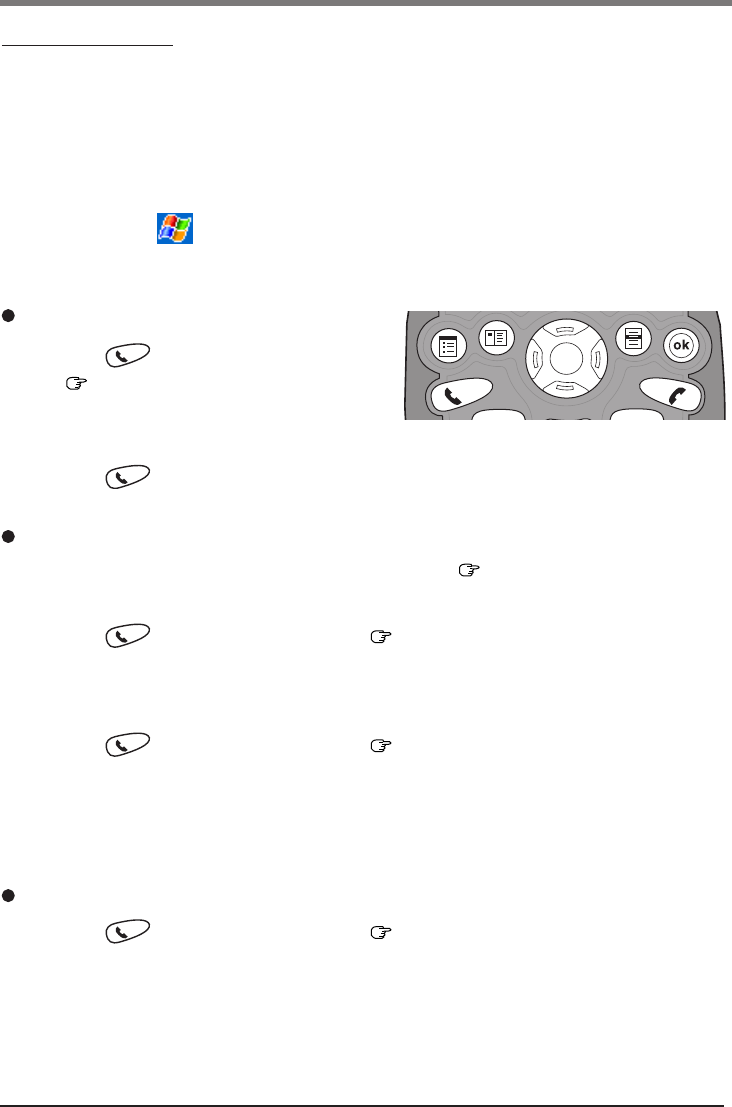
55
Dialer and Telephony
Making calls
You can make phone calls using any of the following four methods.
• Using the keyboard
• Using Speed Dial
• From Call History
• From Contacts
For details, tap - [Help] - [Phone].
The phone function starts when you press a number key if the [Today] screen is displayed.
Using the keyboard
1
Press to display [Phone] screen
( page 53).
2
Enter a phone number using the numeric
keypad.
3
Press .
Using Speed Dial
You need to add Speed dial before using this function ( page 57).
• Using a keyboard
1
Press to display [Phone] screen ( page 53).
2
Press the registered number for more than one second.
• Using cursor control
1
Press to display [Phone] screen ( page 53).
2
Press the down cursor control to display [Speed Dial], and select a phone number
using up/down cursor control.
3
Press center of the cursor control.
From Call History
1
Press to display [Phone] screen ( page 53).
2
Press the up cursor control to display [Call History], and select a phone number using
up/down cursor control.
3
Press center of the cursor control.
3
1
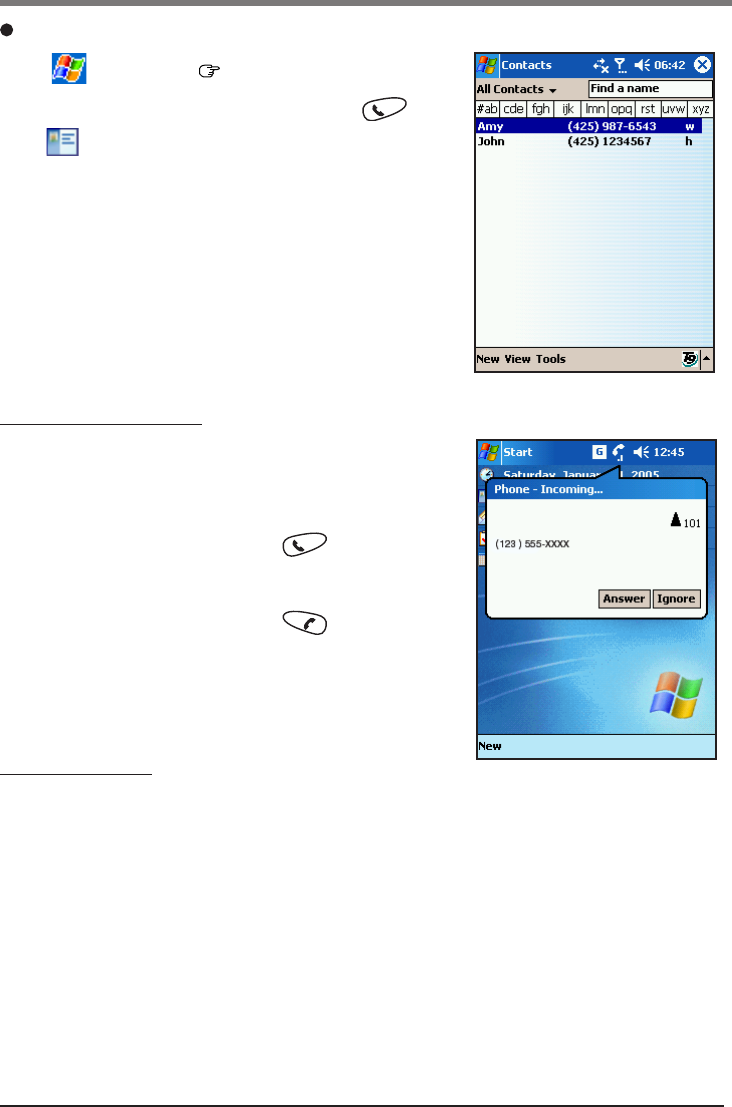
56
Dialer and Telephony
From Contacts
Tap - [Contacts] ( page 53).
You can also display Contacts by pressing and
tap .
Tap and hold on the person you want to call, and tap
the field from work, home or mobile phone number
you want to call. (depending on which fields have been
filled in.)
Tap on the person you want to call; you can then select
a number from among those displayed, and tap on the
number you want to call.
Receiving calls
When receiving a call, the phone will ring and/or vibrate
as configured, and a notification bubble will pop up with
caller-ID information.
When you answer the phone, press or tap
[Answer].
When you ignore the phone, press or tap
[Ignore].
Messaging
You can receive Internet e-mail messages and text messages in Messaging. Internet e-mail
messages are sent by using and address you receive from your Internet service provider (ISP)
or your employer. Text messages are sent and received through your wireless phone service
provider by using a phone number as the message address.
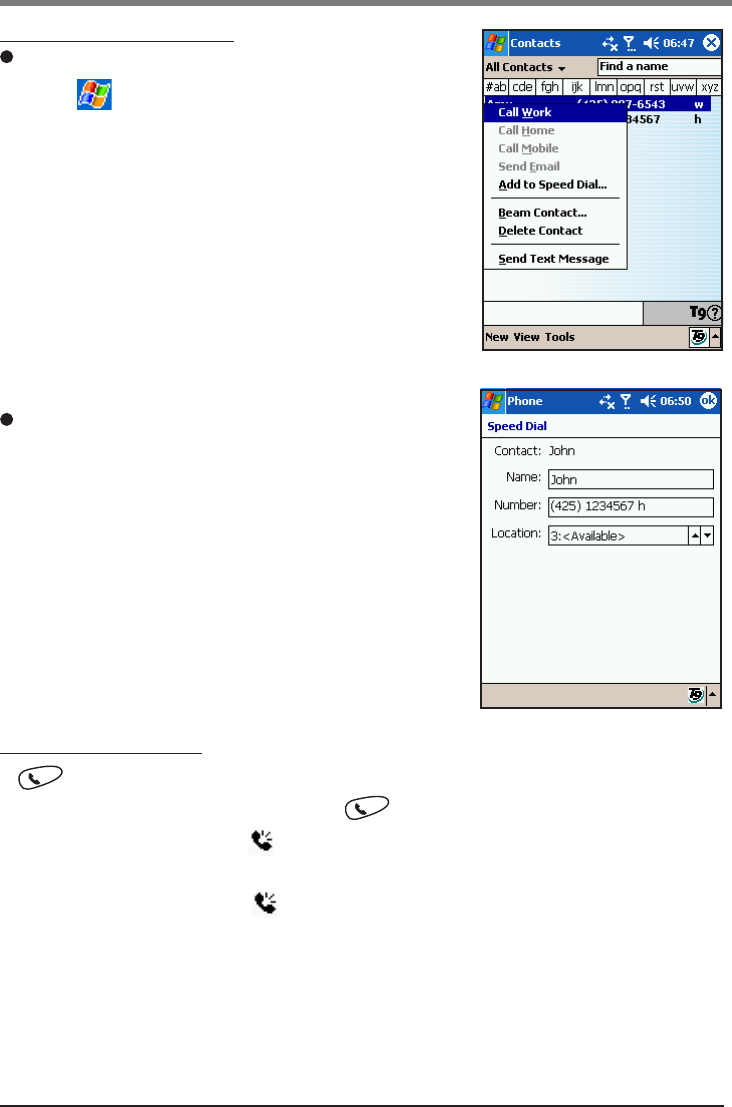
57
Dialer and Telephony
To add Speed Dial
From Contacts
(1) Tap - [Contacts], and tap and hold the contact
who you want to add.
(2) Tap [Add to Speed Dial...].
Change the settings if required, and tap [ok].
From Phone
(1) On the [Phone] screen, tap [Speed Dial] - [New].
(2) Tap one of the contacts who you want to add.
Change the settings if required, and tap [ok].
Speaker Phone
If is pressed down for more than 2 seconds during a phone call, it becomes a speaker
phone. To return to previous setting, press more than 2 seconds again.*1
• When the speakerphone is on, will appear on the navigation bar and the message [Speaker
phone is on] will appear.
• When a speakerphone is off, will disappear from the navigation bar and the message
[Speakerphone is off] will appear.
*1 When connected to such an external audio device as a Bluetooth headset, car kit, etc., the speaker-
phone will not work.
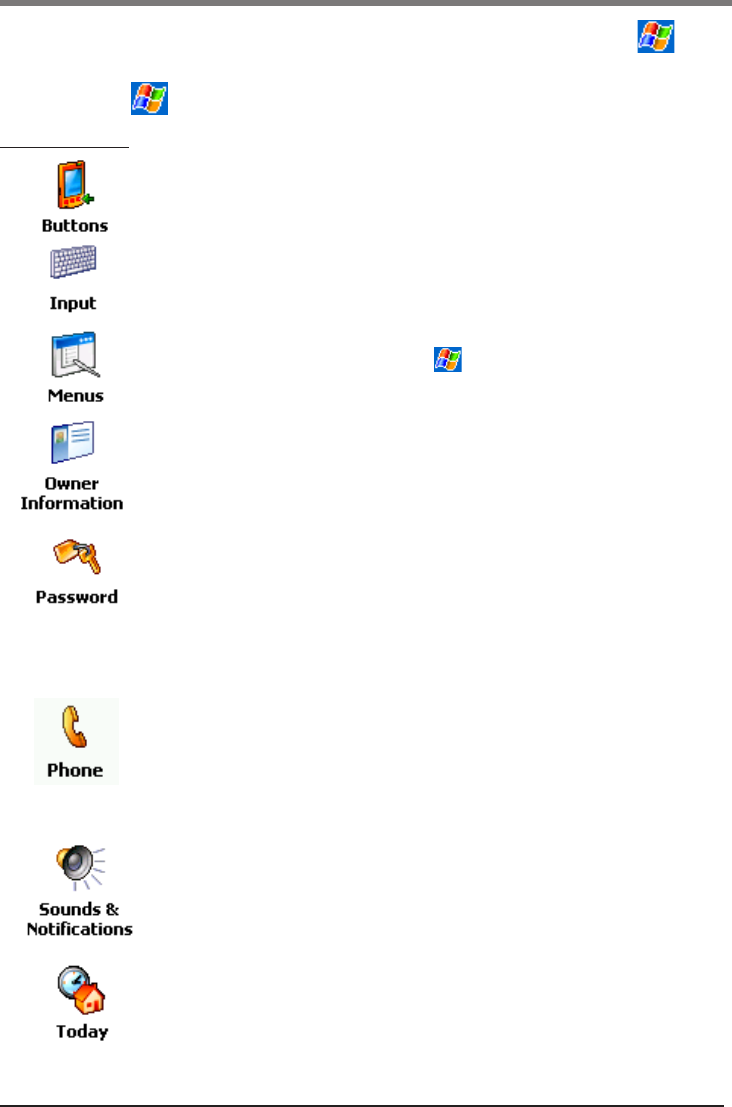
58
Customizing the Computer
If you want information on the various individual settings of the computer, tap - [Set-
tings] and then tap the item (icon) you want to check.
(For details, tap - [Help] - [Settings].)
Buttons
Program buttons and the cursor control settings.
Input
Input panel (soft keyboard or letter recognizer, etc.) settings.
Menus
Select programs to be displayed in , or items to be displayed in [New]
in the Today screen.
Owner Information
Registration (or changing) of the user’s (owner’s) personal information.
You can choose to display the registered owner information on the screen
when CF-P2 is turned on.
Password
Password enable/disable, and a password hint setting.
If a password is set, it has to be input in order to open the password
screen. When the wrong password is input four times, the set hint is dis-
played. At times certain characters, such as á and ü, cannot be input from
the numeric keypad. Use the soft keyboard.
Phone
Customize phone settings, such as the ring type and ring tone to be
used for incoming calls, and the numeric keypad tone to be used when
entering phone numbers. You can also protect your phone from unau-
thorized use.
Sounds & Notifications
Operation sound setting.
Specific sound settings to be generated in a wide range of situations.
Today
Desktop display setting.
Personal
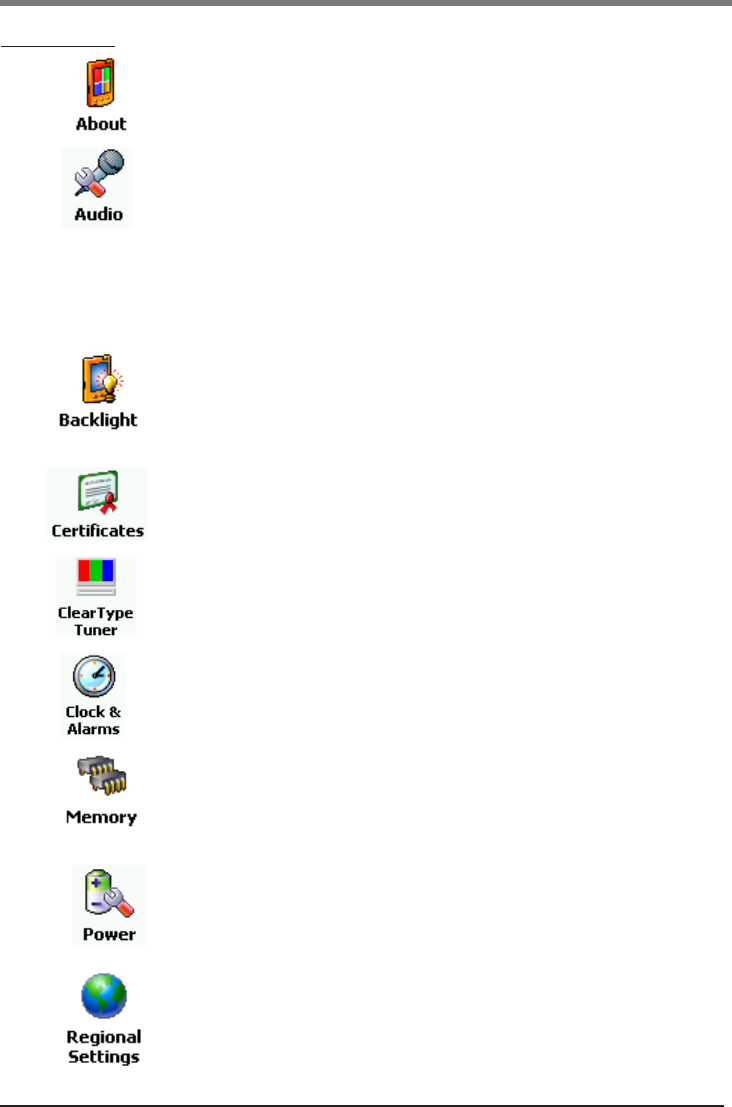
59
About
Display of release version and copyrights, and device ID setting.
Audio
Mute car audio when playing sound*1. Select the check box to use Head-
set/Headphone*2, using built-in microphone. On [Record] tab, select [Use
ALC] radio button when you use Automatic Level Control (ALC), or
select [Manual] radio button and move the slider to select the record gain
level.
*1 Use this setting when installed to the car kit (sold separately).
*2 This setting does not apply to Bluetooth headset.
Backlight
LCD backlight timeout function, tap-induced backlight on and LCD
brightness adjustment manually or automatically.
Certificates
Add and delete personal certificates and root certificates.
ClearType Tuner
Make a text clear by moving the slider.
Clock & Alarms
Time/date settings and alarm settings.
Memory
Computer memory assignment possible (assignment of memory for data
memory and memory for program execution). Display of total storage
card memory if it is installed. Activate or stop the running programs.
Power
Current battery charge status and automatic power off time setting, and
set the power supply from PC by USB cable when using ActiveSync®.
Regional Settings
Display methods of the region, number system, currency, time, and date.
Customizing the Computer
System
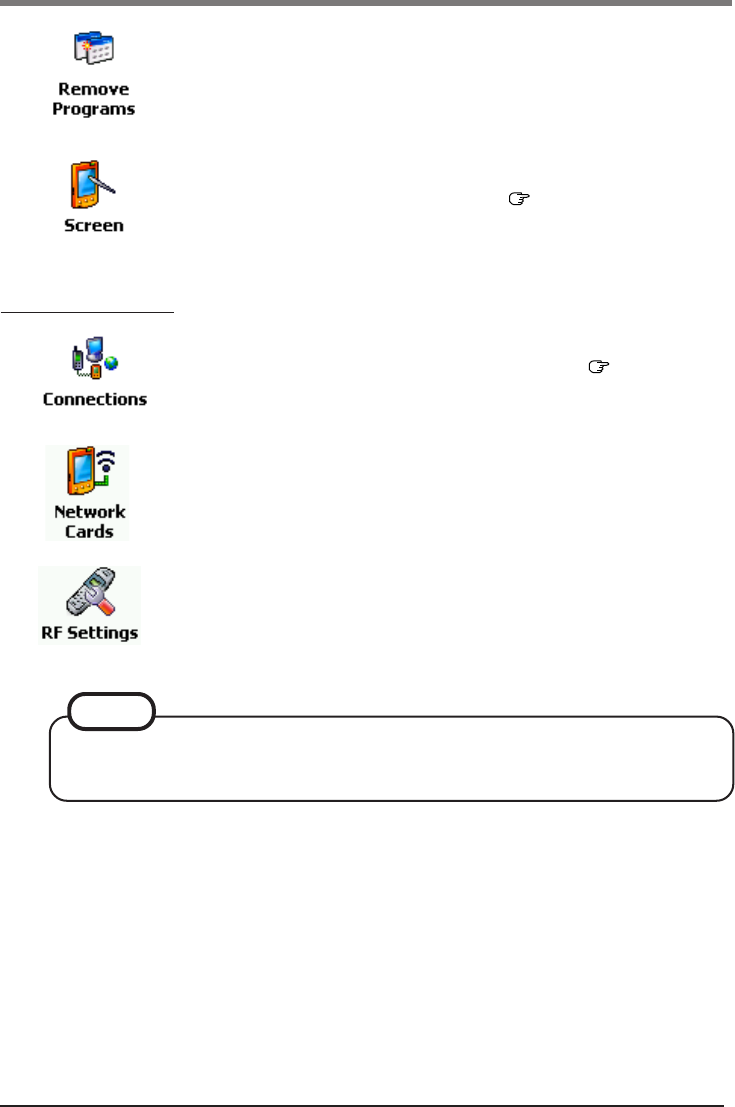
60
Connections
Remove Programs
Remove programs in storage memory.
Screen
Screen orientation. Touchscreen alignment ( page 18), ClearType and
text size settings.
Connections
Internet connection and Intranet connection settings ( page 35).
Network Cards
Set up a wireless network.
RF Settings
Select a radio button for GPRS authentication with [Authentication] tab.
You can confirm the radio driver version and stack version with the
[Version] tab.
Customizing the Computer
NOTE
CF-P2 does not support IrDA. For example, the connection will not work even if
you select [Beam File…] from the Context menu.
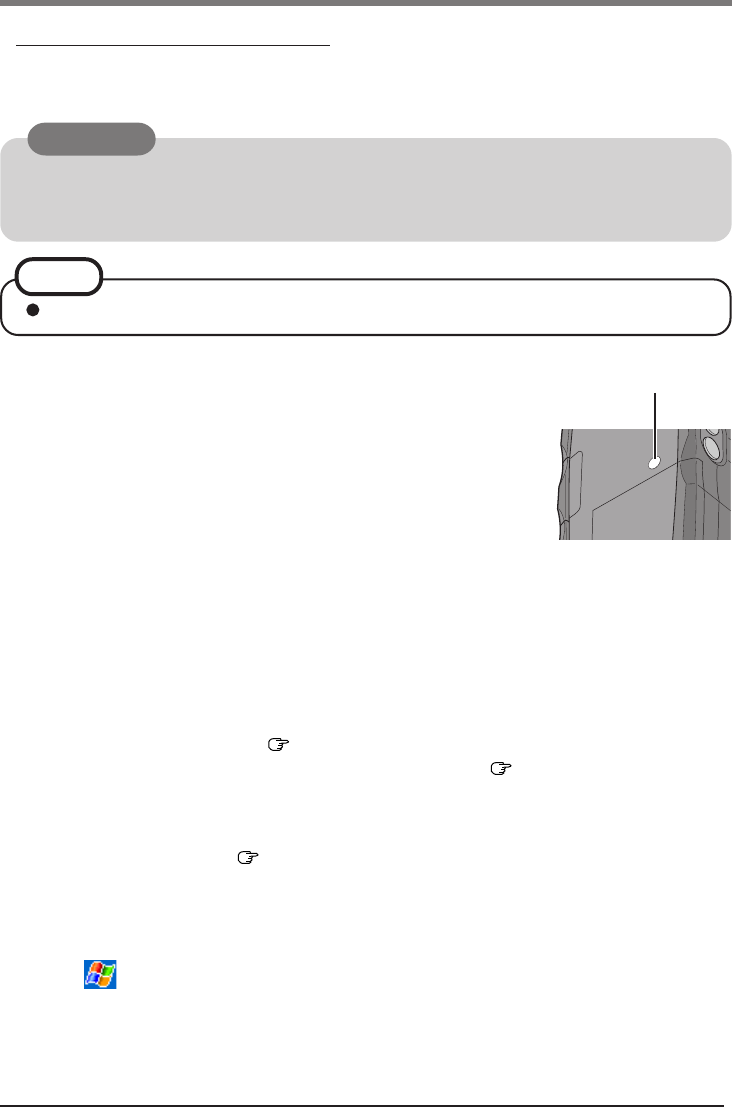
61
Performing a Reset
This selection saves all stored records and entries and then restarts
the computer.
Unsaved data in open windows may be lost.
If possible, turn off the computer and push the center of the reset
switch straight in.
Push the reset switch within 1 second using the stylus.
Resetting the computer may cause the clock to malfunction.
After resetting the computer, check the time and correct the clock
settings if necessary.
Performing a Full Reset
This selection erases all stored records except for Flash storage and entries and then restarts
the computer.
Therefore, never perform a full reset unless a reset does not solve your problem.
(1) Using the provided stylus ( page 17), push the center of the reset switch straight in
for 1 second while holding down on the power switch ( page 12).
(2) Tap the screen to set up your Pocket PC.
The Windows alignment screen is displayed.
(3) Align the touchscreen ( page 18 step
2
).
(4) At [complete], tap the screen to begin using CF-P2.
If the [Panasonic Backup] screen is displayed, follow the on-screen instructions.
(5) Set the time and date.
Tap - [Settings] - [System] tab - [Clock & Alarms] to set the time and date, and tap
[ok].
Resetting Your Computer
When the computer fails to respond to an operation, reset your computer. There are two
methods for resetting the computer.
Dealing with Problems
Use only the provided stylus to push in the reset switch.
Do not push the reset switch with any other sharp-pointed objects, i.e. pencils, and ball
point pens. The reset switch or other parts may become damaged.
CAUTION
Reset Switch
NOTE
After resetting CF-P2, it takes maximum 30 seconds until CF-P2 can be used again.
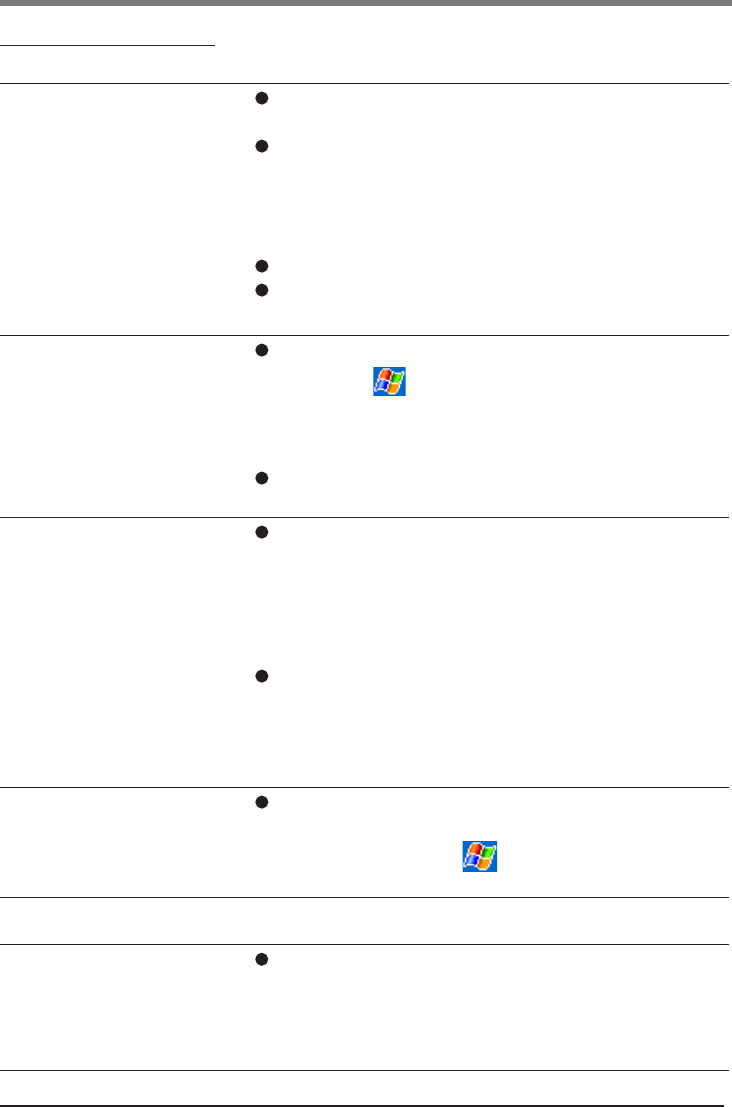
62
Dealing with Problems
Troubleshooting
Starting Up
Check to see if a fully charged battery pack is properly
installed.
The power does not go on unless the Fast Travel Charger
is connected:
The battery level is too low. Charge the battery with the
Fast Travel Charger. (Make sure that the battery never
discharges completely and that it is charged periodically.)
Push the reset switch to restart CF-P2.
If the power does not turn on when the above operations
are performed, the battery pack must be replaced.
You can set the date and time through [Clock &
Alarms] in - [Settings] - [System] tab.
If you continue to experience problems, the backup
battery maintaining the clock may need to be replaced.
Contact Panasonic Technical Support.
This computer will not correctly recognize the date
and time starting from the year 2085 A.D.
The battery level may be too low. If the battery level
goes below a certain threshold, CF-P2 automatically shuts
down. In such cases, connect the Fast Travel Charger
and charge the battery. (After the Fast Travel Charger is
connected to CF-P2, it may take a maximum of 20 min-
utes before CF-P2 can be turned on.)
The computer may have entered a locked state. If this is
the case, connect the Fast Travel Charger and push the
reset switch. Check the remaining battery level and make
sure that multiple applications are not running simulta-
neously. Close all applications that are not being used.
The computer may be turned off automatically when us-
ing File Explorer. To prevent this, change the time set-
ting to a longer time in - [Settings] - [System] tab -
[Power] - [Advanced] tab.
CF-P2 does not turn on.
Or, there is no display
when CF-P2 is turned on.
The date and time are in-
correct.
CF-P2 shuts down auto-
matically.
The data cannot be copied.
The computer locks up
during the execution of an
application, or the execu-
tion speed becomes notice-
ably slower.
Application Software
Connect the Fast Travel Charger and push the reset
switch. Check the remaining battery level and make sure
that multiple applications are not running simultaneously.
Close all applications that are not being used.
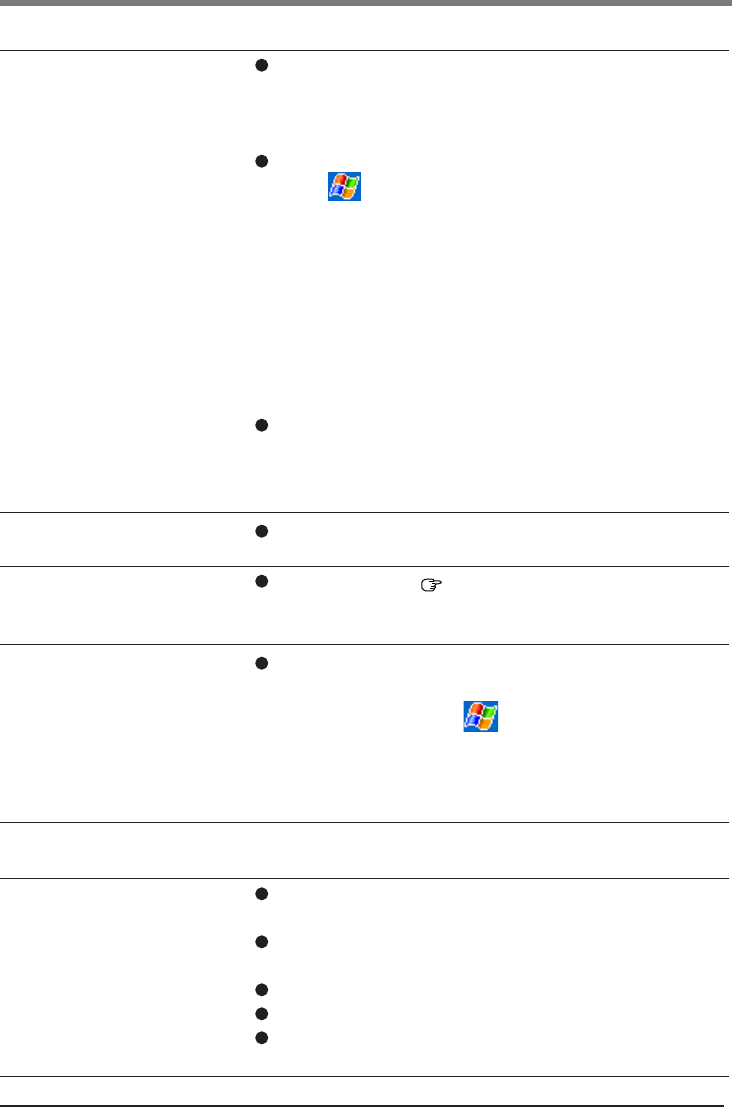
63
Dealing with Problems
Display
The LCD backlight may have automatically turned off
due to the power-saving function. Turn on the LCD back-
light by holding down the power switch until the back-
light goes on.
Adjust the backlight brightness.
1
Tap - [Settings] - [System] tab - [Backlight].
2
Tap the [Brightness] tab and adjust the brightness with
the slider.
Move the upper slider to select the LCD backlight bright-
ness level. By using the lower slider, you can make mi-
nor adjustments when LCD backlight has been auto-
matically dimmed.
You can not adjust the brightness while automatic back-
light settings are used. Remove the check marks from
[Advanced] tab and adjust the brightness with the slider.
When the CF-P2 is operated under battery power, if the
remaining battery power is low, the backlight will dim.
At that time, connect the Fast Travel Charger and re-
charge the battery.
Push the reset switch to restart.
Align the screen ( page 18).
Enable the Microsoft® ActiveSync® connection, and syn-
chronize CF-P2 with the host computer. If this situation
occurs frequently, tap - [ActiveSync] - [Tools] -
[Options] - [PC] tab to remove the check mark from [Use
mobile schedule to sync with this PC] and reset.
It is hard to view the LCD.
The cursor cannot be con-
trolled.
The cursor does not prop-
erly correspond to a stylus
tap.
Even when the CF-P2’s
power is switched off, only
the power to the LCD turns
off, but the power to the
main unit remains on (in-
put from the keyboard is
still possible).
A host computer does not
recognize CF-P2.
Confirm that Microsoft® ActiveSync® 3.7 (or a later ver-
sion) has been installed in the host computer.
Check to see if a fully charged battery pack is properly
installed to CF-P2.
Confirm that CF-P2’s power is on.
Push the reset switch to restart.
If a cable is being used for the connection, recheck the
connection to the host computer.
Connecting a Host PC
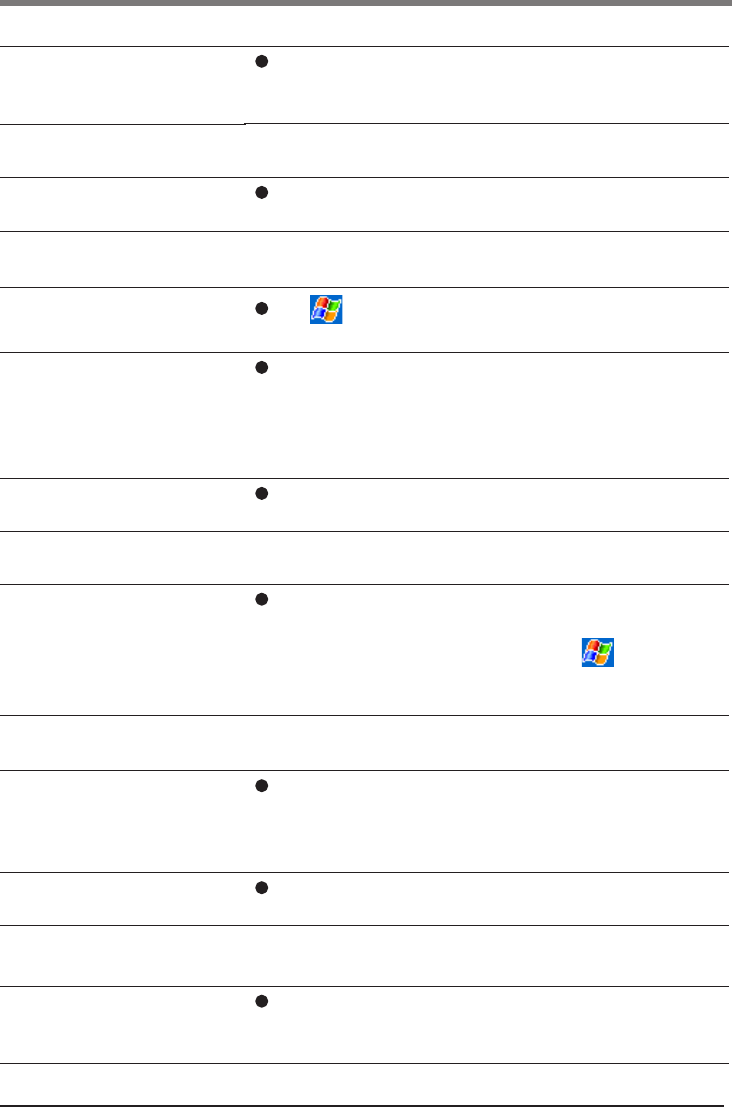
64
Sounds
Program Buttons
When the program display of a start menu is changed
after assigning a program, if you press a button, that pro-
gram may not start. In that case, tap - [Settings] -
[Personal] tab - [Buttons] - [Program Buttons] tab, and
re-assign the program.
The program assigned to
the button does not start.
Quality of recorded sound
is poor.
Noise in recording or play-
back sound.
A music file cannot play
back.
Tap - [Settings] - [Personal] tab - [Input] - [Options] tab
- [Voice recording format], and select a higher frequency.
If a load is applied during recording or playback, for
example when the SD Memory Card is disconnected or
connected, then noise in the recording or playback will
result. In this event, stop the recording or playback, and
restart after closing other applications.
Some music files may not be able to play back.
Dealing with Problems
Peripheral is not recog-
nized even after driver is
installed.
Connecting Peripherals
Remove cards or other peripherals, and push the reset
switch.
Cannot connect to the net-
work.
Check the server information and network settings.
Network
Phone
When the remaining power in the battery discharges, the
Phone function may turn off suddenly. (In this case,
“Phone function is disabled. Please re-charge the bat-
tery.” is displayed.)
If the Volume Up/Down Button is pressed while the
phone is ringing, the phone ringer will stop.
Phone function is dis-
abled automatically.
The phone ringer stops.
Bluetooth
Turn the Bluetooth function off and then turn it on again.
If this function still does not work properly, reset the
CF-P2 and turn the Bluetooth on.
When connection or
communication with
Bluetooth is not smooth.
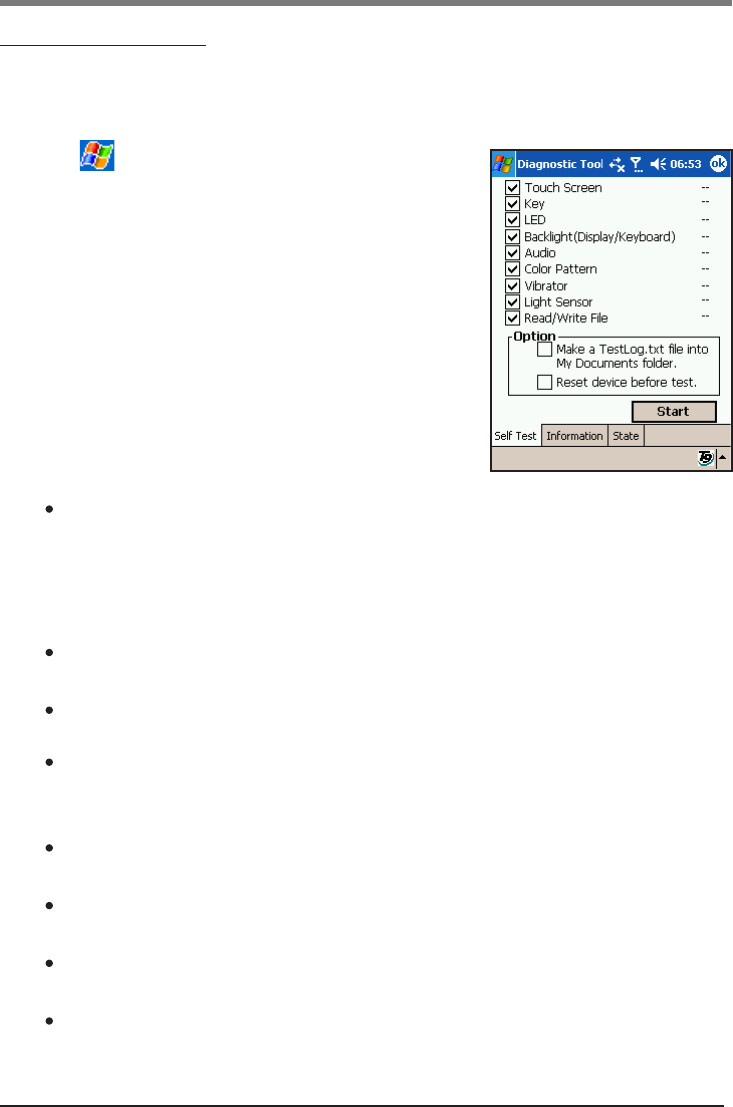
65
Dealing with Problems
Diagnostic Tool
You can use the Diagnostic Tool to check the CF-P2’s usage status, and use this informa-
tion when calling your technical support office for advice.
1
Start the Diagnostic Tool.
Tap - [Programs] - [Diagnostic Tool] - [Self Test]
tab.
The screen shown at the right will be displayed.
2
Add the check mark for the item you want to
check.
[Option]: If you add the check mark for [Make a
TestLog.txt file into My Documents folder], the check
result is output to the file. If you add the check mark
for [Reset device before test], CF-P2 will reset be-
fore starting the check.
The following items will be checked.
Touch Screen
No deviation between display coordinates and stylus coordinates.
•Key
Hardware buttons are functioning properly. Numeric keypad is functioning prop-
erly.
LED
Three LEDs are flashing or lit (confirm each LED).
Backlight
LCD backlight and keyboard backlight control.
Audio
System alarm sounds correctly. Sound is recorded correctly from the microphone,
and played back from the receiver or speaker.
Color Pattern
Color patterns are displayed correctly.
Vibrator
Vibrator operates correctly.
Light Sensor
Light sensor operates correctly.
Read/Write File
Files are read and written correctly (RAM/SD/Flash).
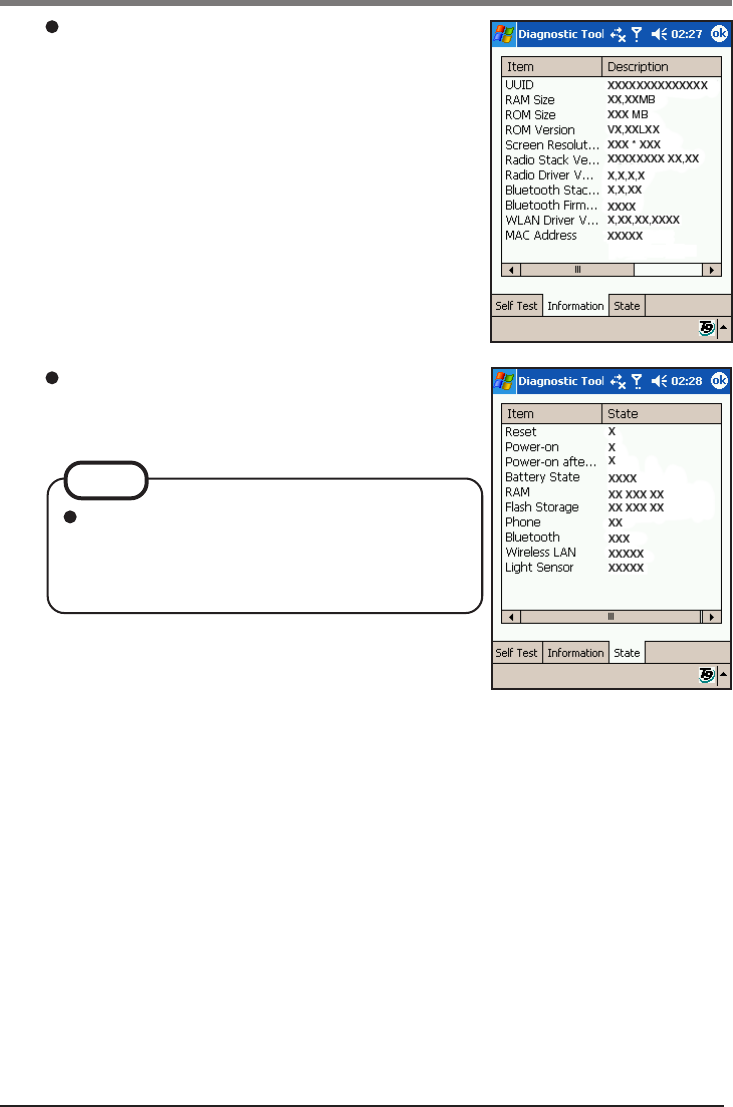
66
Dealing with Problems
Tap [Information] tab.
The device information is displayed.
Tap [State] tab.
Information indicating the CF-P2’s usage status is
displayed.
3
Tap [Self Test] tab - [Start].
Each item is checked in order; when the check is complete, CF-P2 is automatically
reset.
Status information is given before the Diagnos-
tic Tool starts. If the status has been changed
since the Diagnostic Tool was turned on, the
change will not be displayed.
NOTE
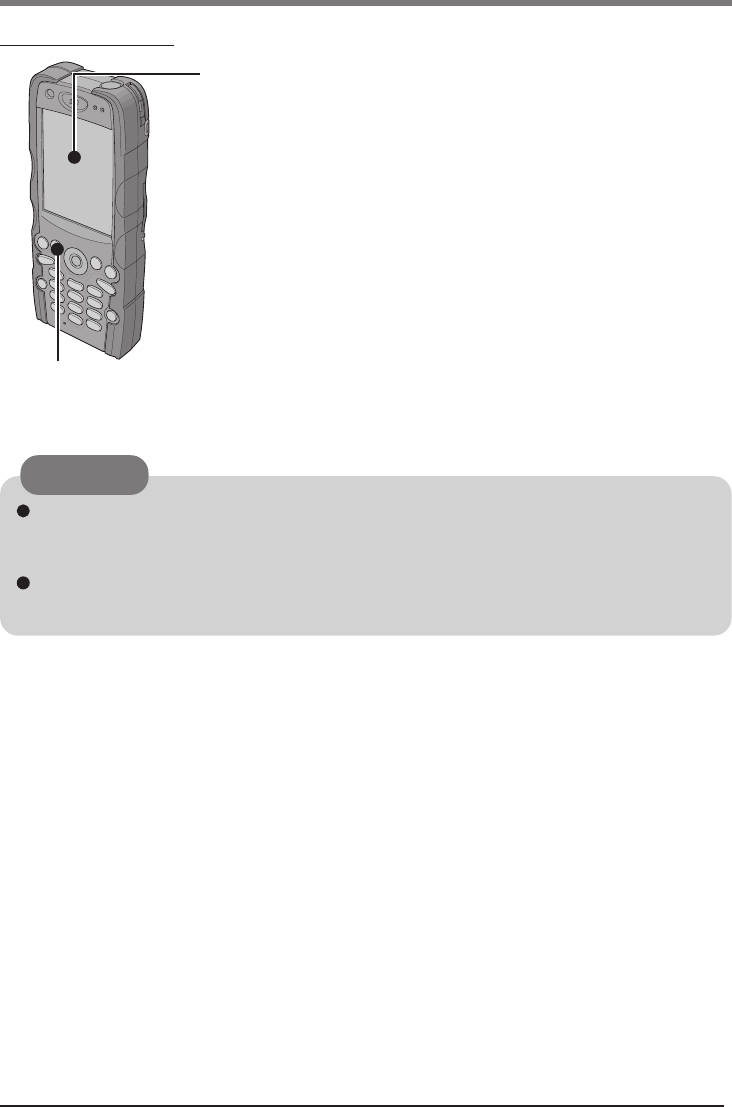
67
Maintenance
LCD
Do not use water when cleaning the panel. Ingredients included in
water may leave residue and reduce readability of the screen.
Do not use benzene, thinner, or rubbing alcohol. Doing so may adversely affect the
surface, e.g., discoloration. In addition, do not use commercially-available household
cleaners and cosmetics, as they may contain components harmful to the surface.
Do not directly add or spray water or detergent. If liquid enters the inside of the
computer, it may cause the computer to work improperly or be damaged.
<When cleaning dust/dirt>
Avoid rubbing off dust/dirt with cloth since it may leave scratch
on the screen.
Sweep dust/dirt with fine brush, then wipe it with “dry” soft
cloth used for cleaning glasses.
<When cleaning oily surface>
Apply camera lens cleaner on a soft gauze and clean it with
gentle force. Then, wipe with dry soft cloth used for cleaning
glasses.
CAUTION
Areas excluding the LCD
Wipe these areas with a soft cloth, after applying water or detergent diluted with water to the
soft cloth and firmly wringing out excess water.
For Effective Use
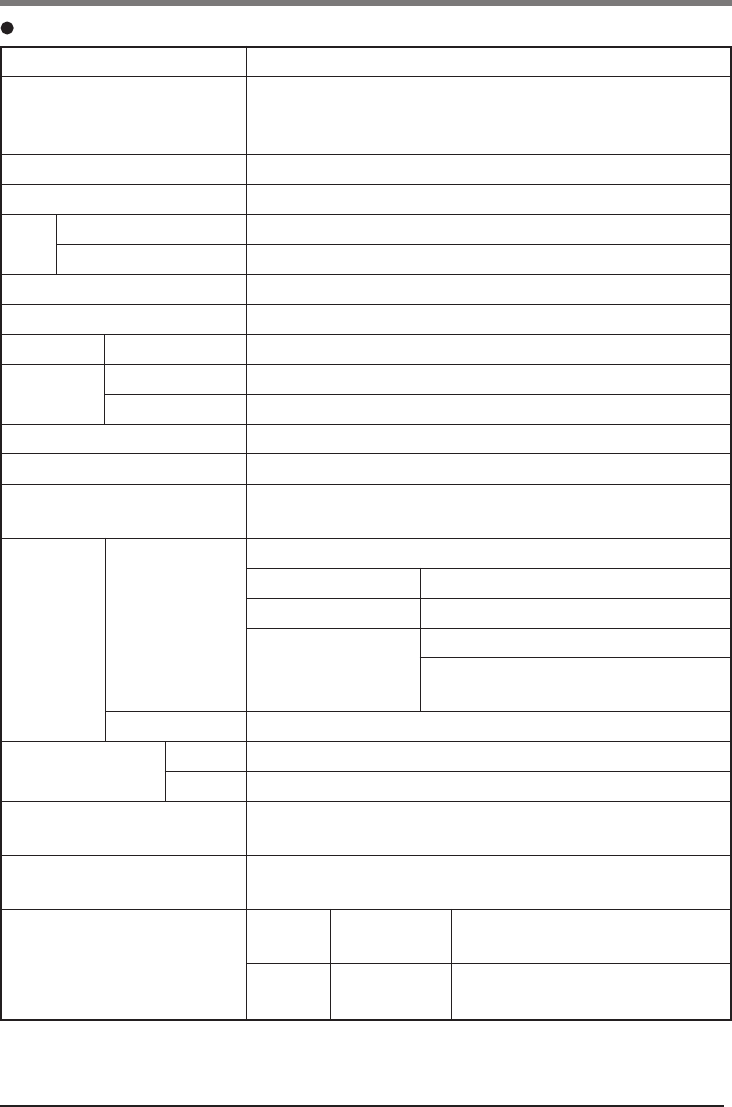
68
CF-P2T1FDF7E
Intel® PXA270, 312 MHz
Instruction Cache Memory: 32 KB
Data Cache Memory: 32 KB
64 MB / 128 MB (Flash)
150 KB
2.83 QVGA type (Transflective color TFT with backlight)
65536 colors (240 x 320 dots)
Touchscreen, Cursor Control
SD Memory Card/SDIO card/MultiMedia Card
Miniature jack, 2.5 DIA
USB 1.1, 12Mbps
Monaural Speaker
Built-in for supporting as Mobile Phone
16-bit Stereo ADC/DAC, Sample Rate 48 kHz
(When using a stereo headset)
Li-ion 3.6 V, 1.95 Ah
Operating Time*1Approx. 8 hours - 12 hours
Talk Time*1Approx. 4 hours (Backlight Off)
(Power Off) Approx. 4 hours
Charging Time*1(Power On) Varies depending on
the usage conditions.
Ni-MH Rechargeable Backup Battery
100 V - 240 V AC, 50 Hz/60 Hz
5.8 V DC, 0. 7A
Approx. 3.7 W*3 / Approx. 5 W (maximum when re-
charging in the ON state)
Microsoft® Windows MobileTM 2003 Second Edition
software for Pocket PC, Premium with Phone Edition
Operation
Temperature 5 °C to 35 °C {41 °F to 95 °F}
Humidity
30 % to 80 %RH (No condensation)
Storage Temperature -20 °C to 60 °C {-4 °F to 140 °F}
Humidity
30 % to 90 %RH (No condensation)
*1Varies depending on the usage conditions, backlight on/off, etc.
*2Approx. 0.3 W when the battery pack is fully charged (or not being charged) and the computer is off.
*3Rated power consumption.
Model No.
CPU
Memory (RAM/ROM)
Video Memory
LCD Type
Displayed Colors
Keyboard
Pointing Device
Slots
Interface
Speaker
Microphone/Receiver
Sound
Battery Battery Pack
Sub-Battery
Fast Travel
Charger
Power Consumption*2
Operating System
Environment
Specifications
SD Card Slot
Headset Jack
USB Host
20-key numeric keypad
Input
Output
Main Specifications
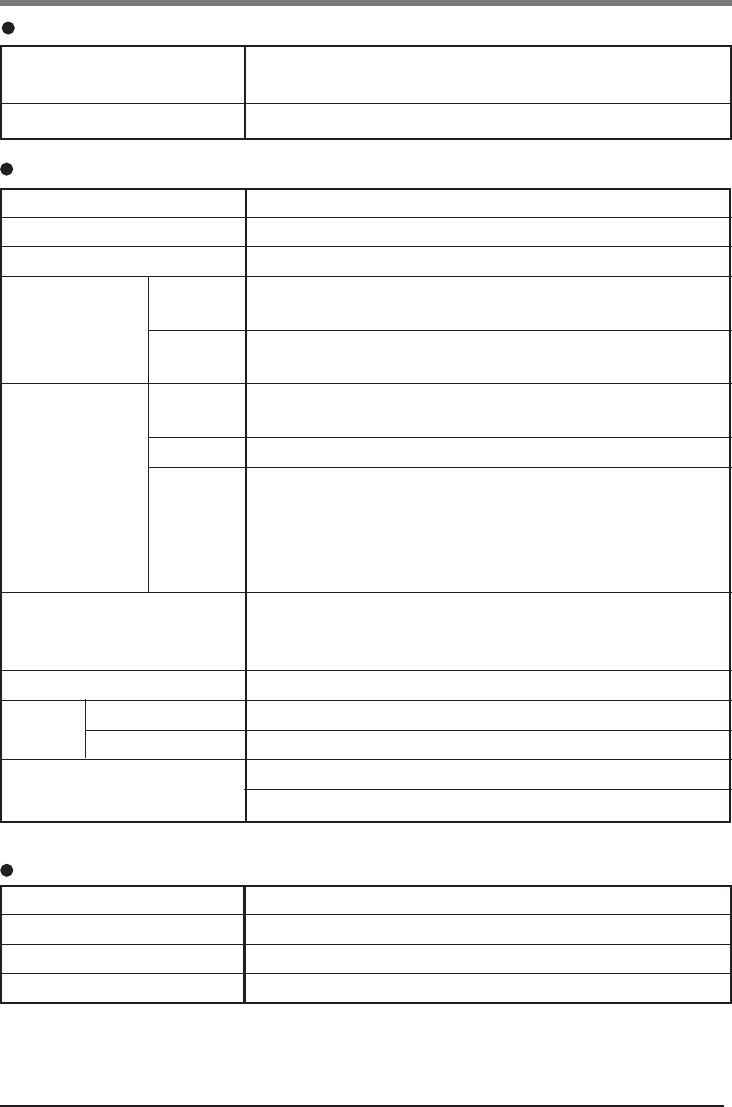
69
Compliant with ETSI GSM phase 2/2+ standard
EGSM850 Class 4 (2 W) / DCS1900 Class 1 (1 W)
Internal SIM card (3 V only)
EGSM850 (824 MHz to 849 MHz) / DCS1900 (1850
MHz to 1910 MHz)
EGSM850 (869 MHz to 894 MHz) / DCS1900 (1950
MHz to 1990 MHz)
Non-transparent
2400 bps/ 4800 bps / 9600 bps / 14400 bps
Facsimile group 3, Class 2
MT/PP (Mobile Terminating Short Message Service,
Point to Point)
MO/PP (Mobile Originating Short Message Service,
Point to Point)
CB (Cell Broadcast Short Message Service)
HR (Half rate)
FR (Full rate)
EFR (Enhanced full rate)
AT Commands (GSM 07.07)
Class 10
Class B
900 MHz : TBD W/kg
1800 MHz : TBD W/kg
Specifications
GSM/GPRS
Main Specifications
58 mm x 20 mm x 145 mm {2.4" x 0.9 " x 5.8 "}
Approx. 199 g {Approx. 0.4 lb.}
Physical Dimension
(W x H x D)
Weight
Type
Class
SIM
RF Transmit
Specification
Receive
Data Features Data
Fax
SMS
Voice Feature
Interface
GPRS Multi-Slot
Mobile Station
SAR
(
Specific Absorption Rate
)
Bluetooth
Bluetooth Version 1.2
Transmission Method FHSS system
Wireless Channels Used Channels 1 to 79
RF Frequency Band 2.402-2.48 GHz

70
Specifications
Wireless LAN
Standards Compliance IEEE802.11b compliant, Frequency 2.4 GHz band
Communication Protocol
Direct Sequence Spread Spectrum (DS-SS), Half
Duplex
Frequency Range 2.412-2.462 GHz (1-11ch)
Transmission Rate 1, 2, 5.5, 11 Mbps
Media Access Protocol CSMA/CA
Access Mode Infrastructure mode, Ad-Hoc
Security 128/64 Bit WEP and WPA support
802.1x Authentification EAP-PEAP, EAP-TLS

71
Microsoft® ActiveSync® 3.7 System Requirements
Microsoft® Windows® XP, Microsoft® Windows® 2000, Microsoft® Windows® Millennium Edition, Microsoft®
Windows NT® Workstation 4.0 with SP6 or later, or Microsoft® Windows® 98
Microsoft® Outlook® 98 or later required for synchronization to the desktop or portable computer of e-mail,
calendar, contacts, tasks, and notes. (Microsoft® Outlook® 2002 recommended)
Microsoft® Internet Explorer 4.01 SP1 or later
Hard-disk drive with 12 to 65 MB of available hard-disk space (actual requirements will vary based on selection
of features and user's current system configuration)
Available USB port (available for Windows® 98, Windows® Millennium Edition, Windows® 2000, and Win-
dows® XP only)
One CD-ROM drive
VGA graphics card or compatible video graphics adapter at 256 color or higher
Keyboard
Microsoft® Mouse or compatible input device
Options for Windows® XP, Windows® 2000, Windows® Millennium Edition, Windows NT® Workstation
4.0, or Windows® 98
Audio card/Speakers for sound
Microsoft® Office 97, Microsoft® Office 2000, or Microsoft® Office XP
Modem for remote synchronization
Ethernet LAN connection for remote synchronization
RAM requirements depend on the operating system used:
Windows® 98, or Windows® 98 Second Edition
24 MB of RAM plus an additional 8 MB of RAM for each Office program running simultaneously
Windows® Millennium Edition, or Microsoft® Windows NT®
32 MB of RAM plus an additional 8 MB of RAM for each Office program running simultaneously
Windows® 2000 Professional
64 MB of RAM plus an additional 8 MB of RAM for each Office program running simultaneously
Specifications

Copyright
This manual is copyrighted by Matsushita Electric Industrial Co., Ltd. with all rights reserved. No part
of this manual may be reproduced in any form without the prior written permission of Matsushita
Electric Industrial Co., Ltd.
No patent liability is assumed with respect to the use of the information contained herein.
©2004 Matsushita Electric Industrial Co., Ltd. All Rights Reserved.
Disclaimer
Computer specifications and manuals are subject to change without notice. Matsushita Electric Industrial
Co., Ltd. assumes no liability for damage incurred directly or indirectly from errors, omissions or
discrepancies between the computer and the manuals.
Trademarks
Microsoft®, Windows®, Windows NT®, Outlook® and ActiveSync® are registered trademarks of Microsoft
Corporation of the United States and/or other countries.
Windows Mobile™ is a trademark of Microsoft Corporation of the United States and/or other countries.
Intel® is registered trademarks of Intel Corporation.
T9® is a registered trademark of Tegic Communications, Inc.
Flash® is a registered trademark of Macromedia, Inc.
Bluetooth is a trademark owned by Bluetooth SIG, Inc., U.S.A. and licensed to Matsushita Electric Indus-
trial Co., Ltd.
Panasonic® is a registered trademark of Matsushita Electric Industrial Co., Ltd.
T9 Text Input is licensed under one or more of the following: U.S. Pat. Nos. 5,187,480,
5,818,437, 5,945,928, 5,953,541, 6,011,554, 6,286,064, 6,307,548, 6,307,549, and
6,636,162, 6,646,573; Australian Pat. Nos. 727539, 746674, and 747901; Canadian Pat.
Nos. 1,331,057, 2,302,595, and 2,227,904; Japan Pat. No. 3532780; United Kingdom Pat.
No. 2238414B; Hong Kong Standard Pat. No. HK1010924; Republic of Singapore Pat.
No. 51383, 66959, and 71979; European Pat. Nos. 0 842 463 (96927260.8), 1 010 057
(98903671.0), 1 018 069 (98950708.2); Republic of Korea Pat. Nos. KR201211B1 and
KR226206B1. People’s Republic of China Pat. Application Nos. 98802801.8, 98809472.X
and 96196739.0; Mexico Pat. No. 208141; Russian Federation Pat. No. 2206118; and
additional patents are pending worldwide.
T9® Text Input is a registered trademark of Tegic Communications, Inc.
End User is granted no rights of ownership or any other proprietary rights in or to the
Documentation and Tegic Product or any other software or technology of Tegic. End User
acknowledges that all ownership of and proprietary rights in and to the Documentation and
Tegic Product are vested in Tegic. End User shall not modify, reverse engineer, decompile
or disassemble the Tegic Product, or otherwise attempt to obtain source code for the Tegic
Product. The Documentation and Tegic Product are protected by the copyright laws of the
United States and international copyright treaties.